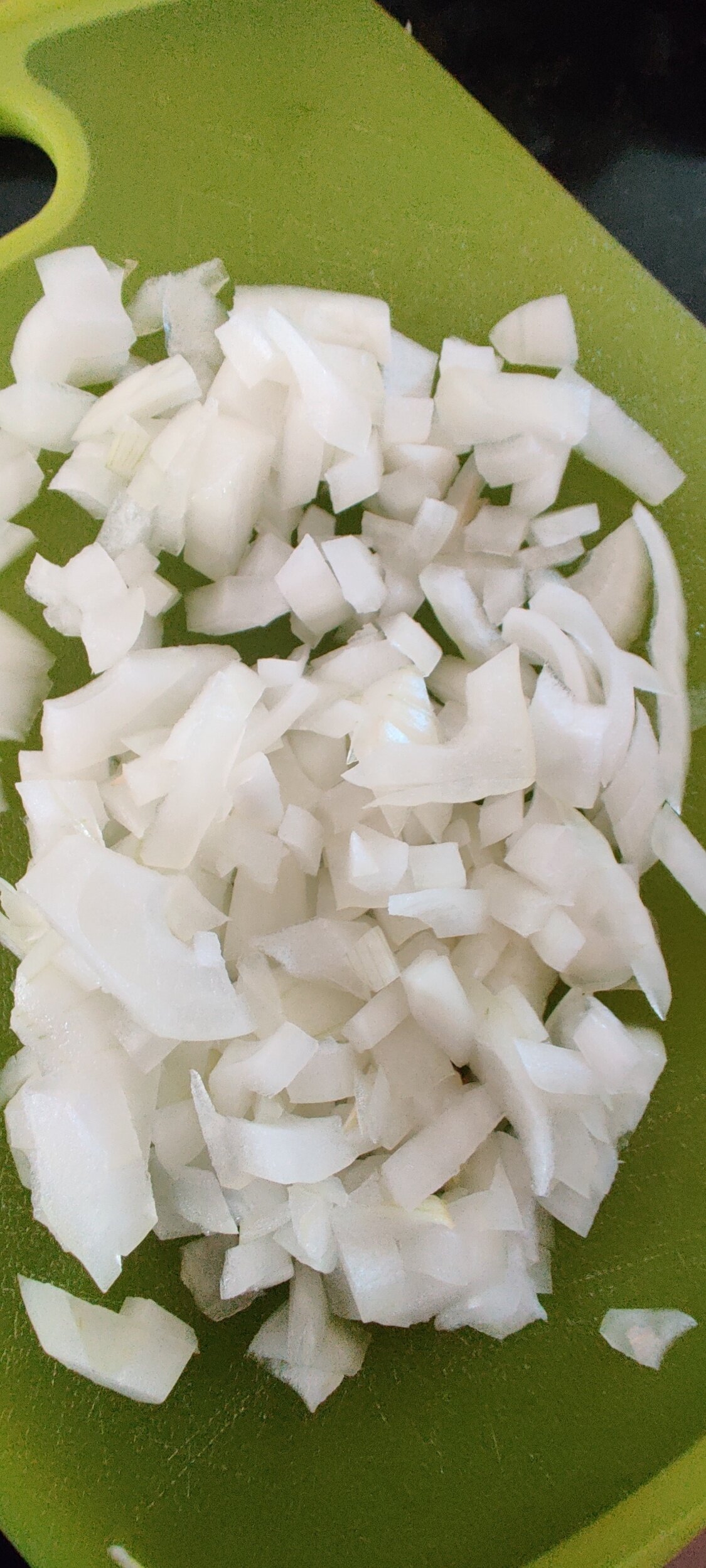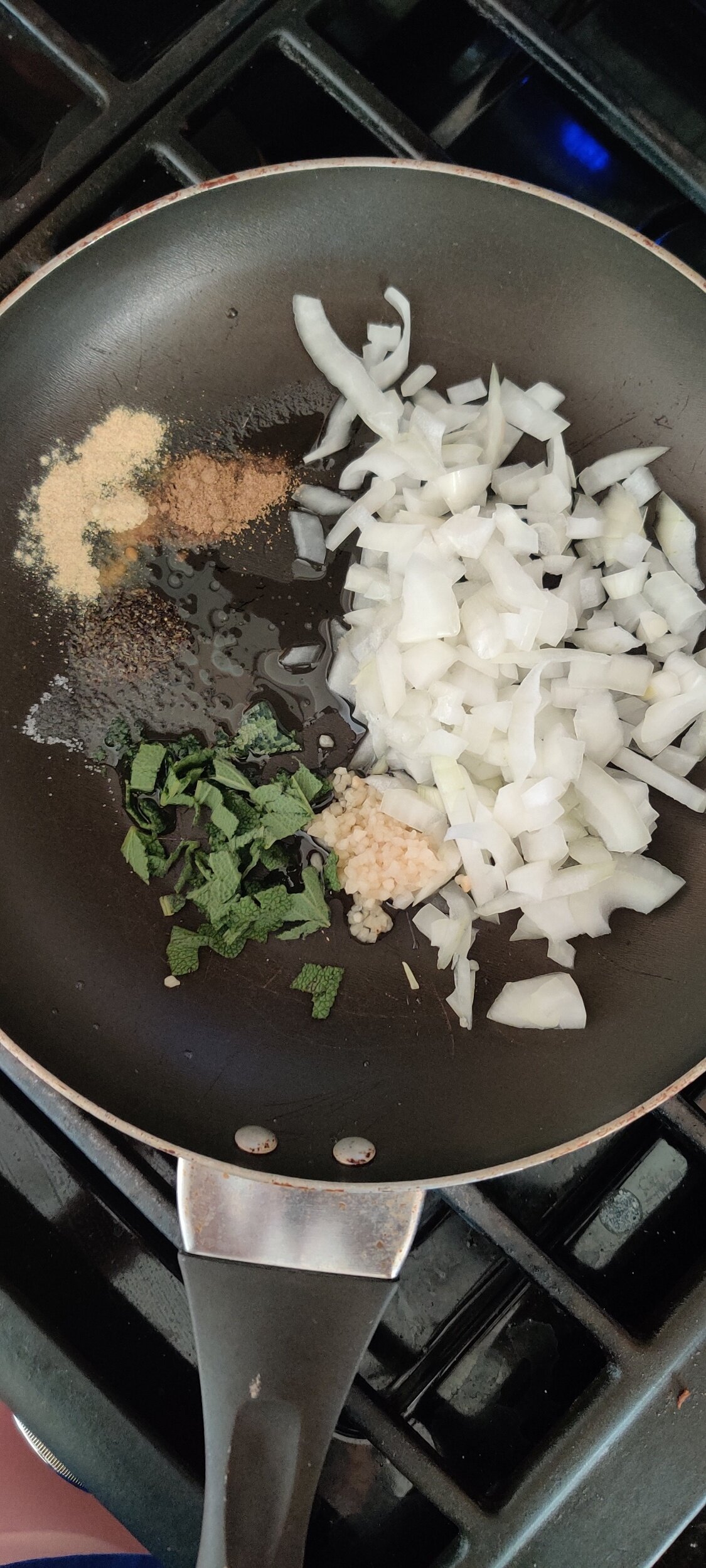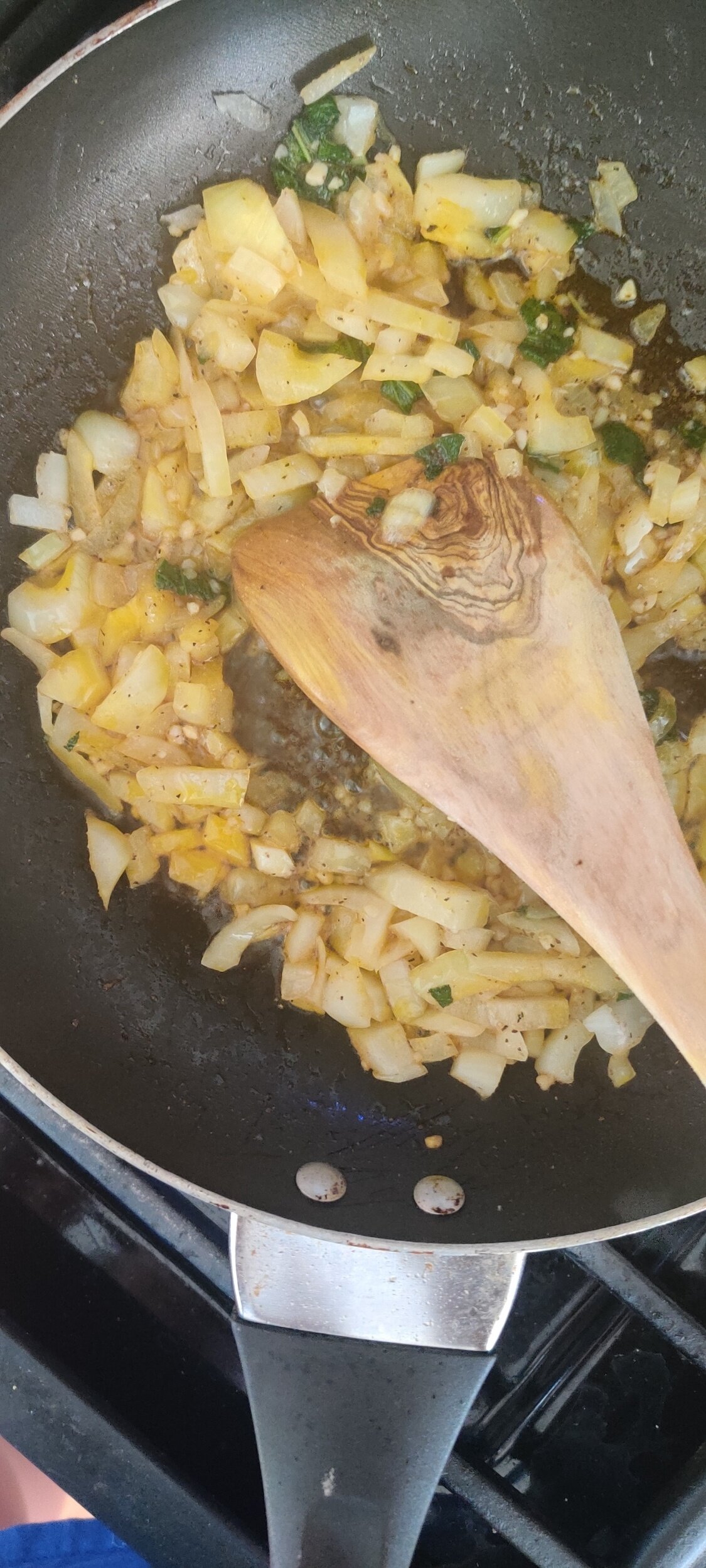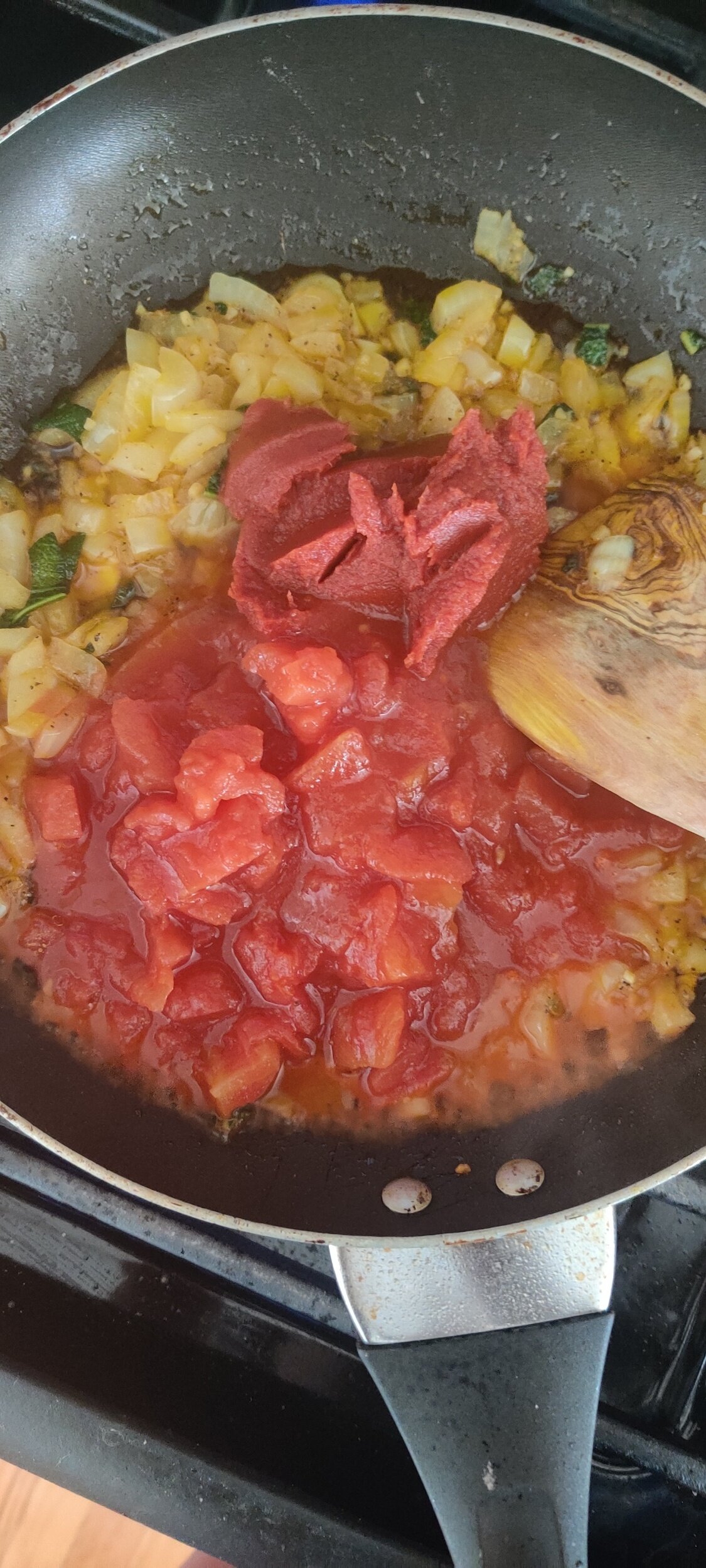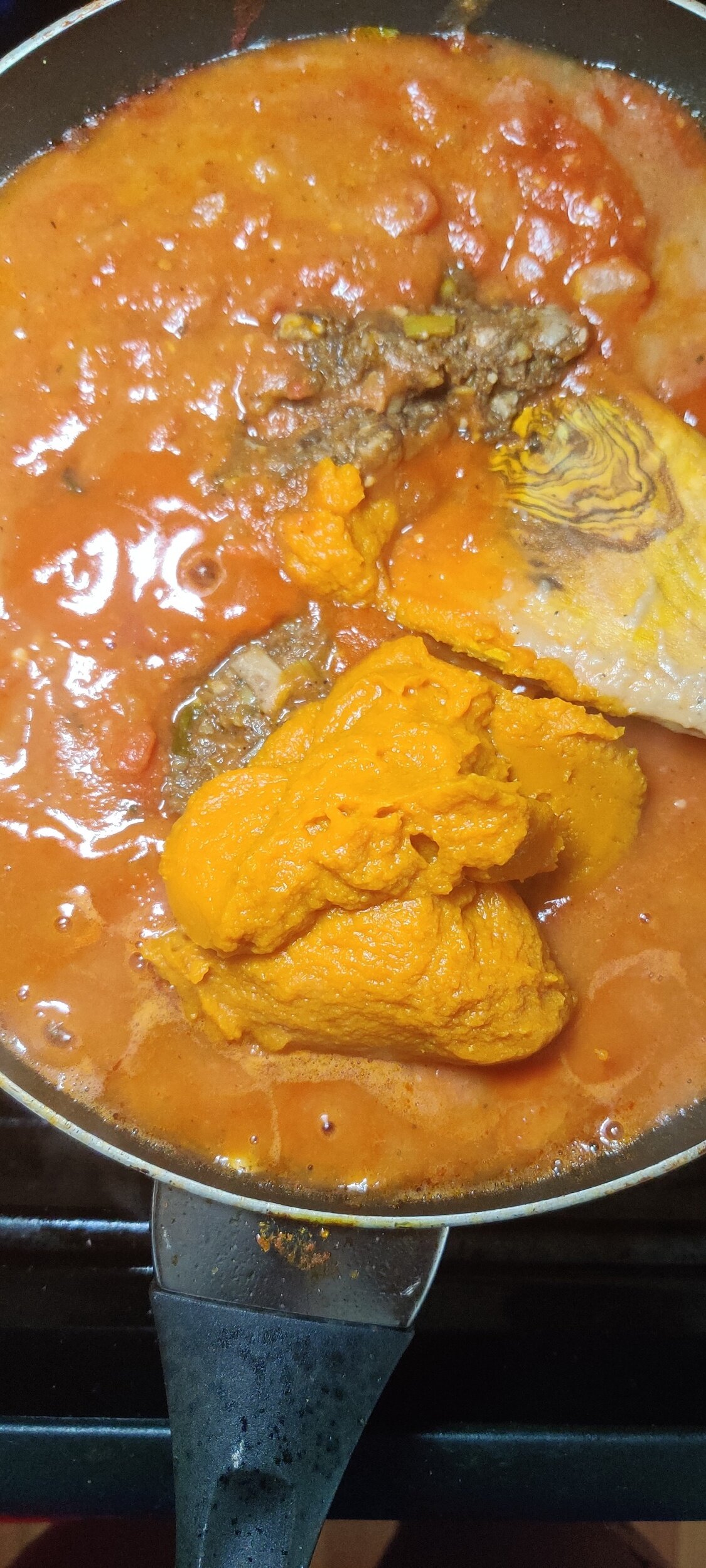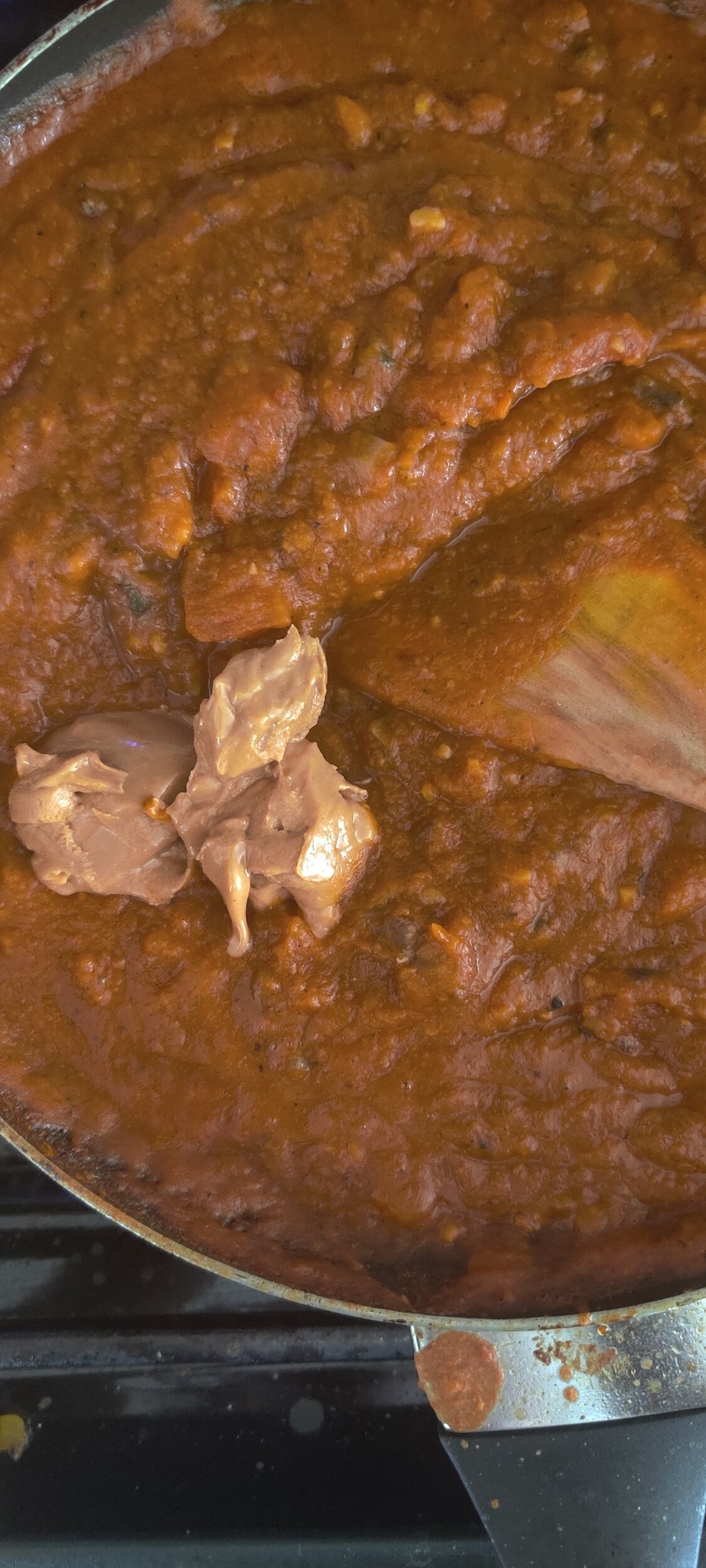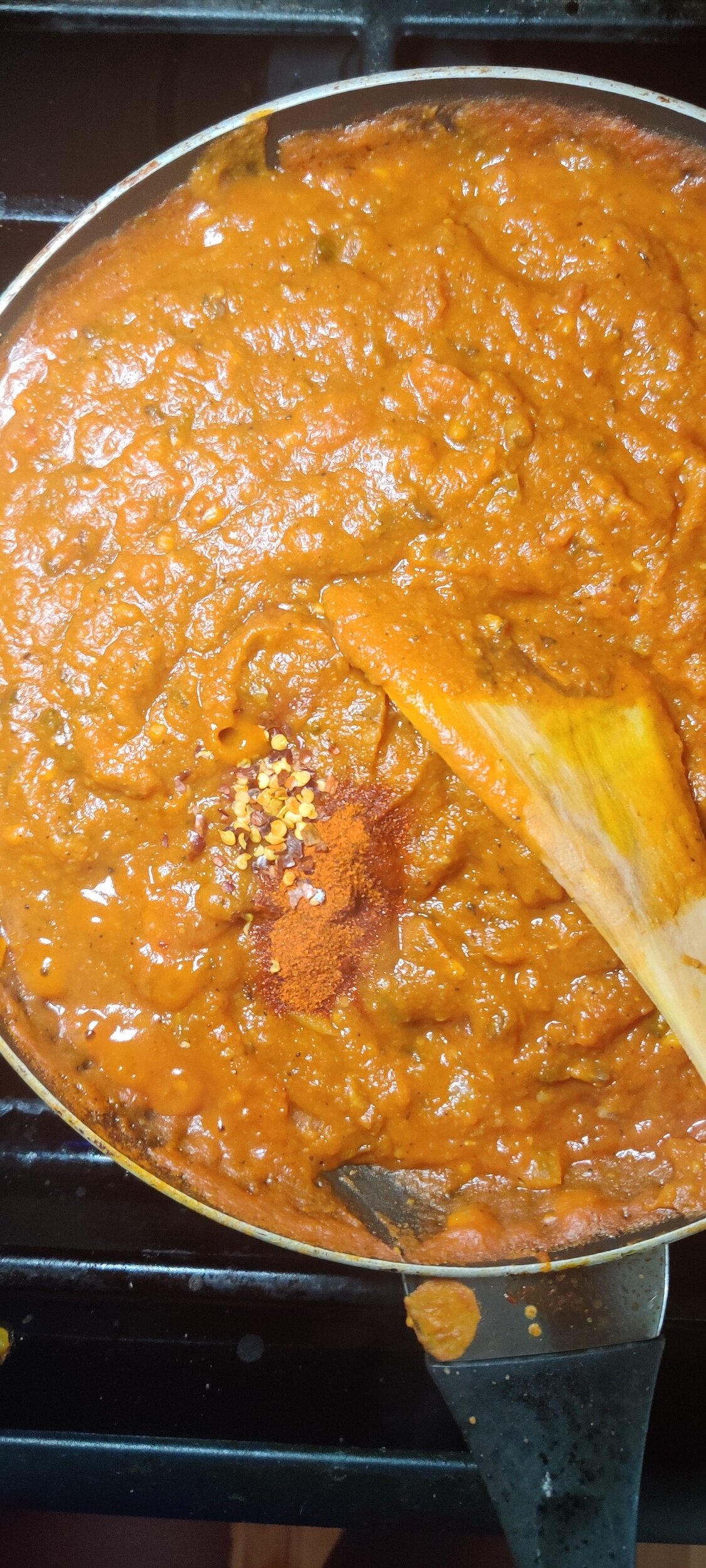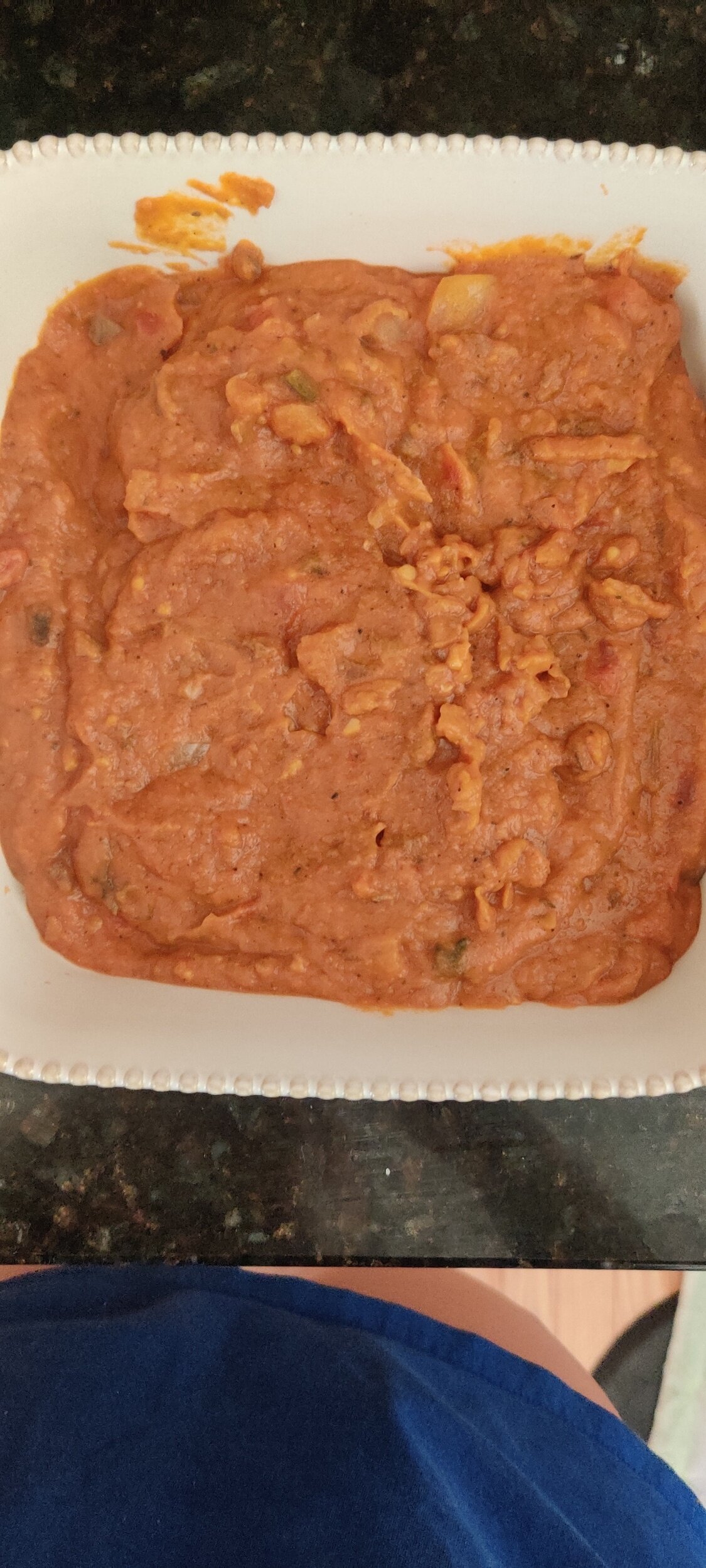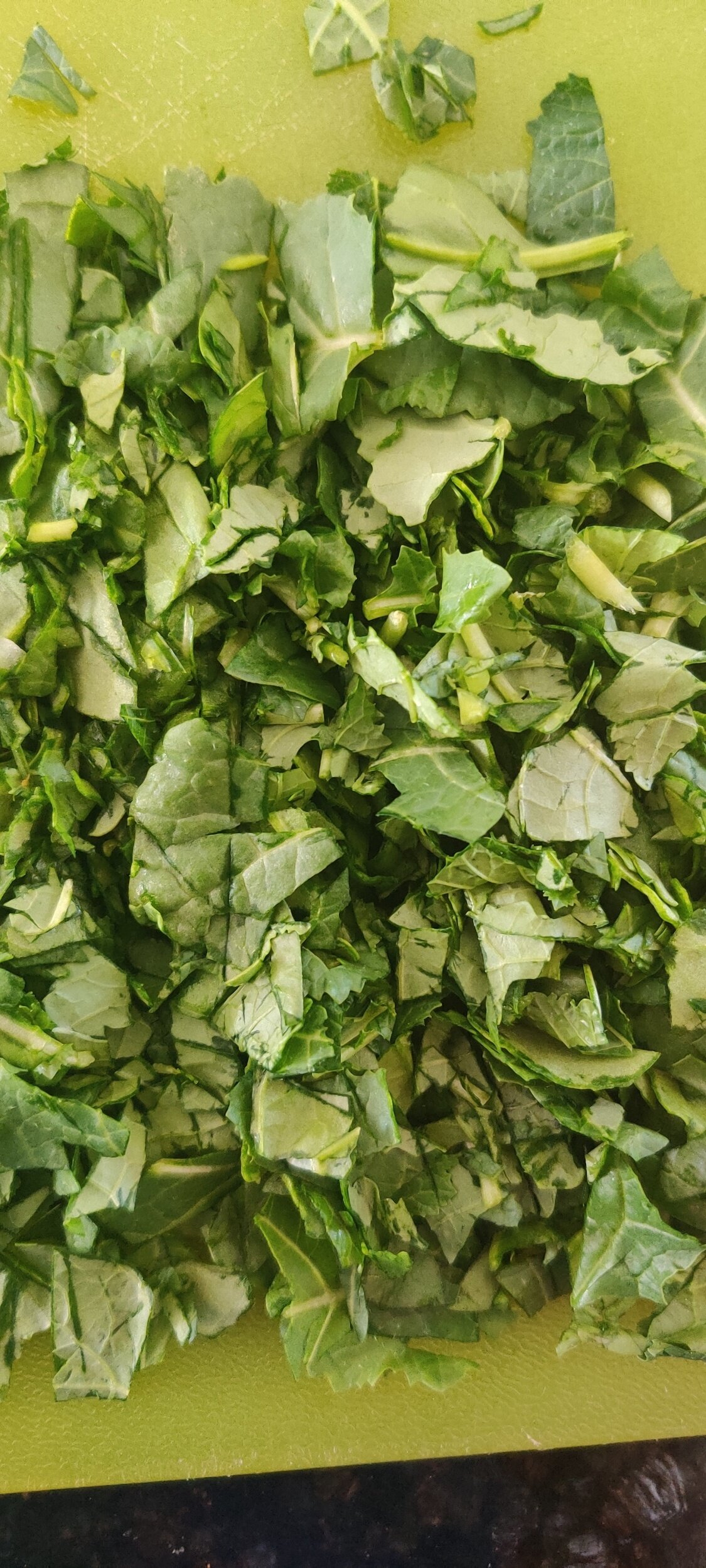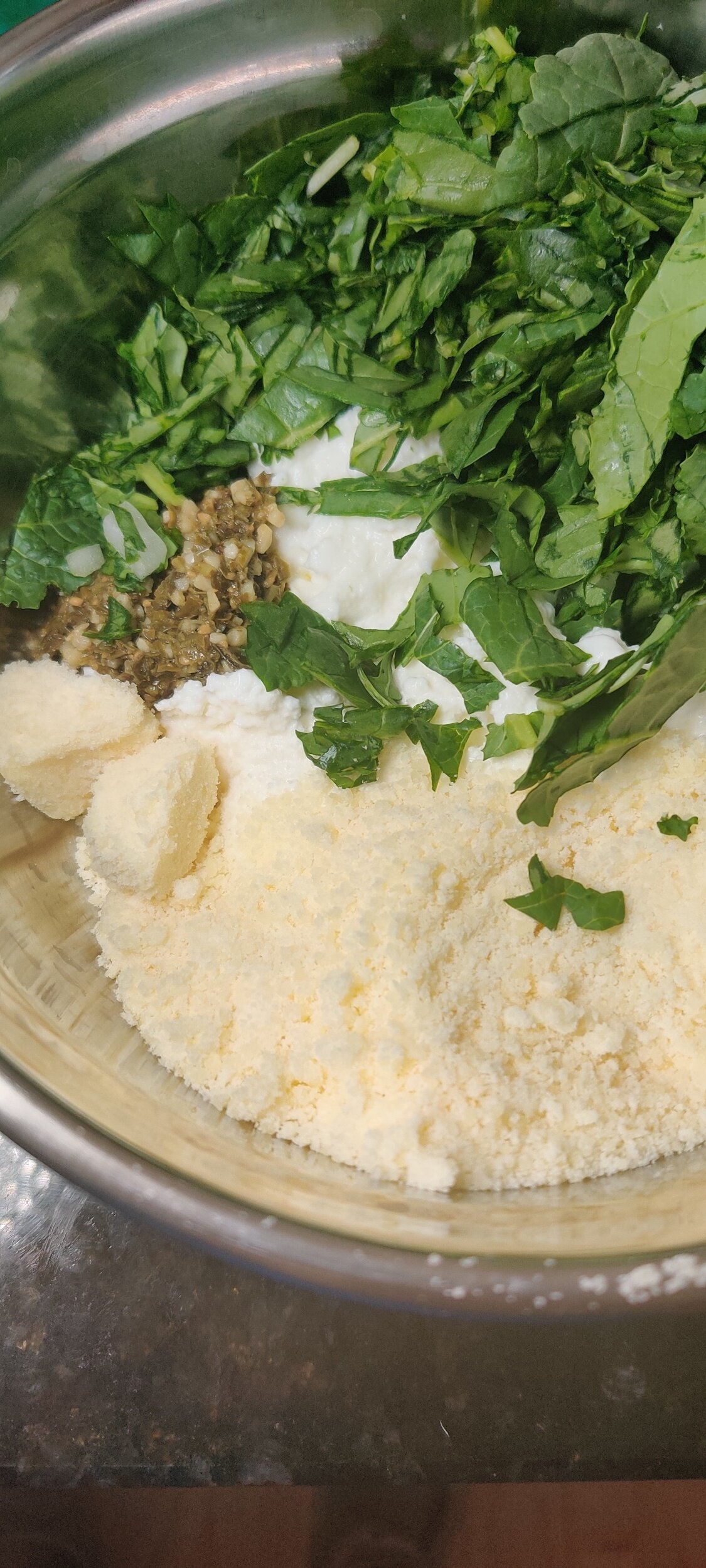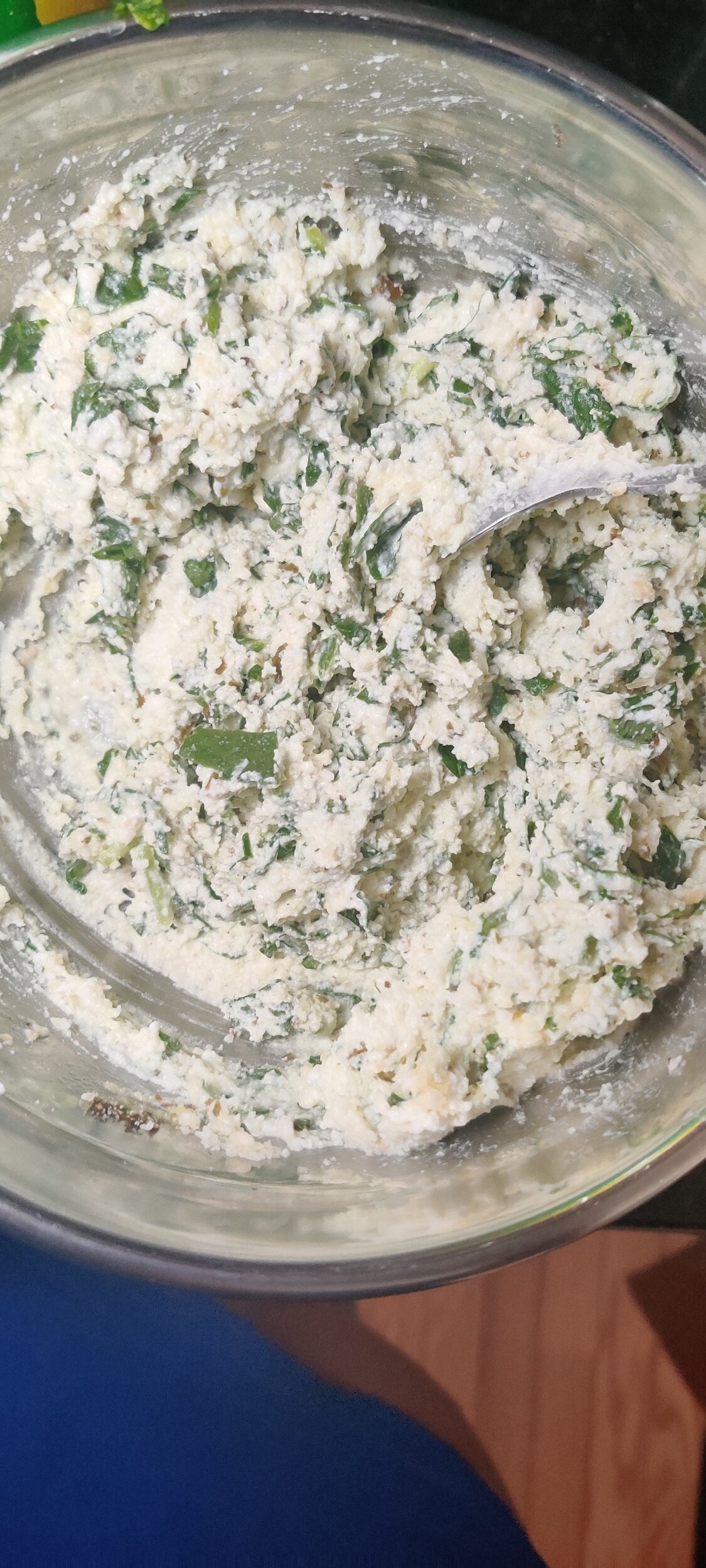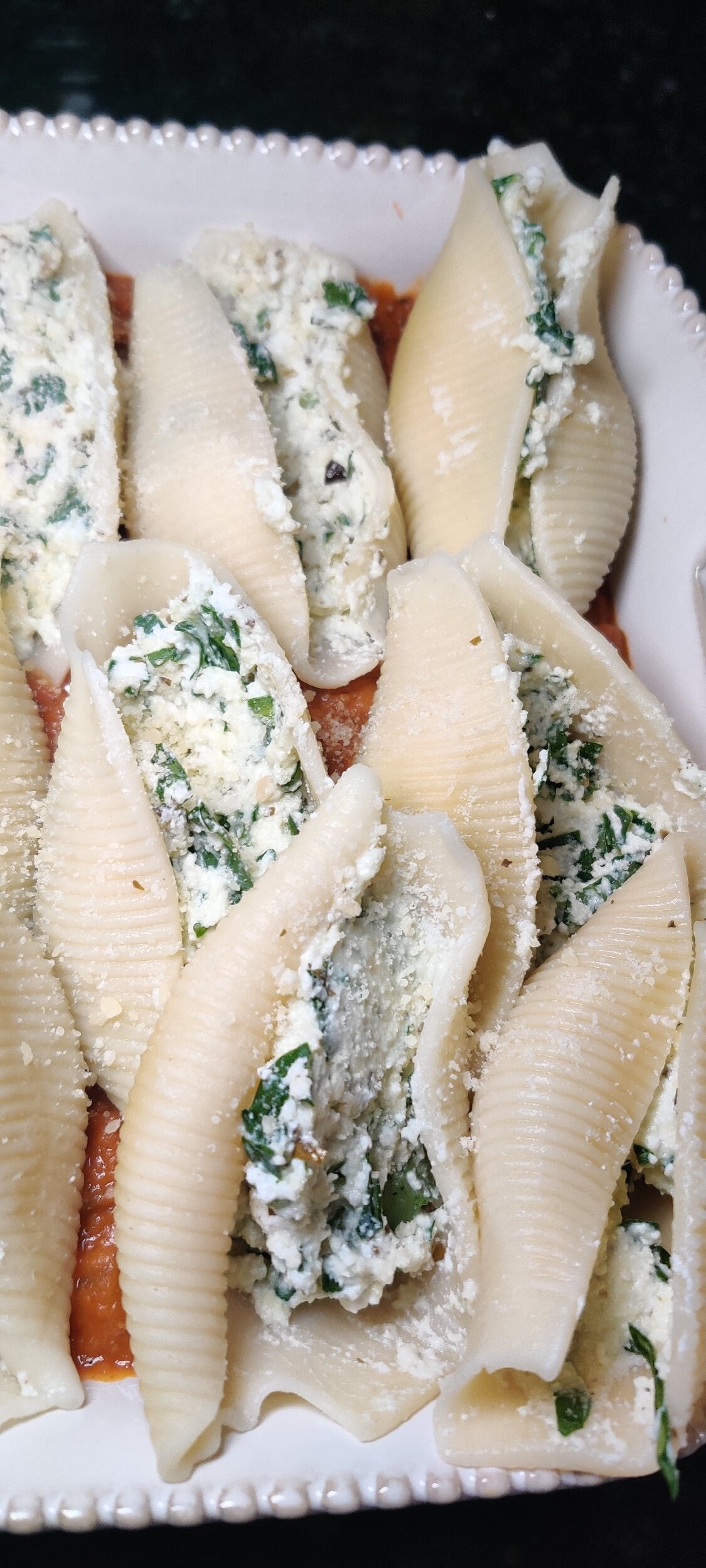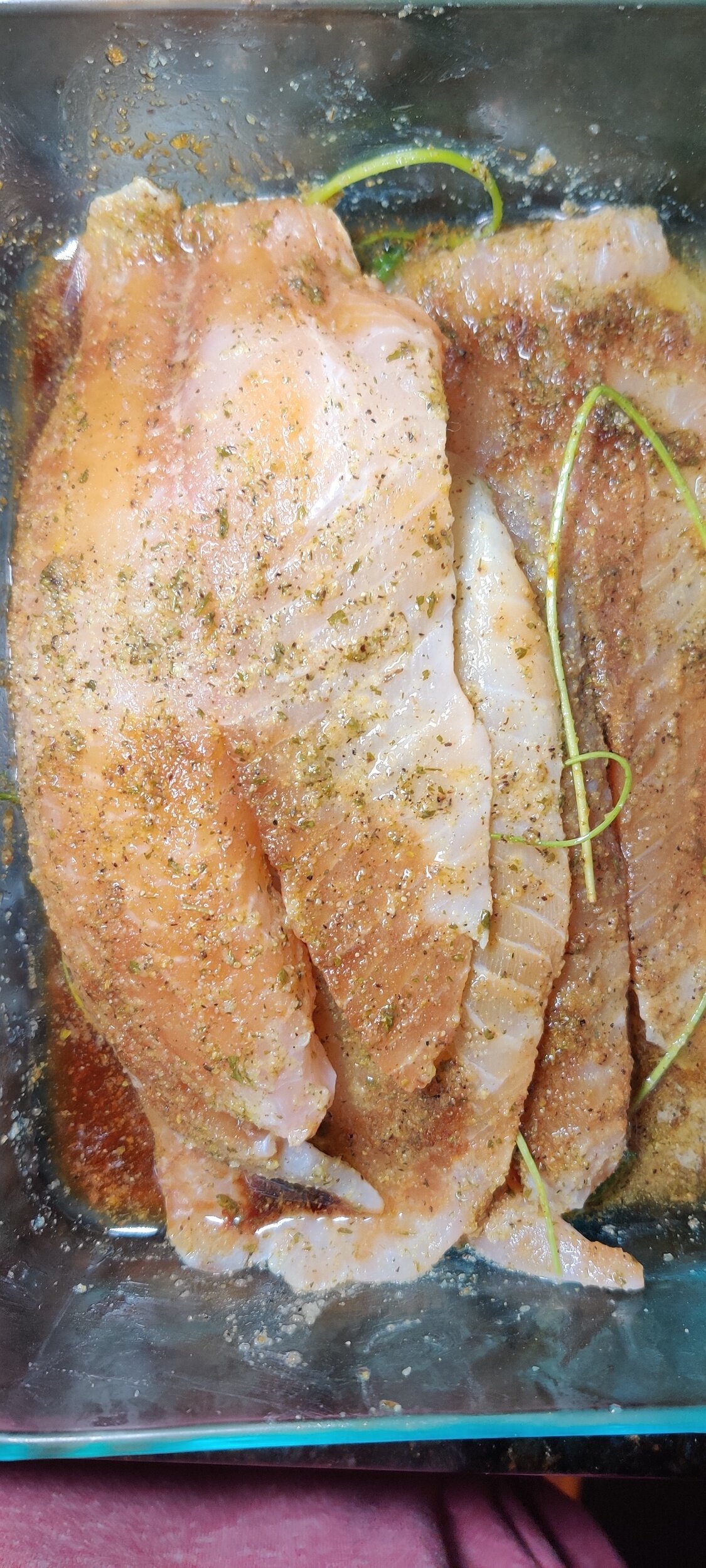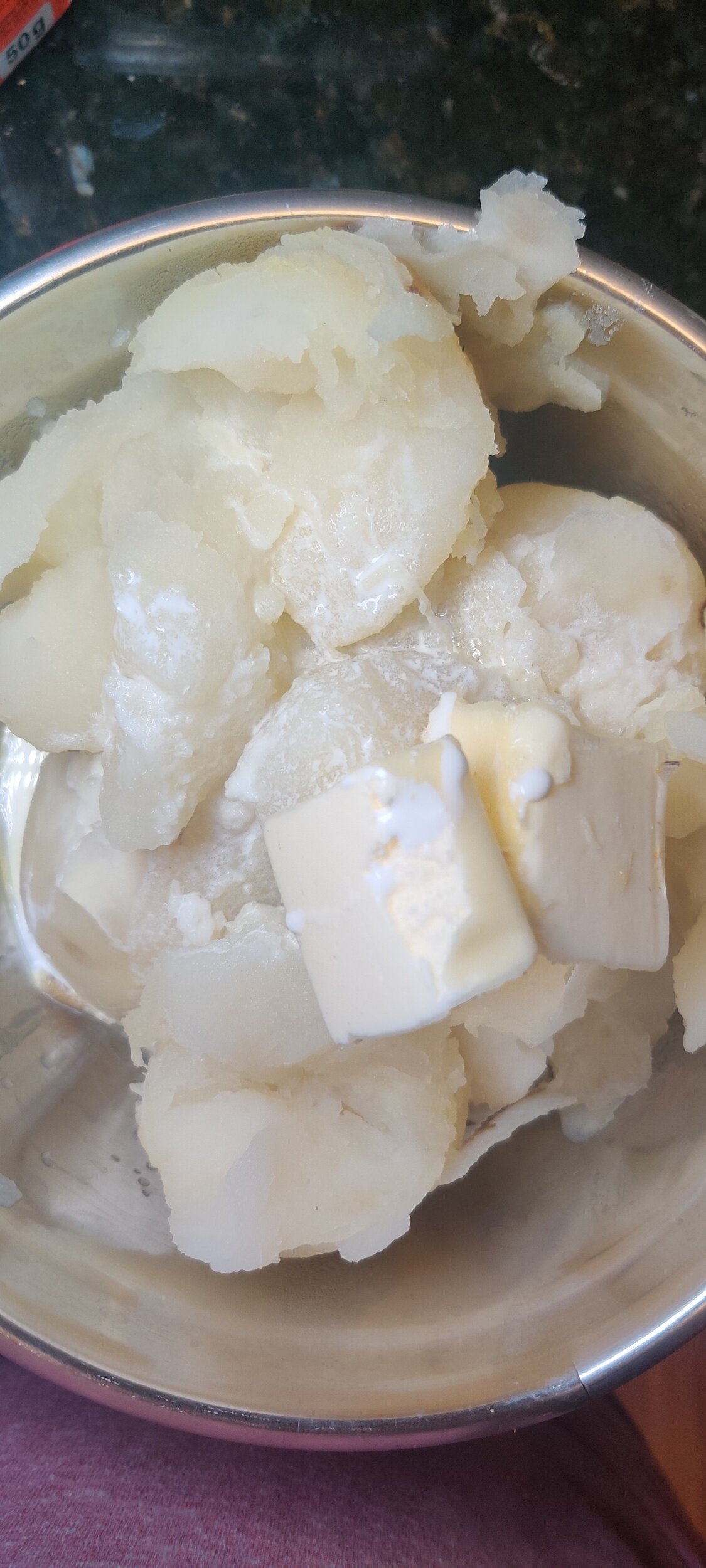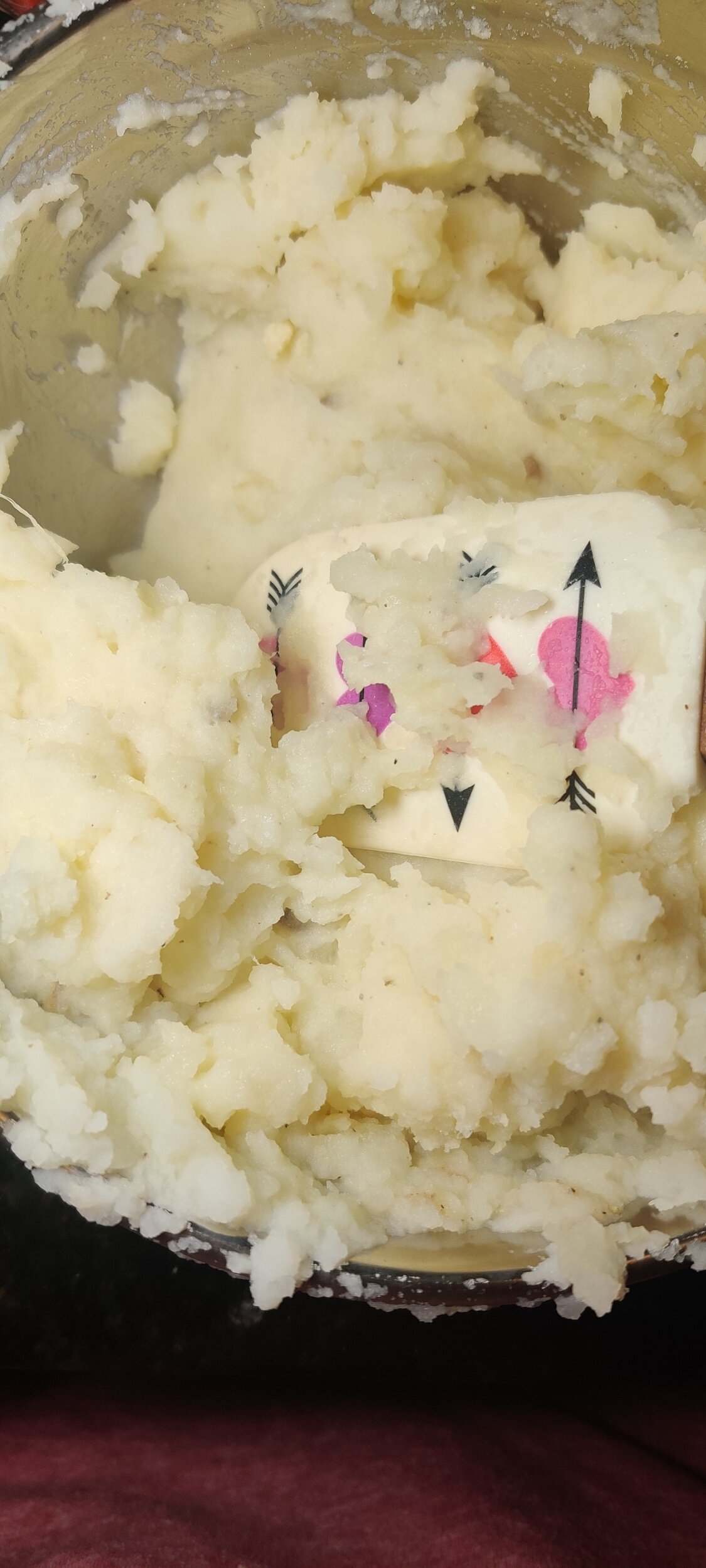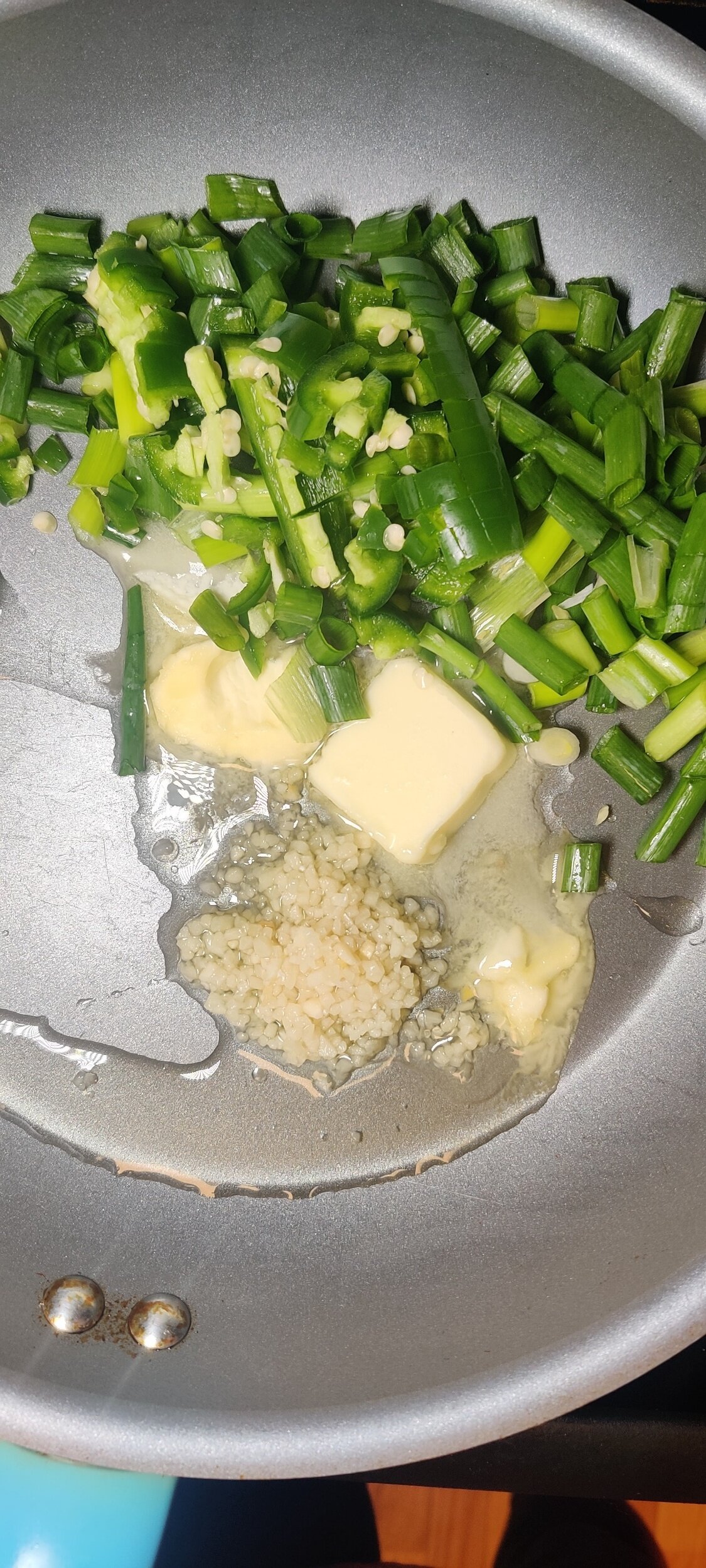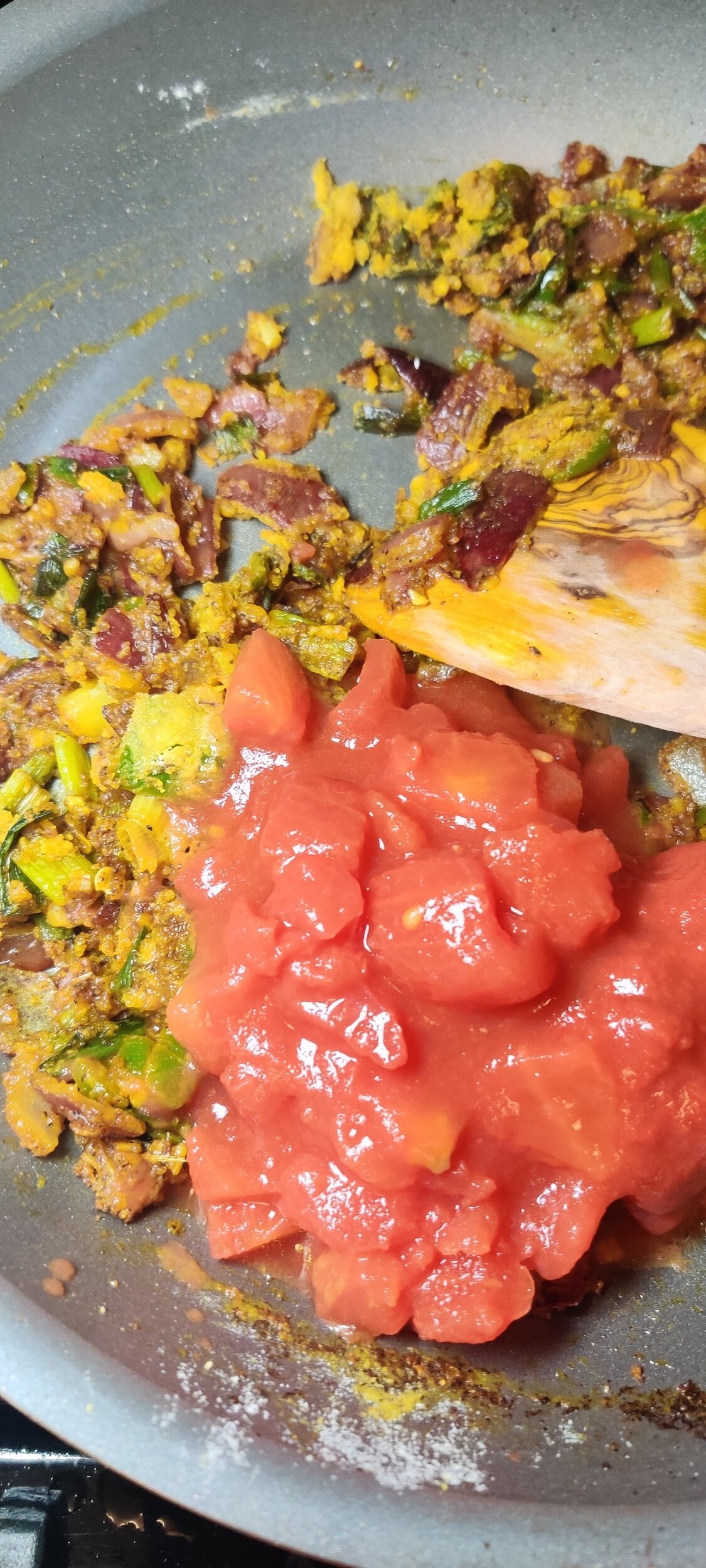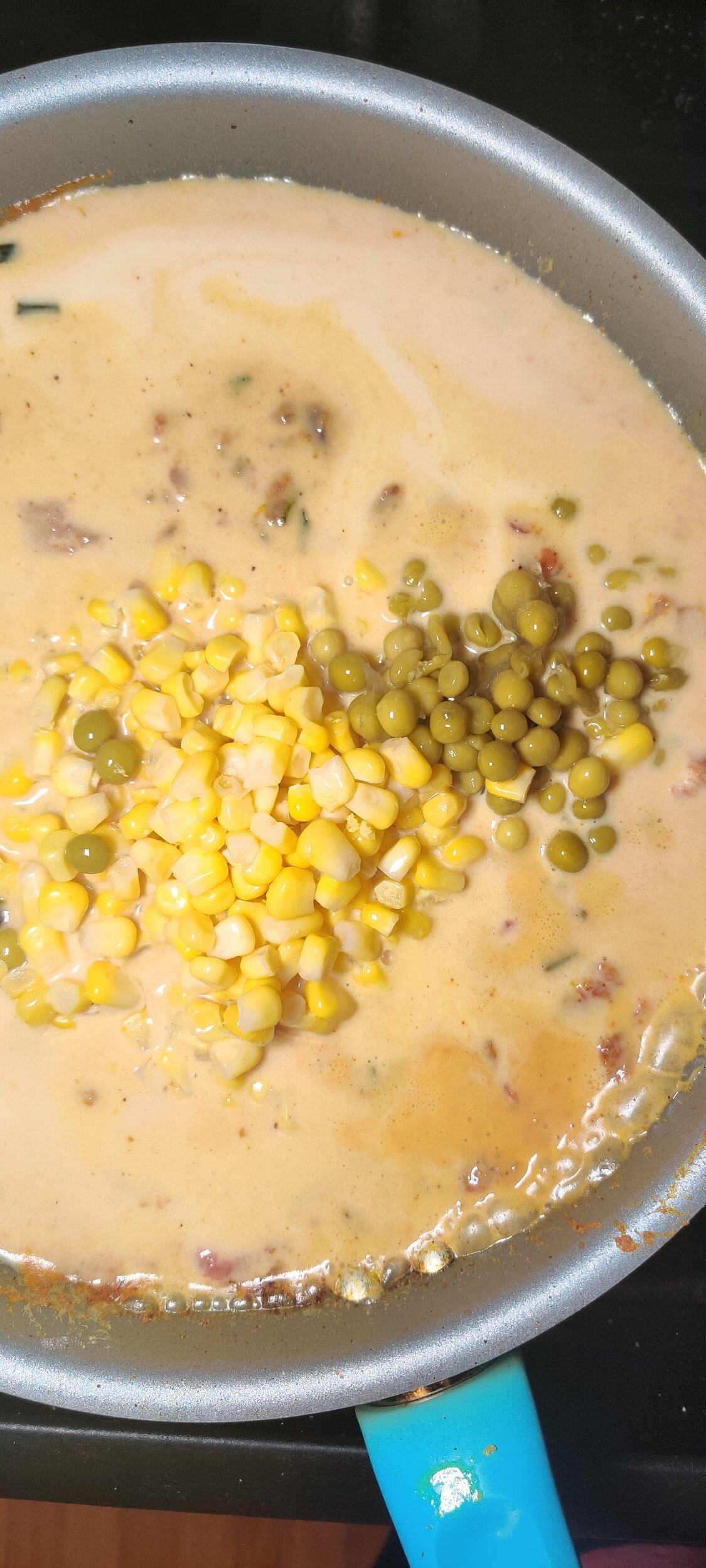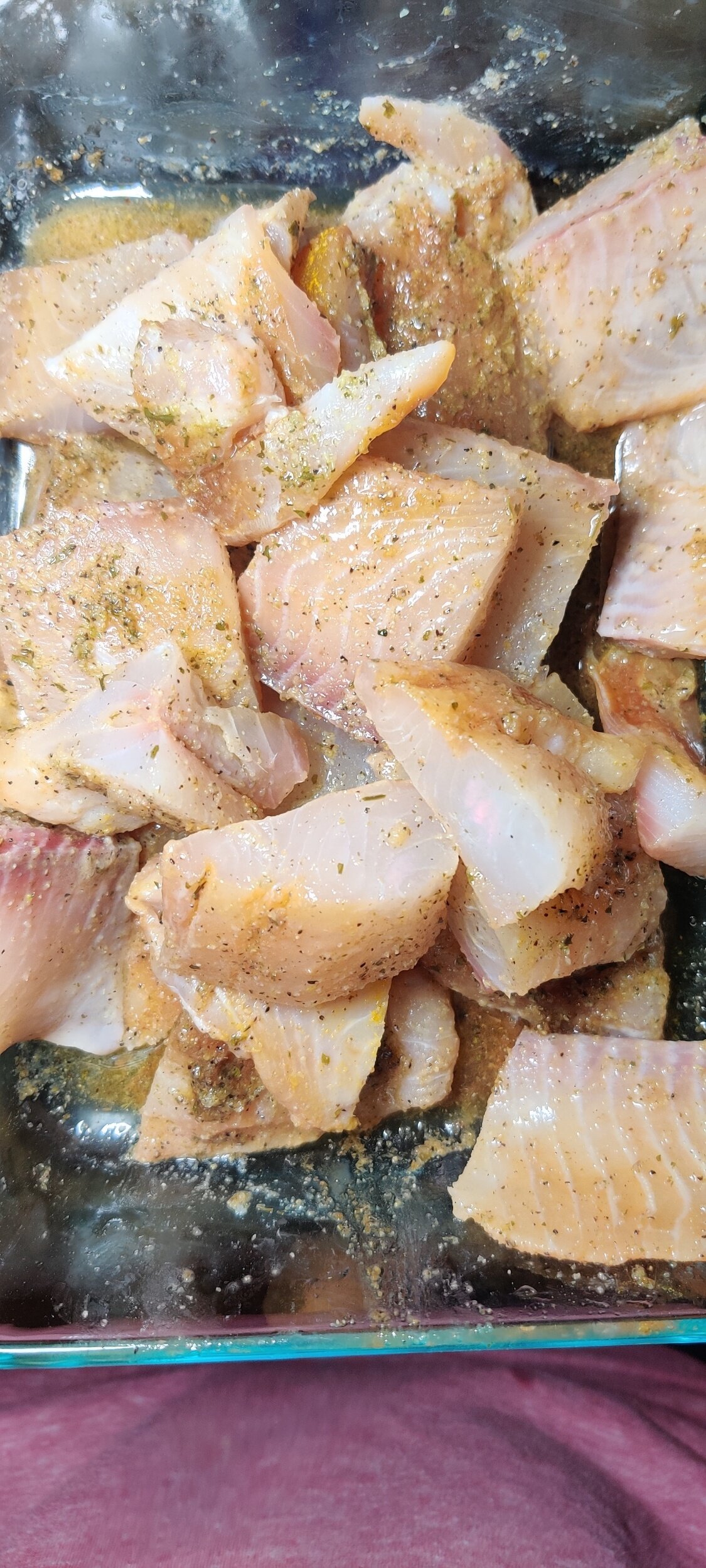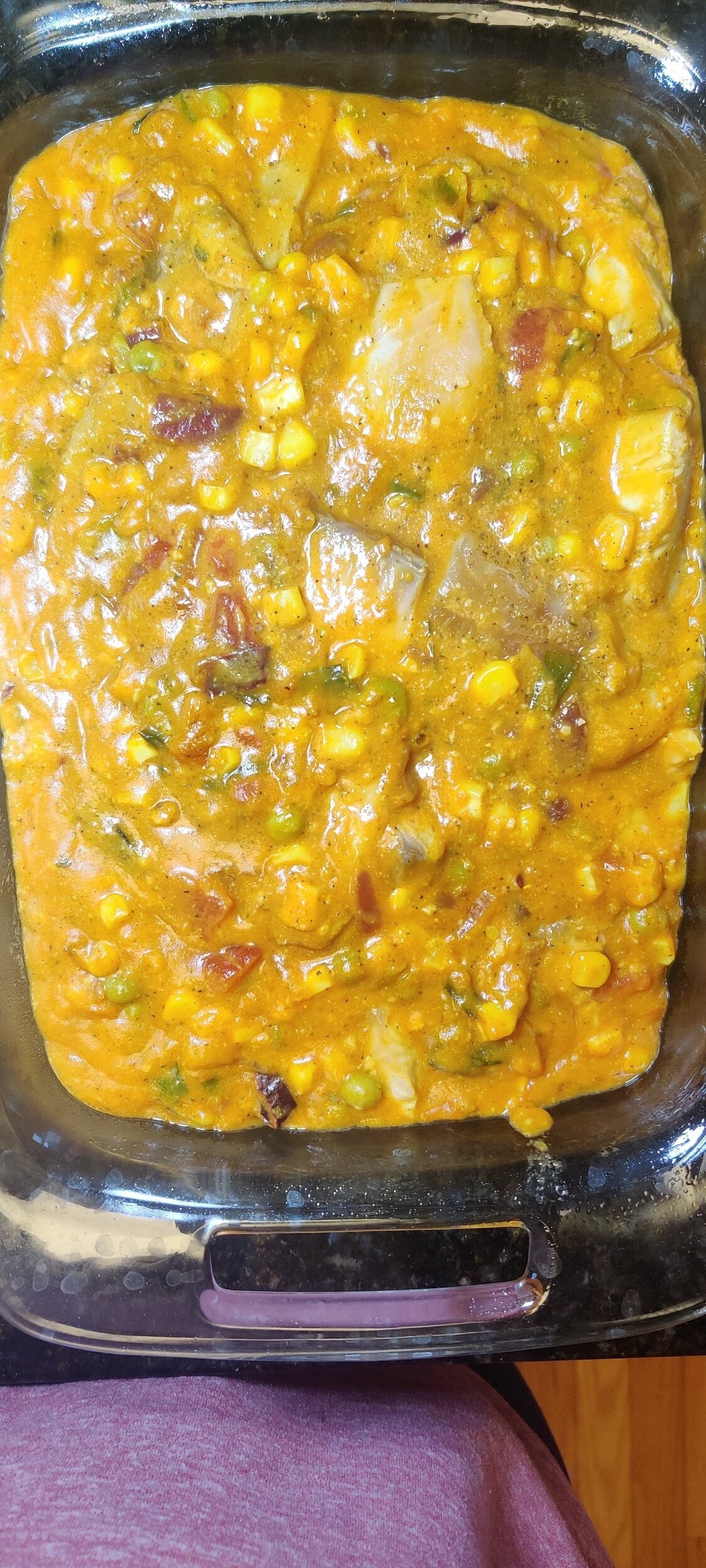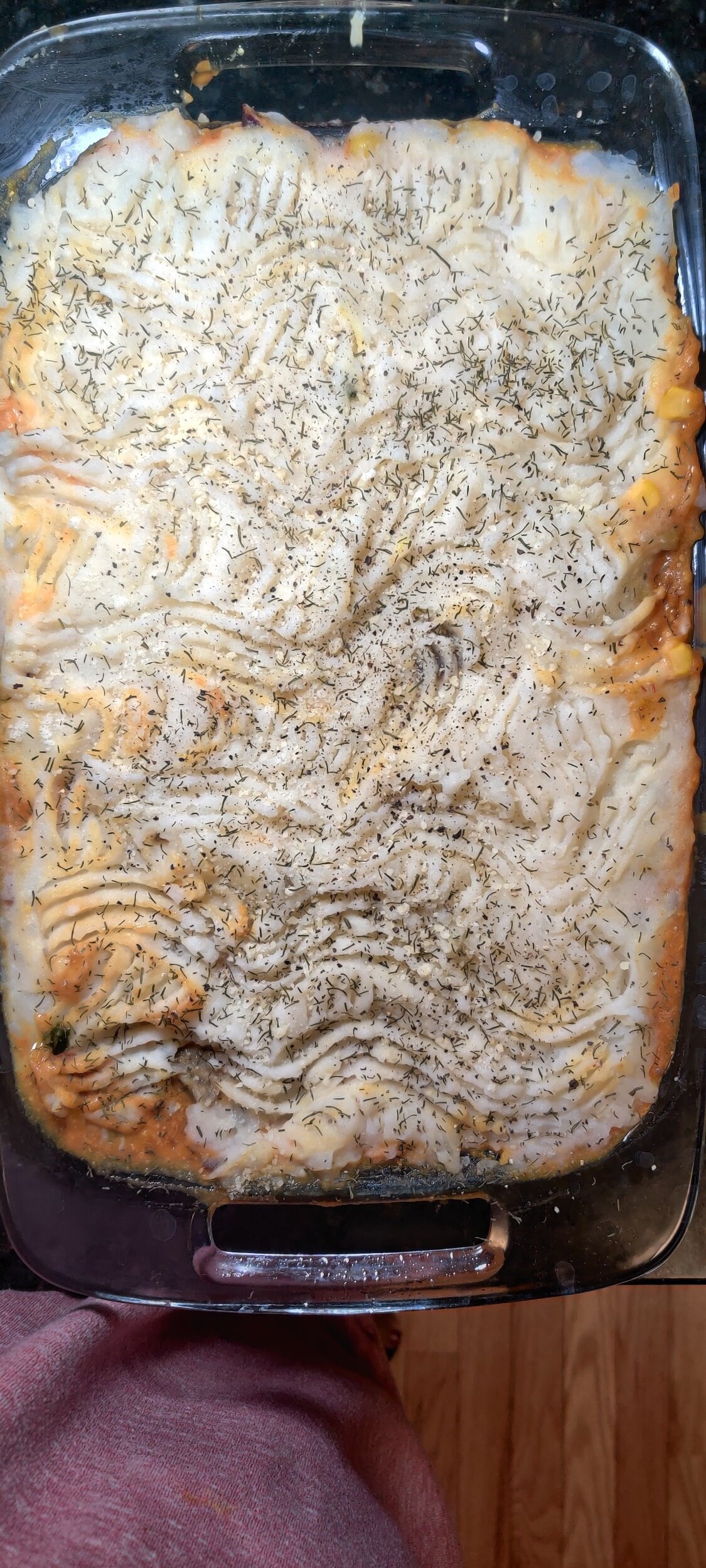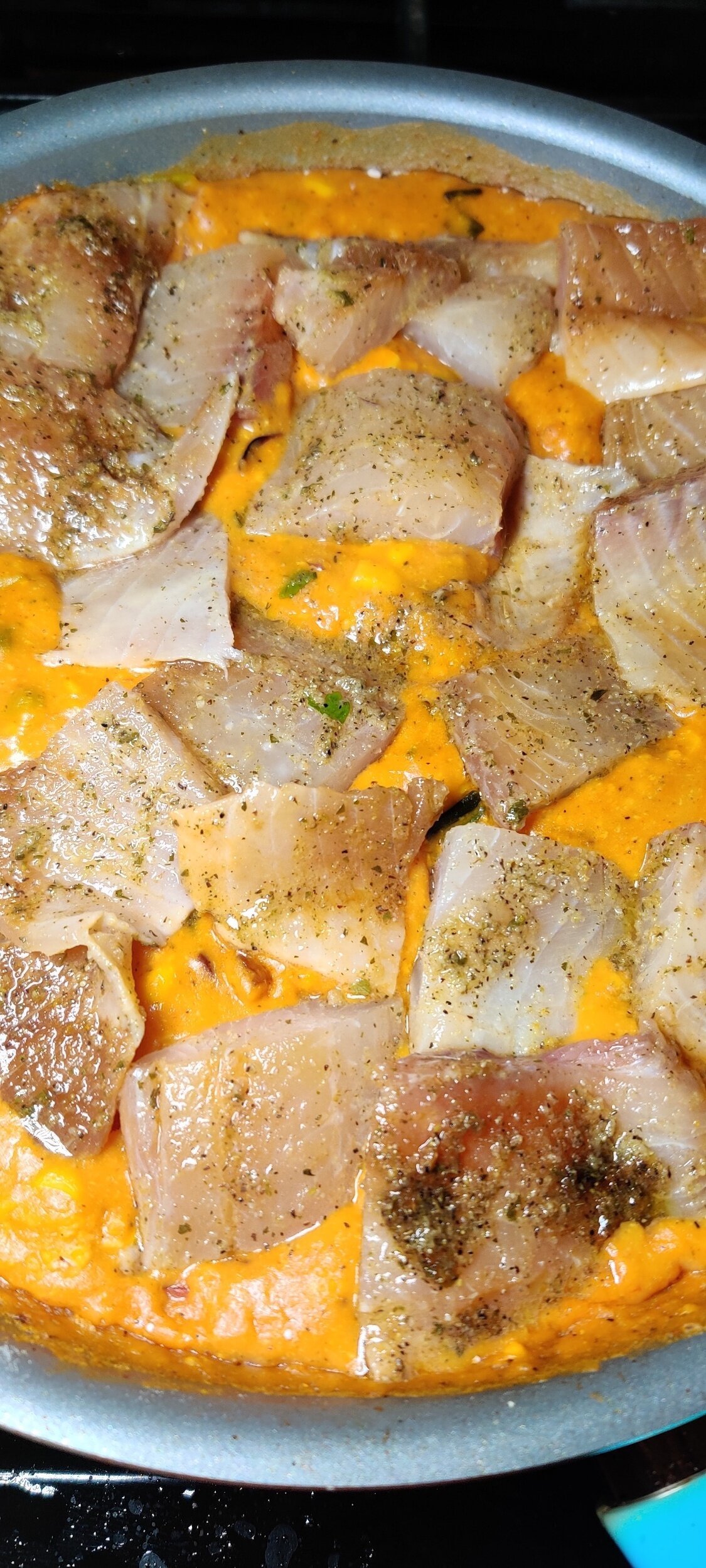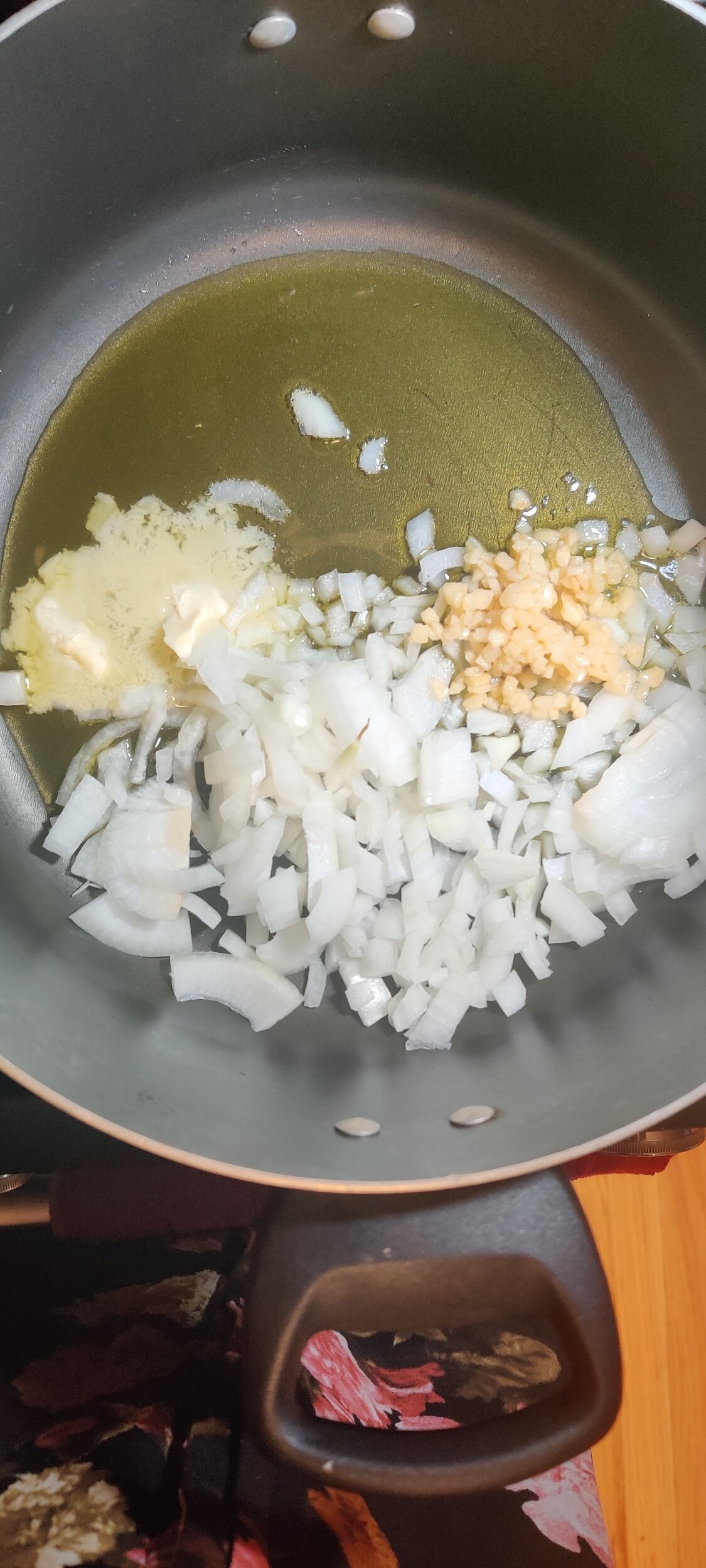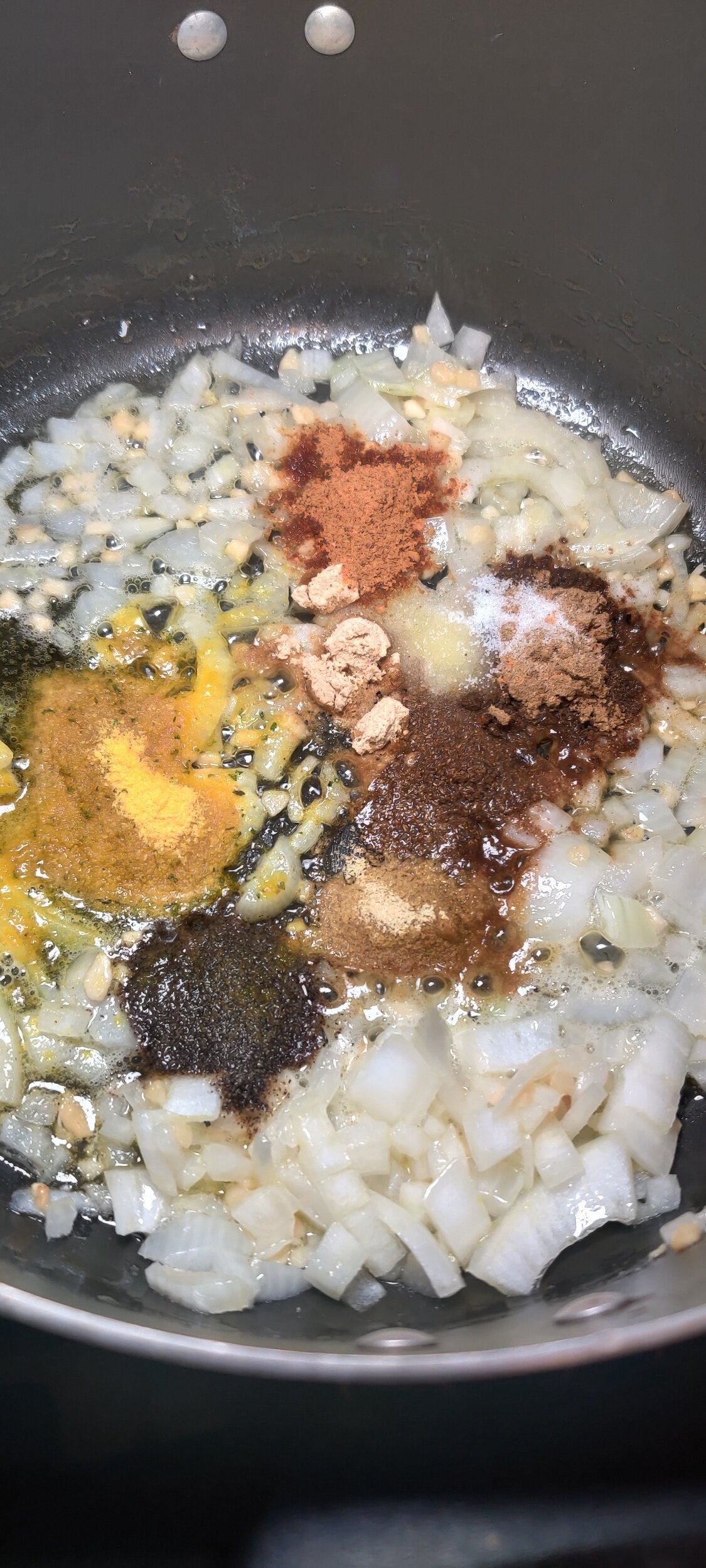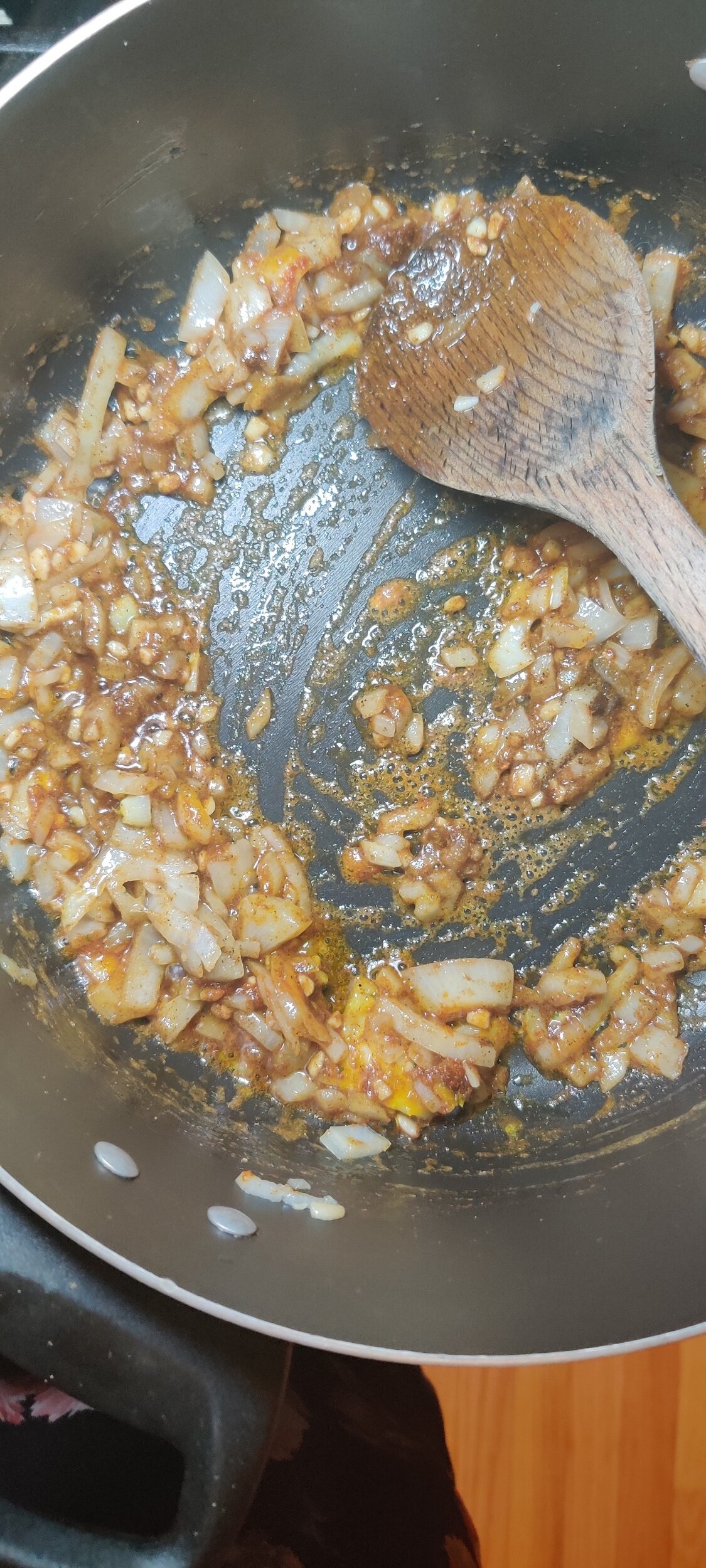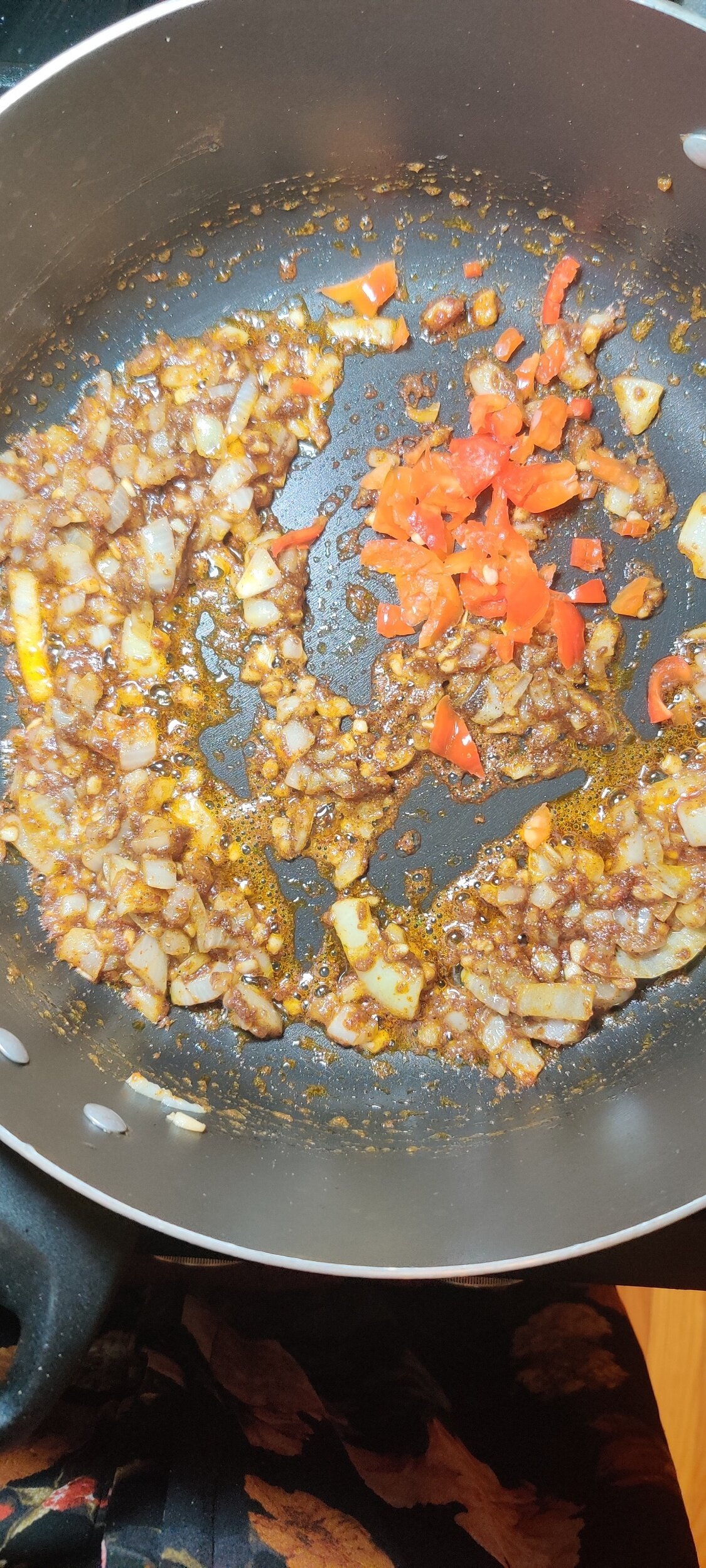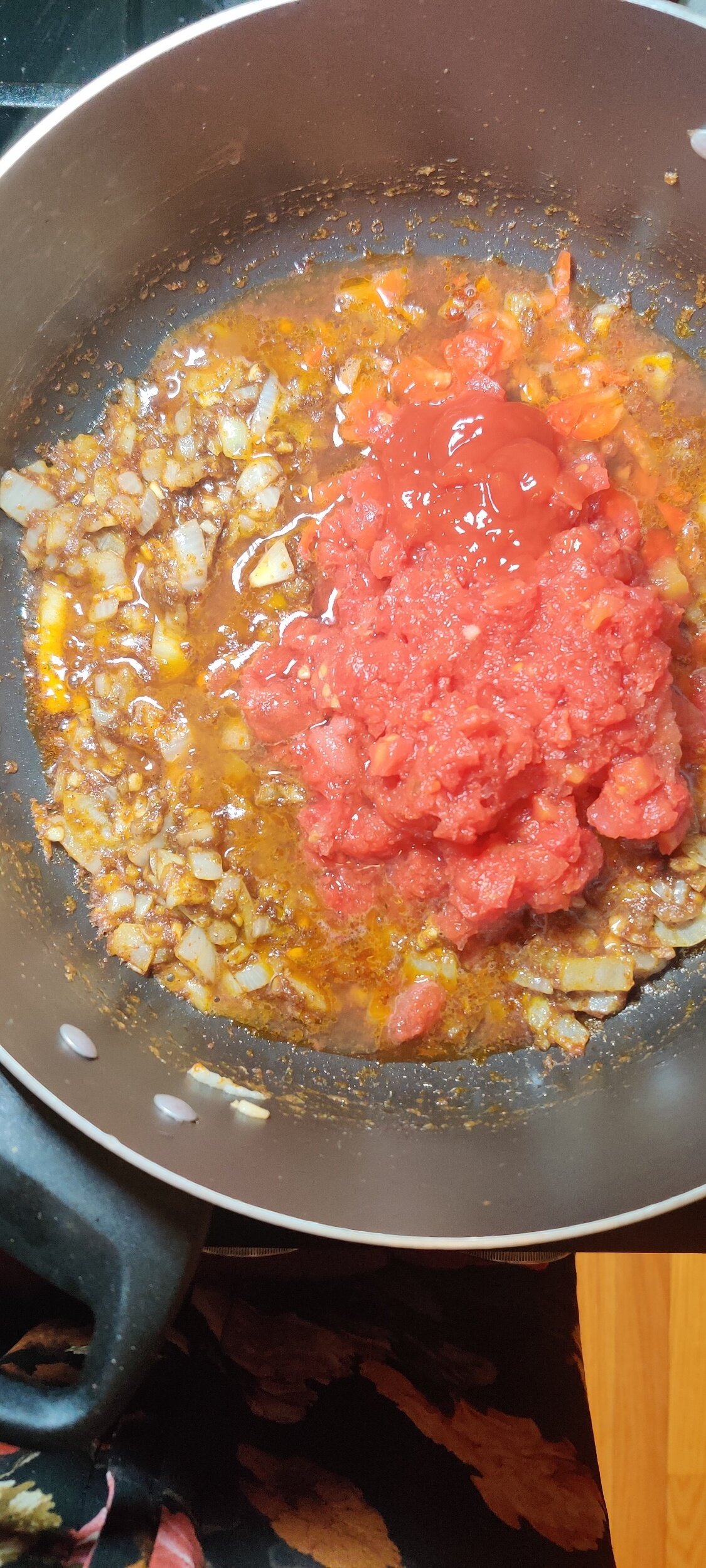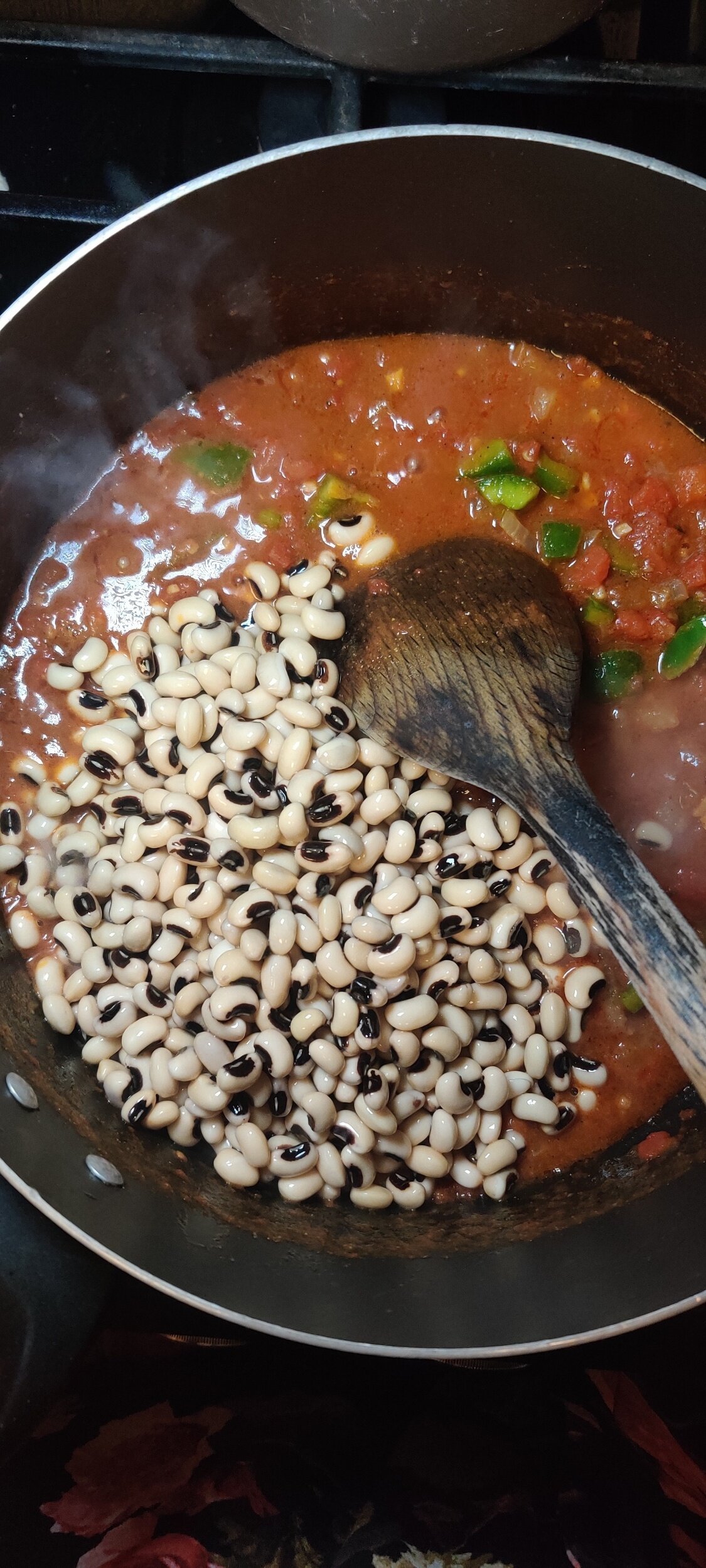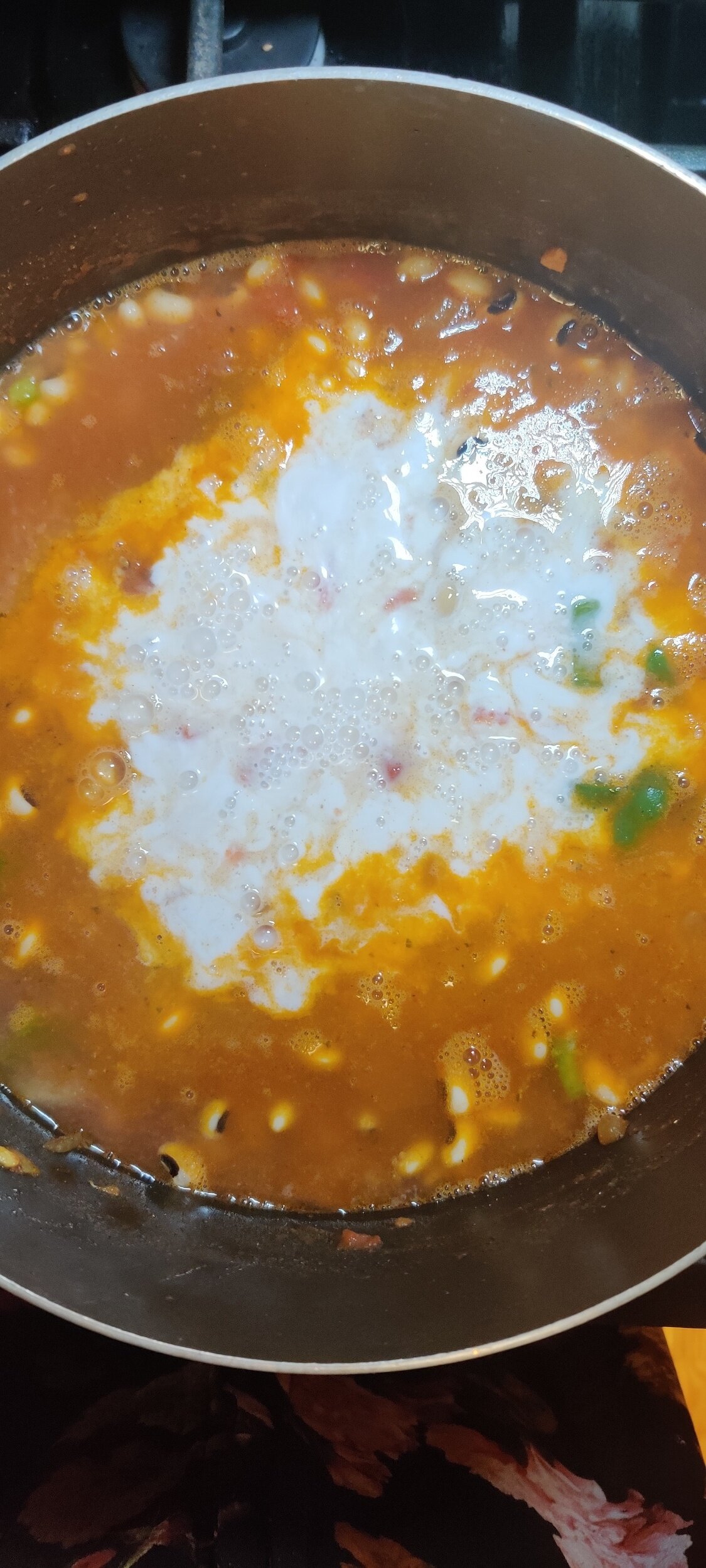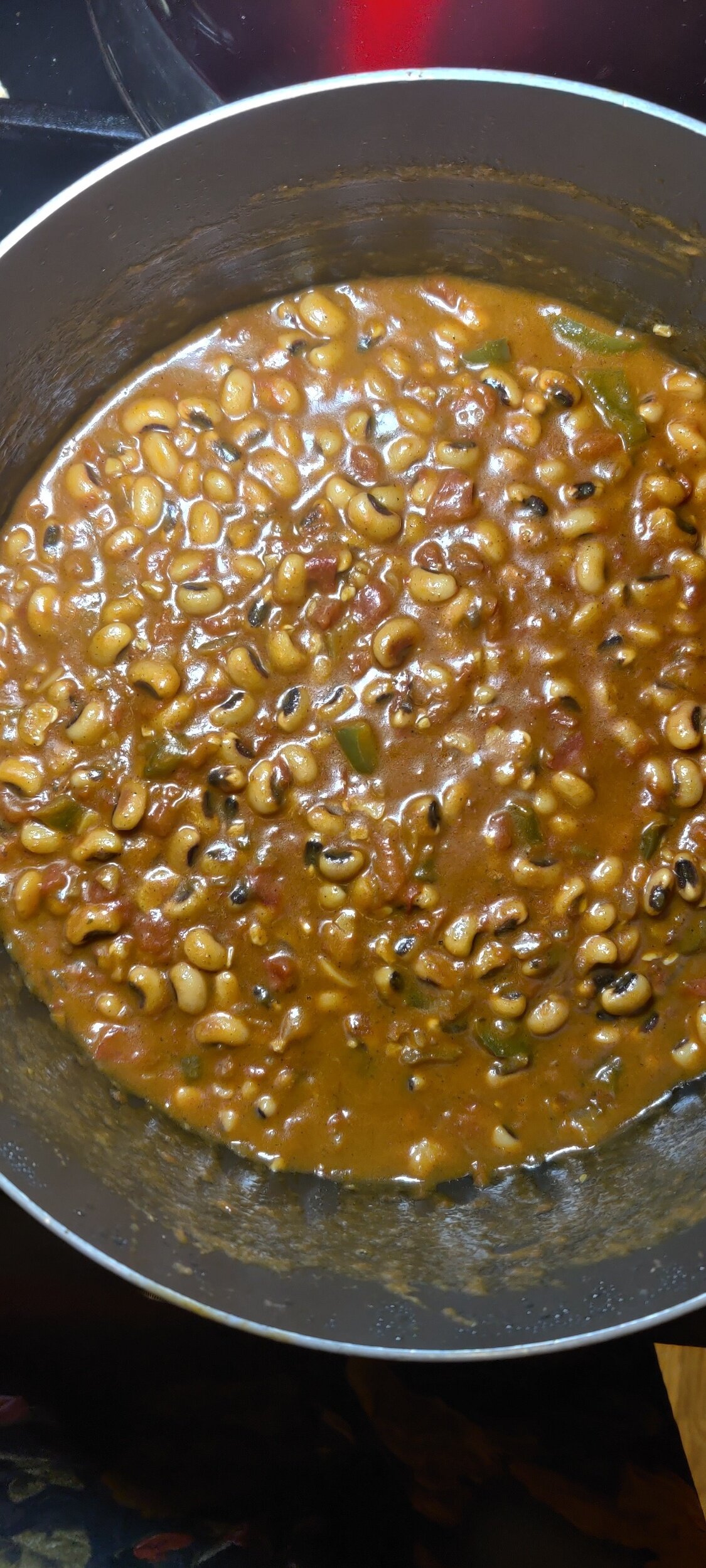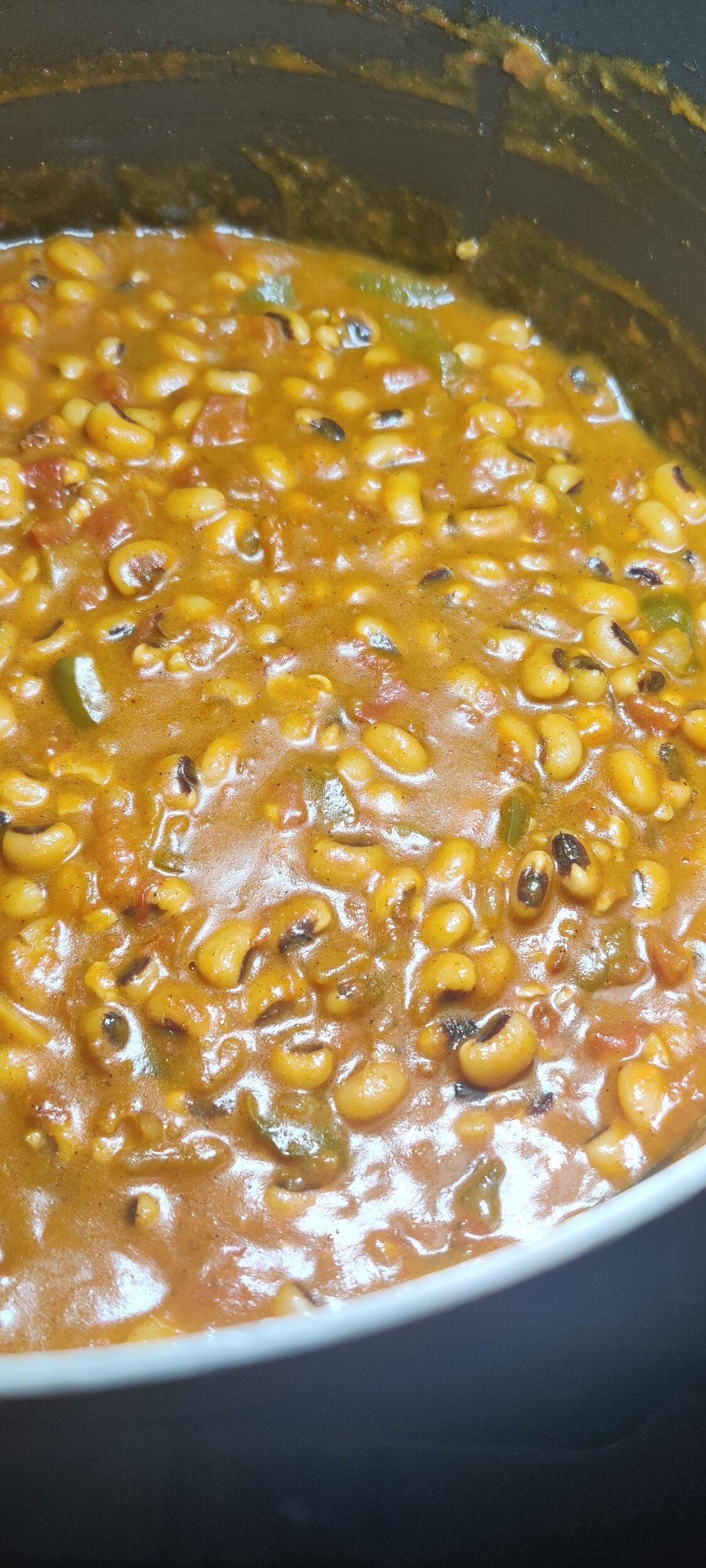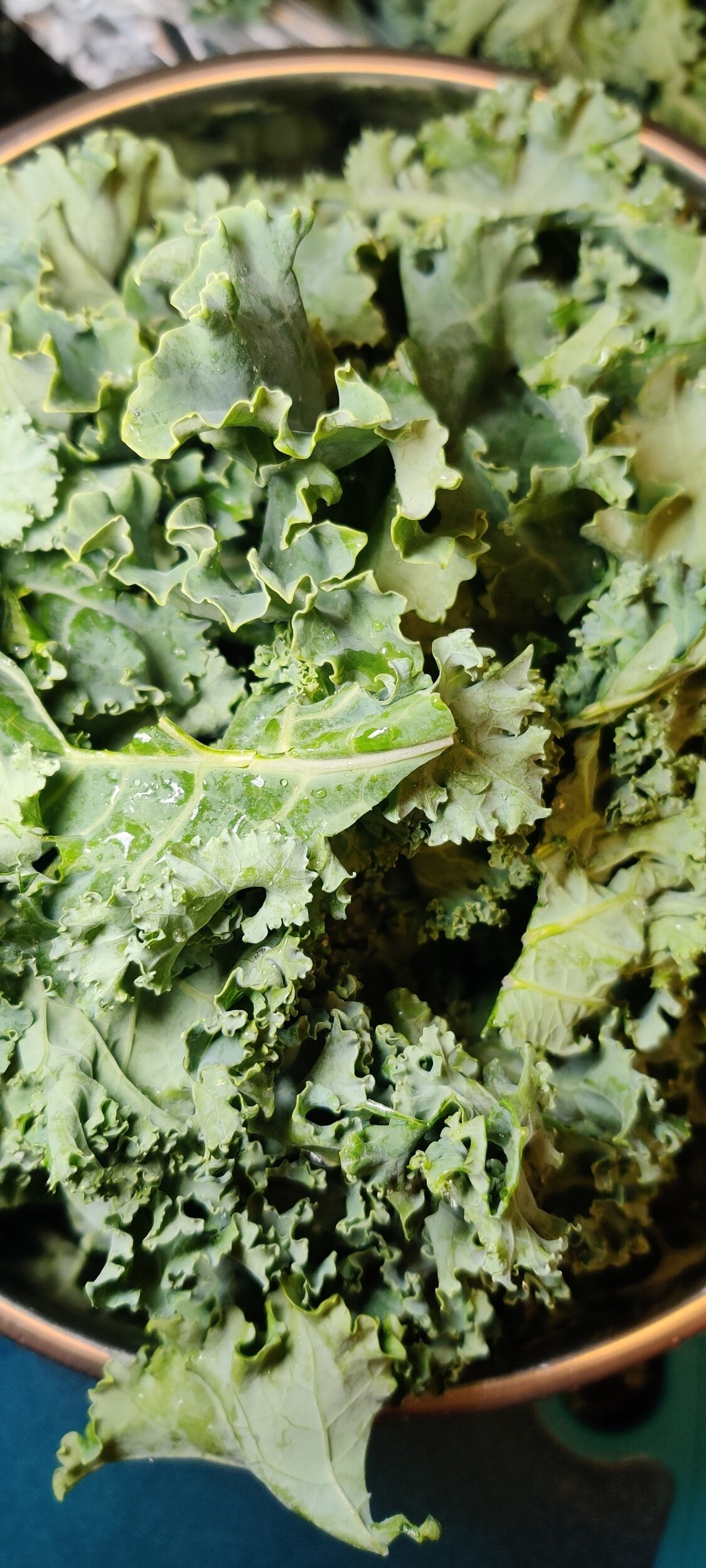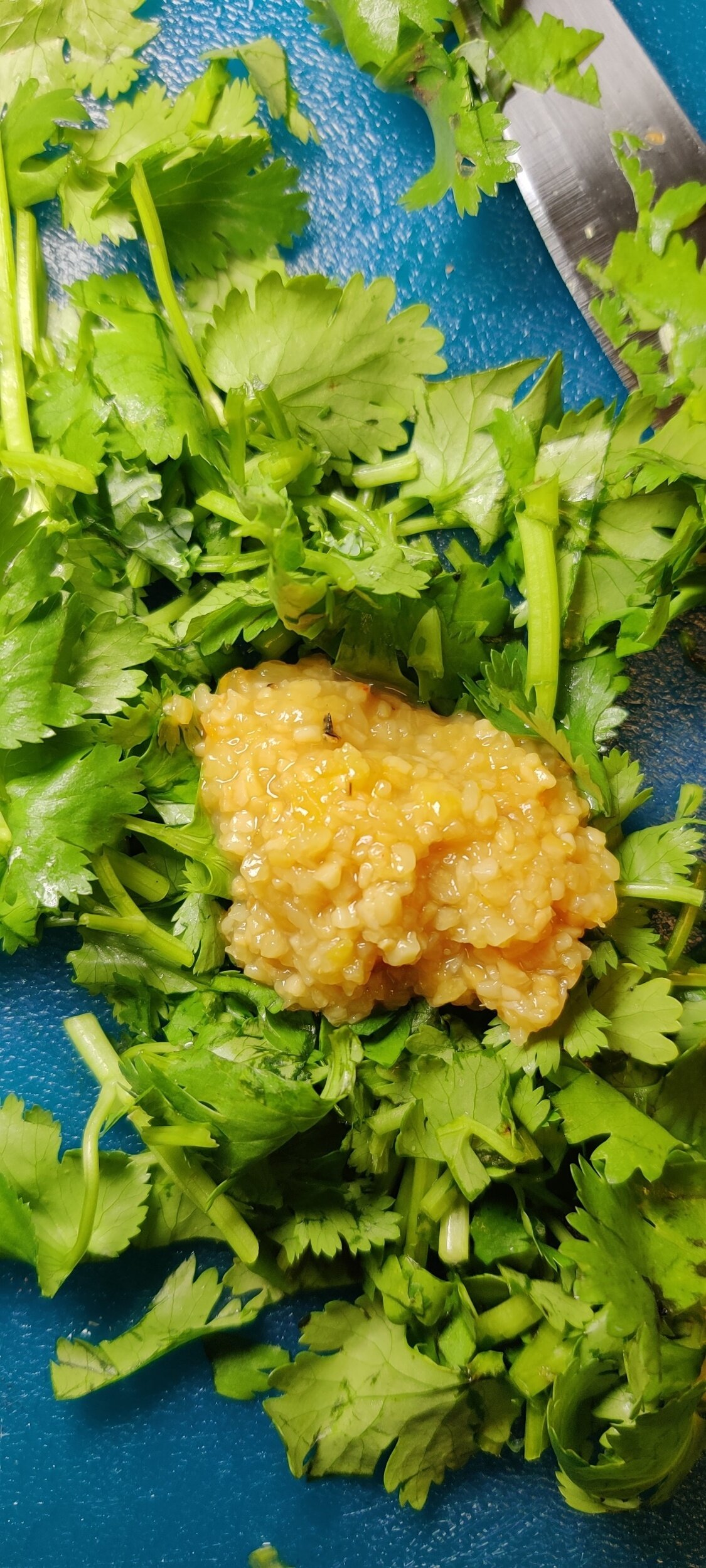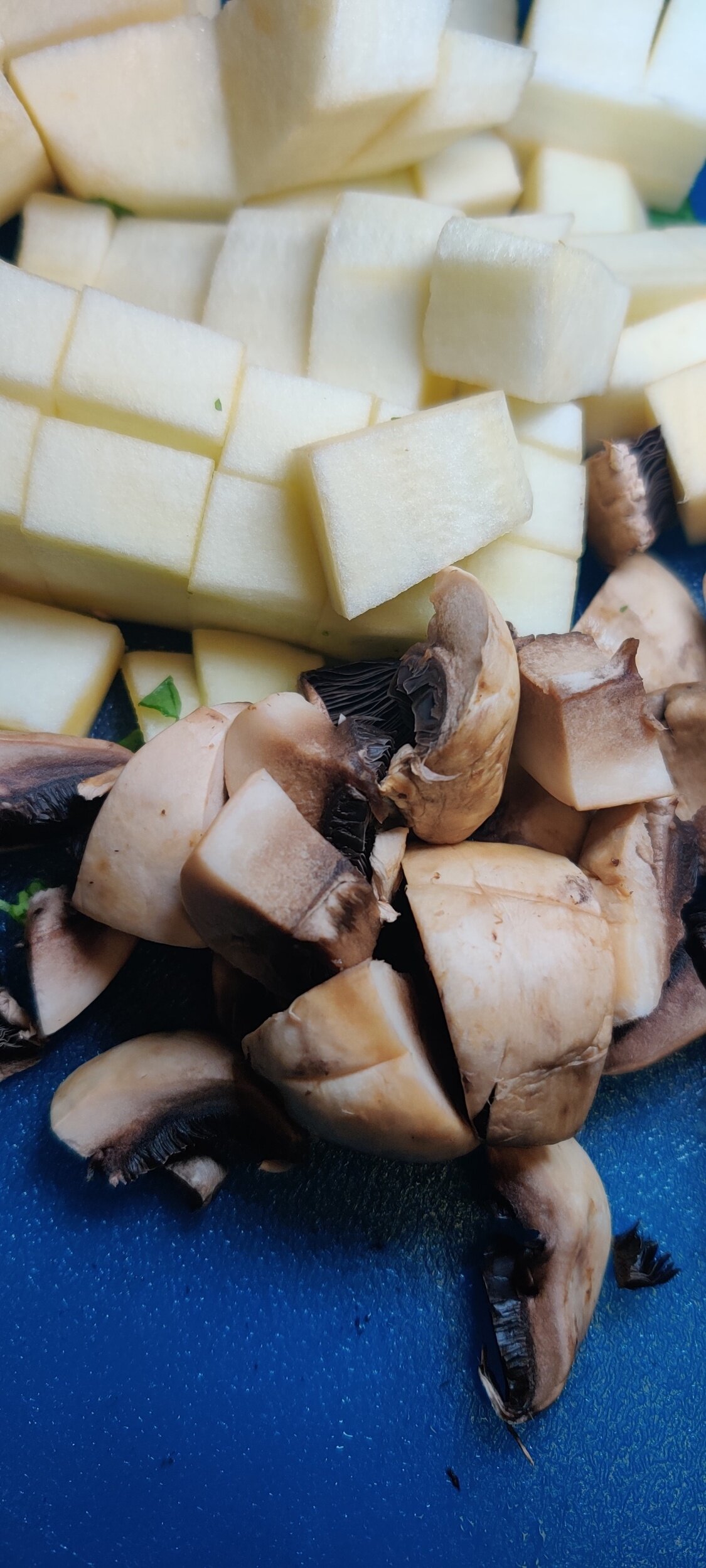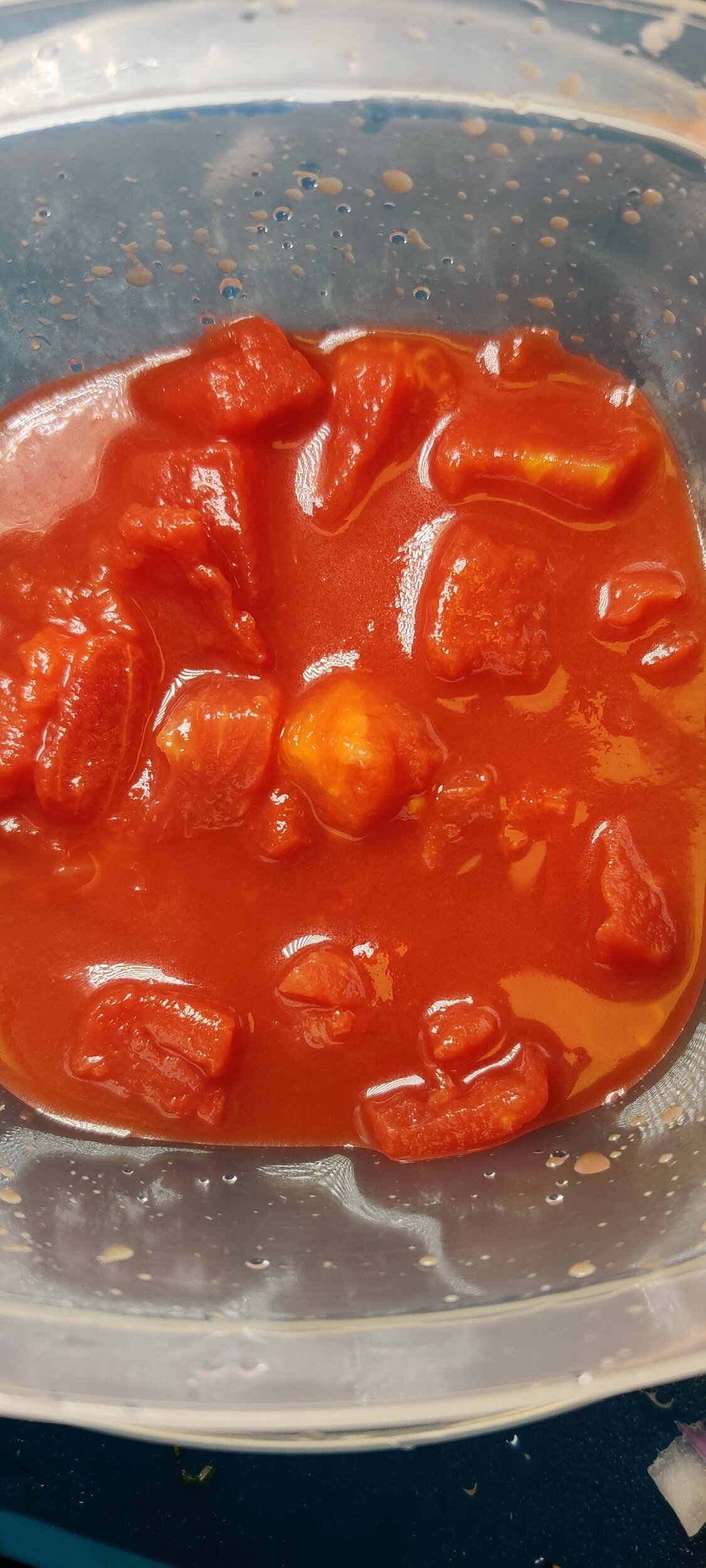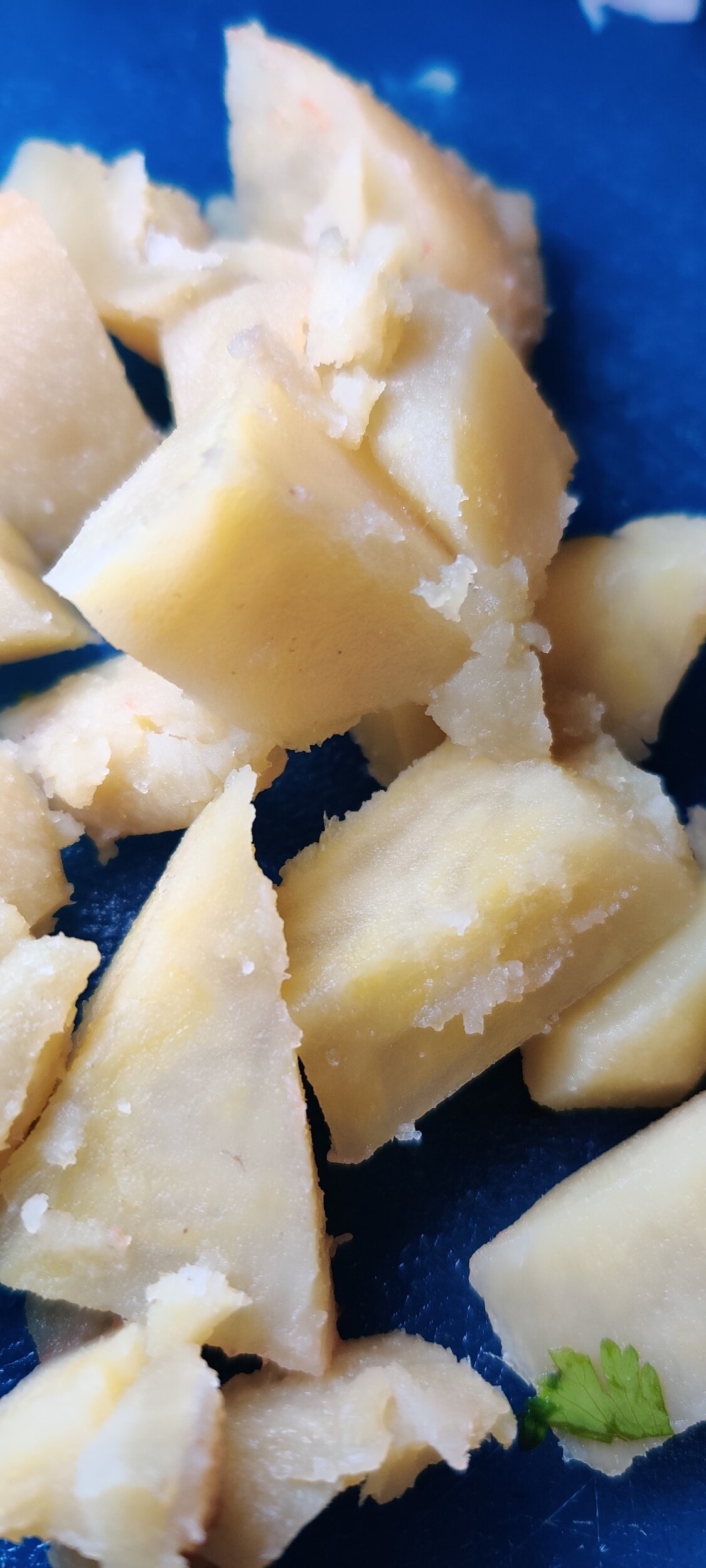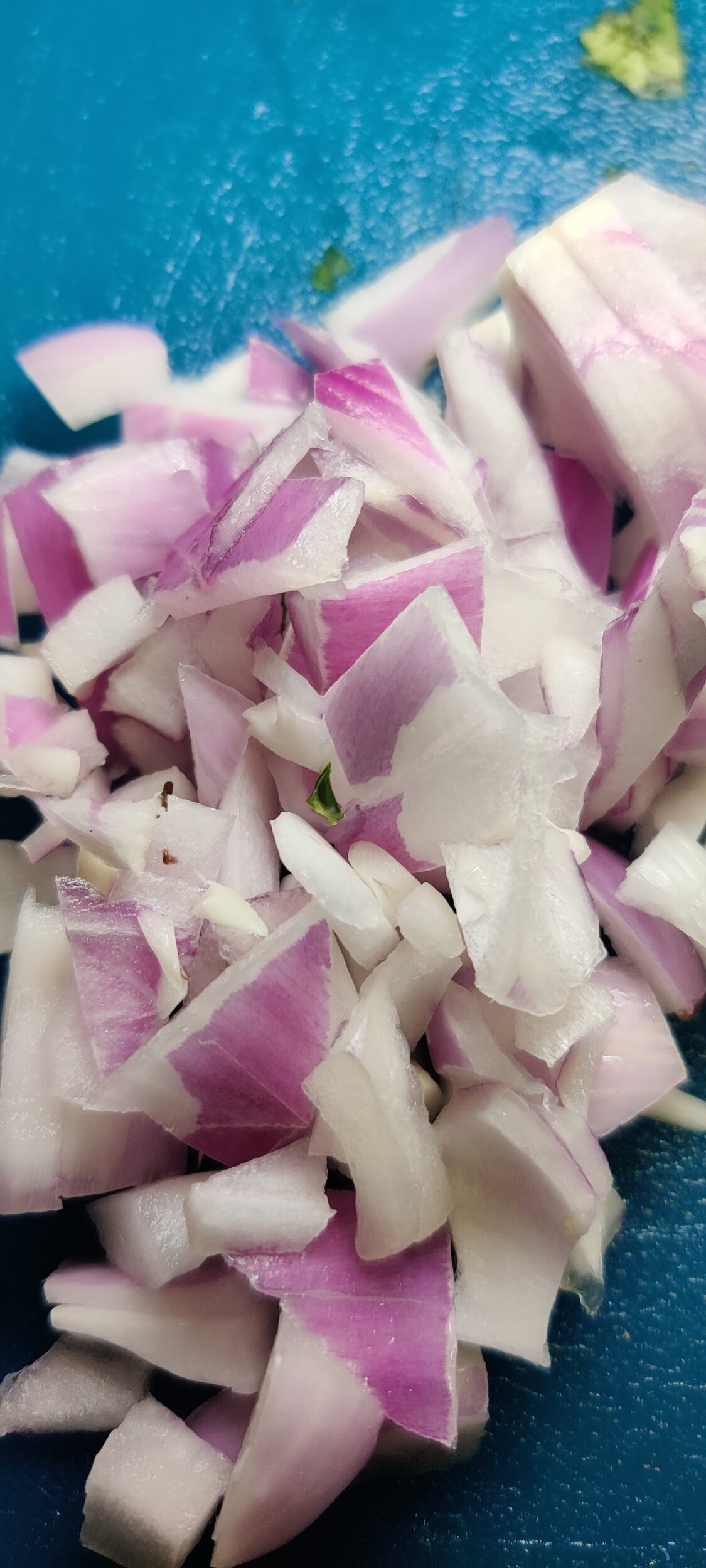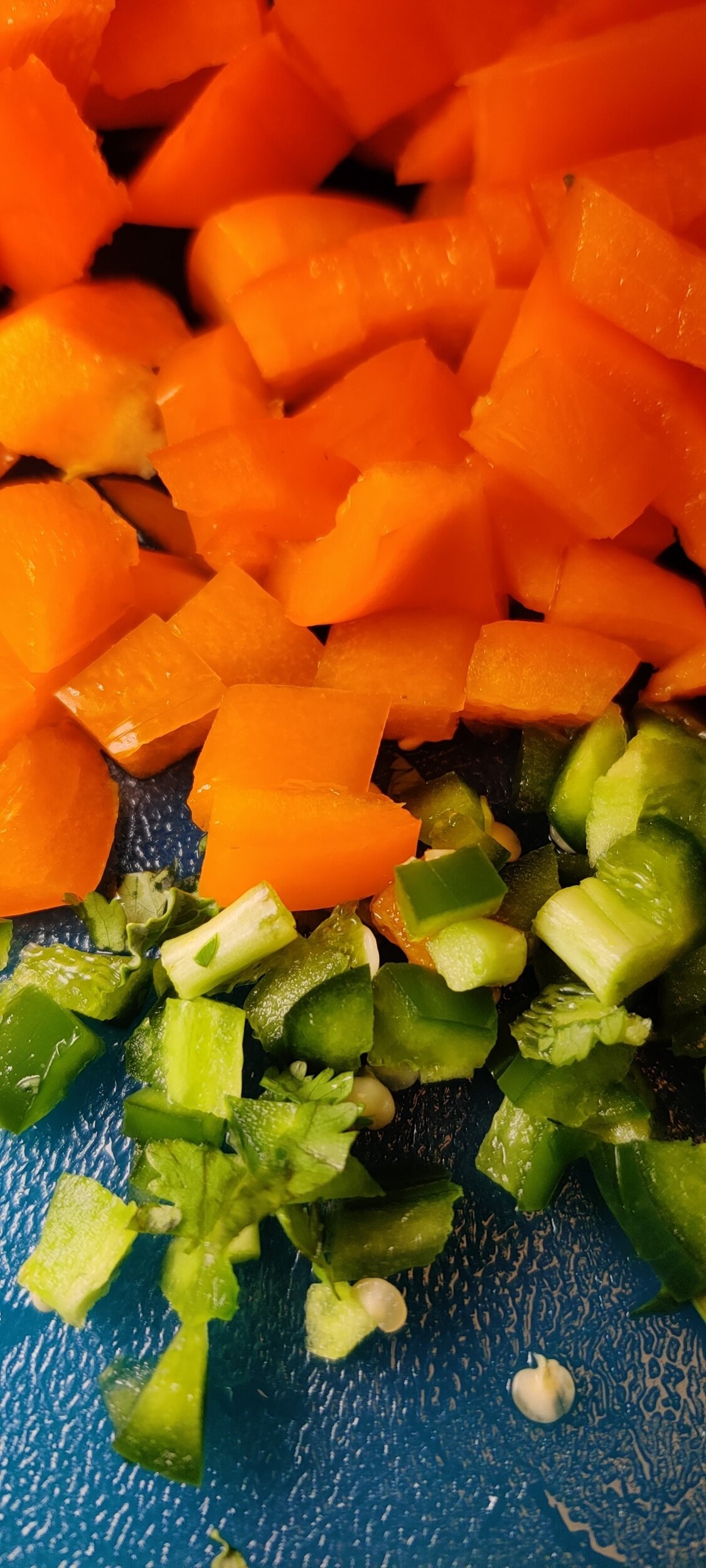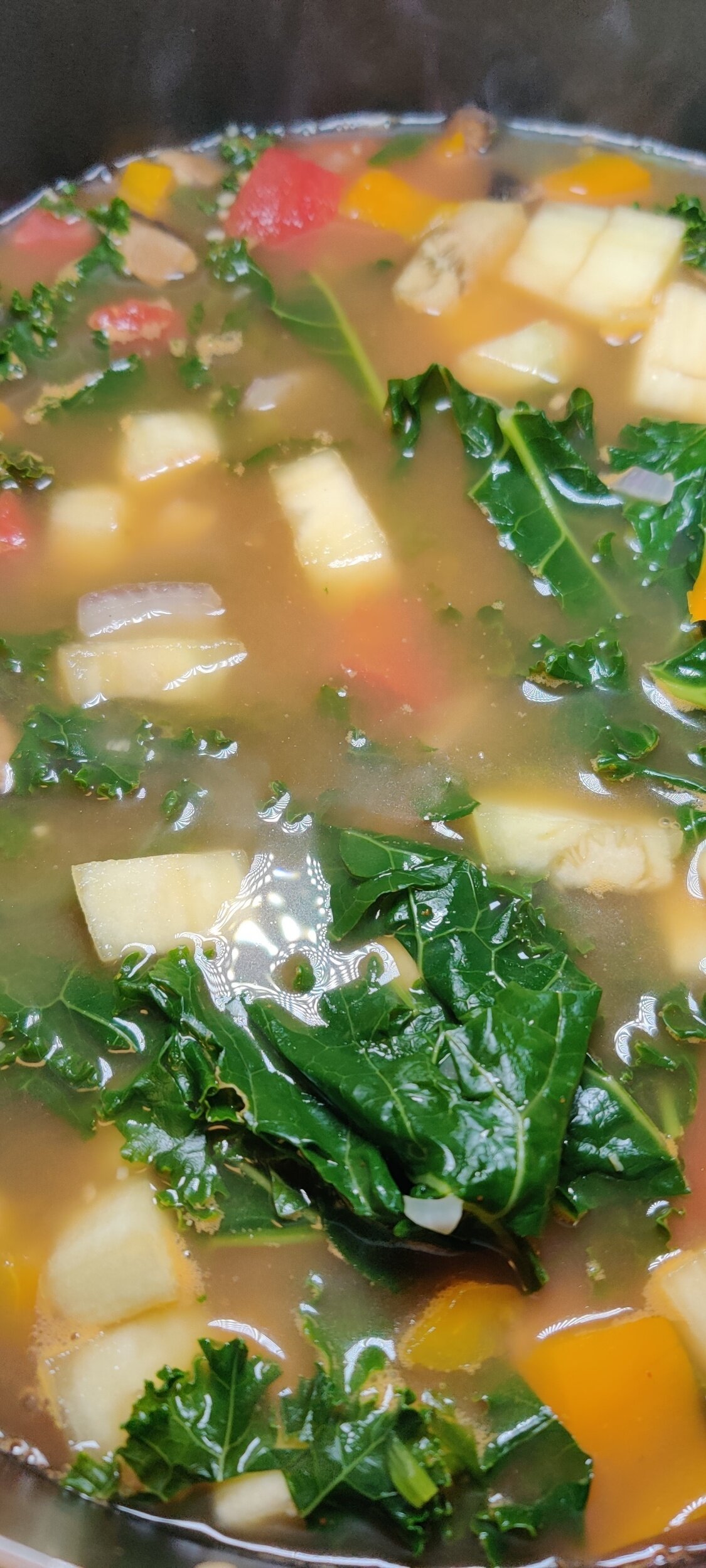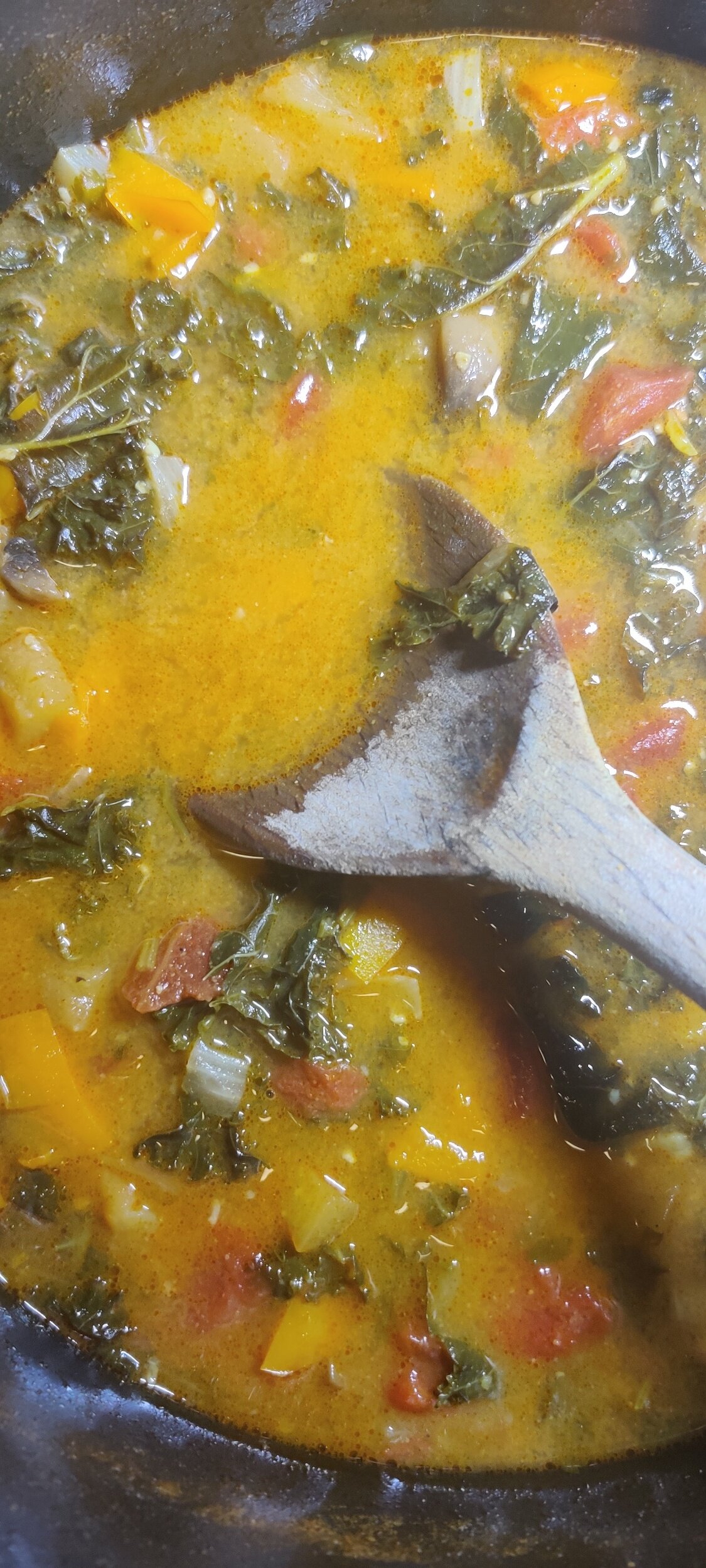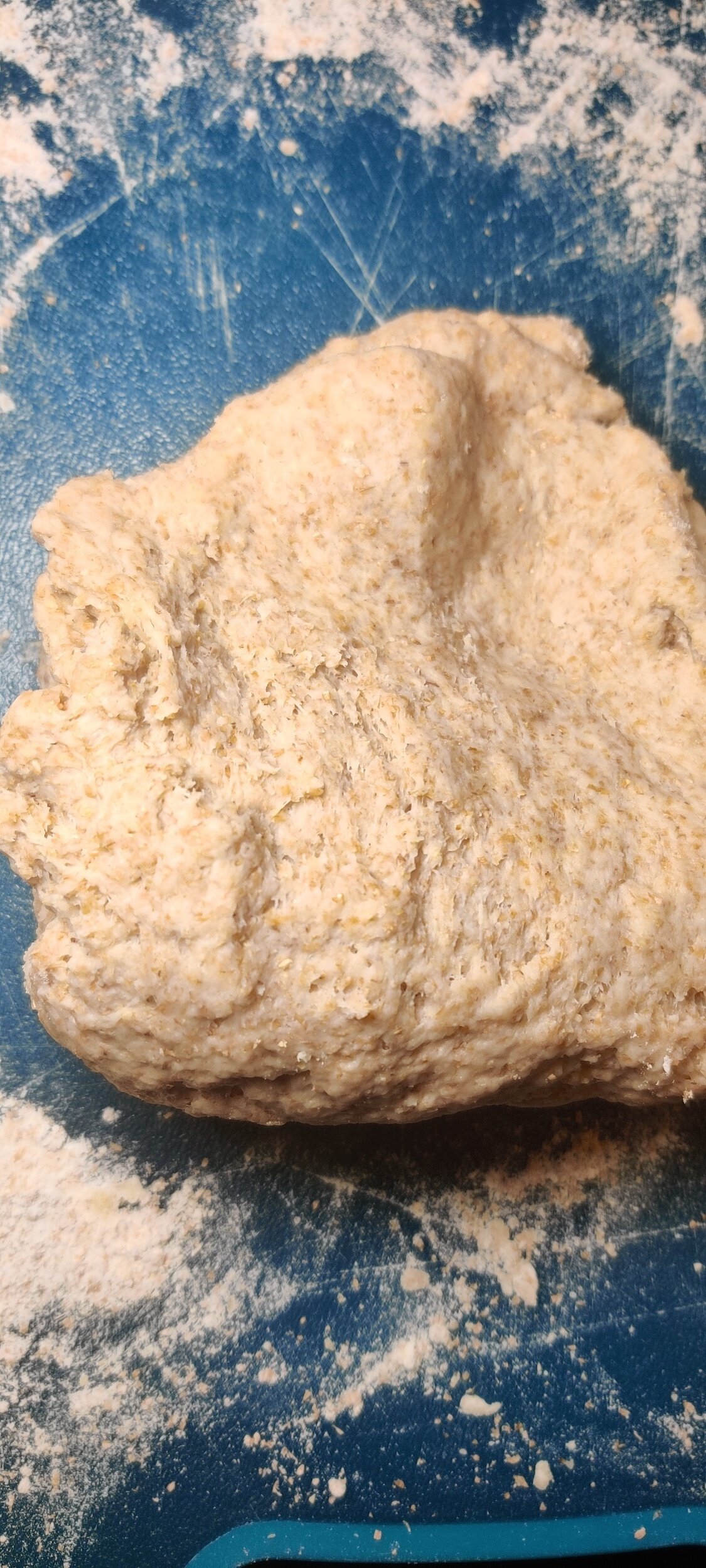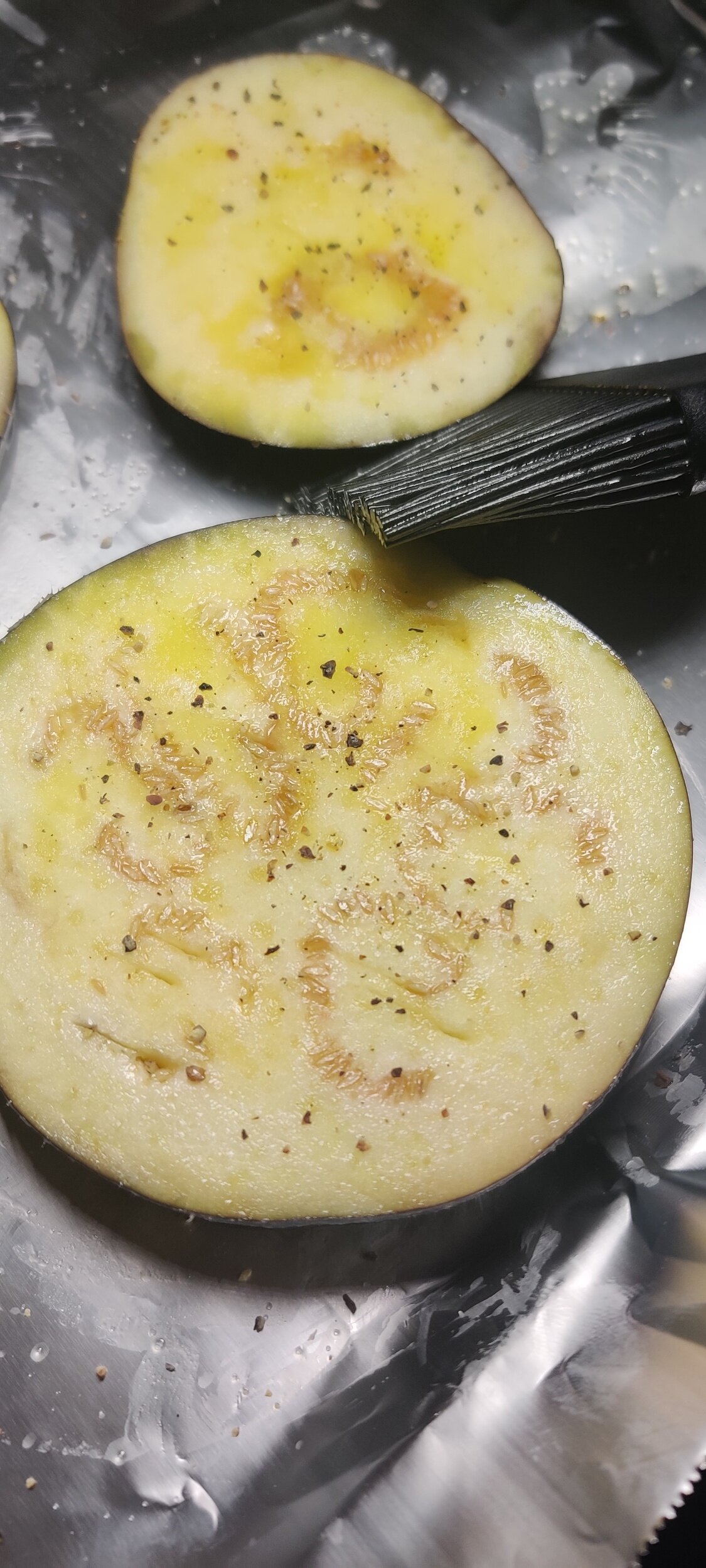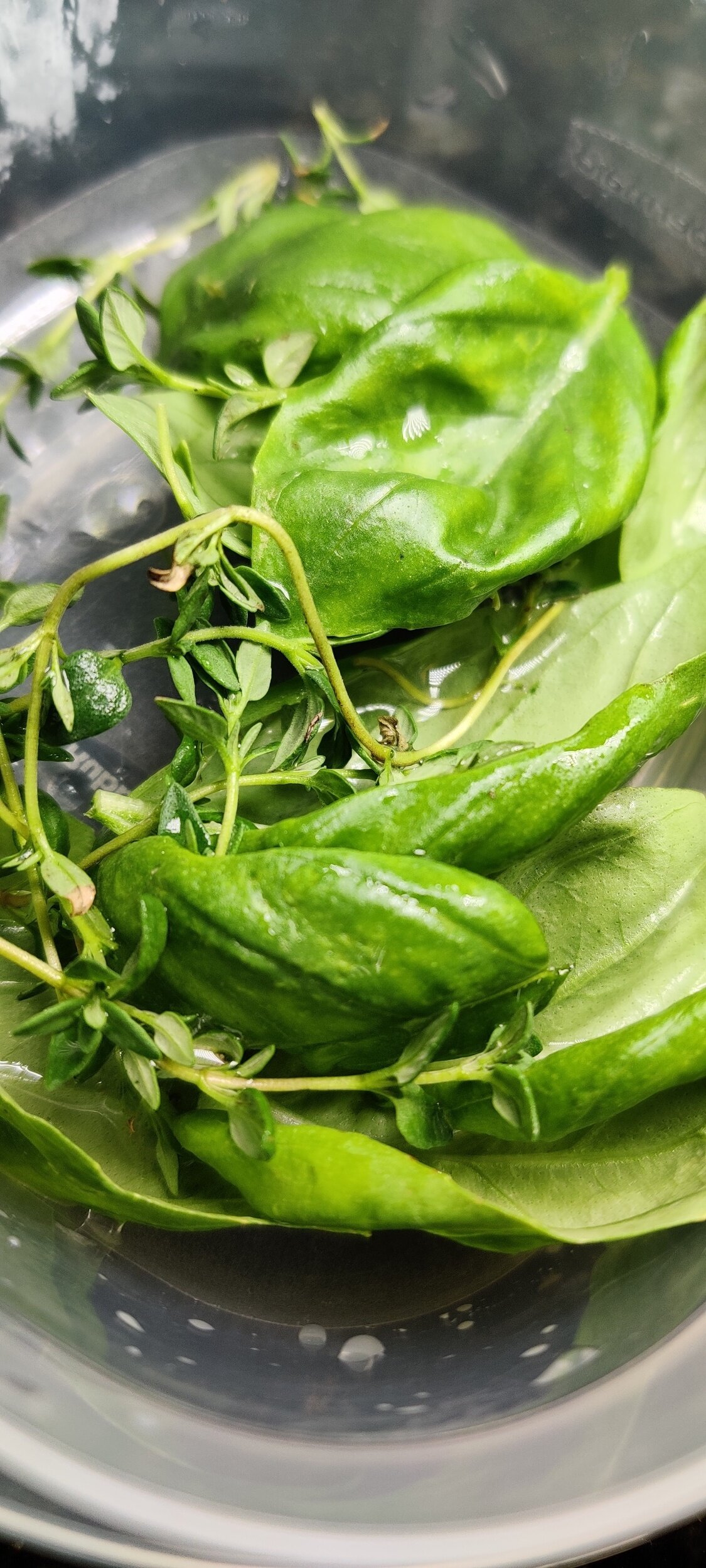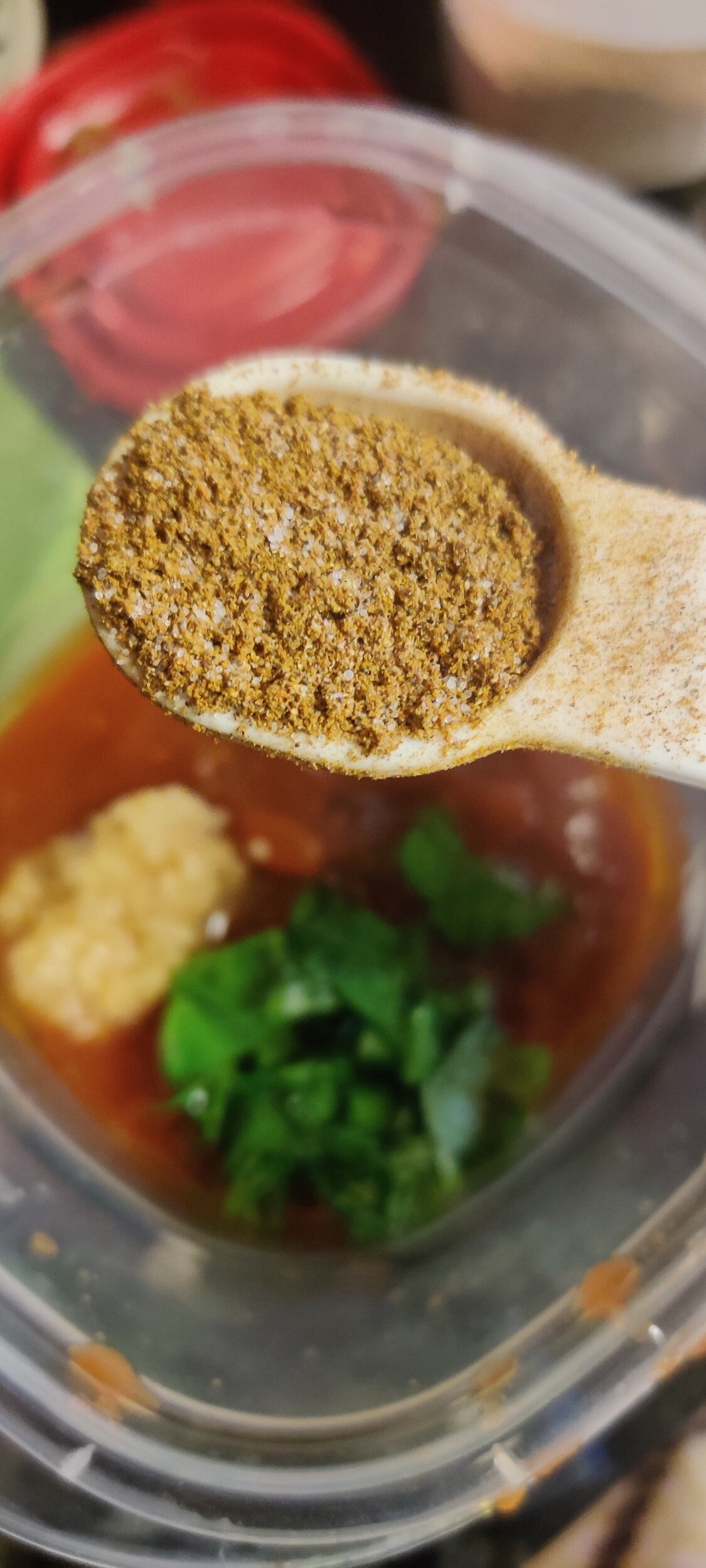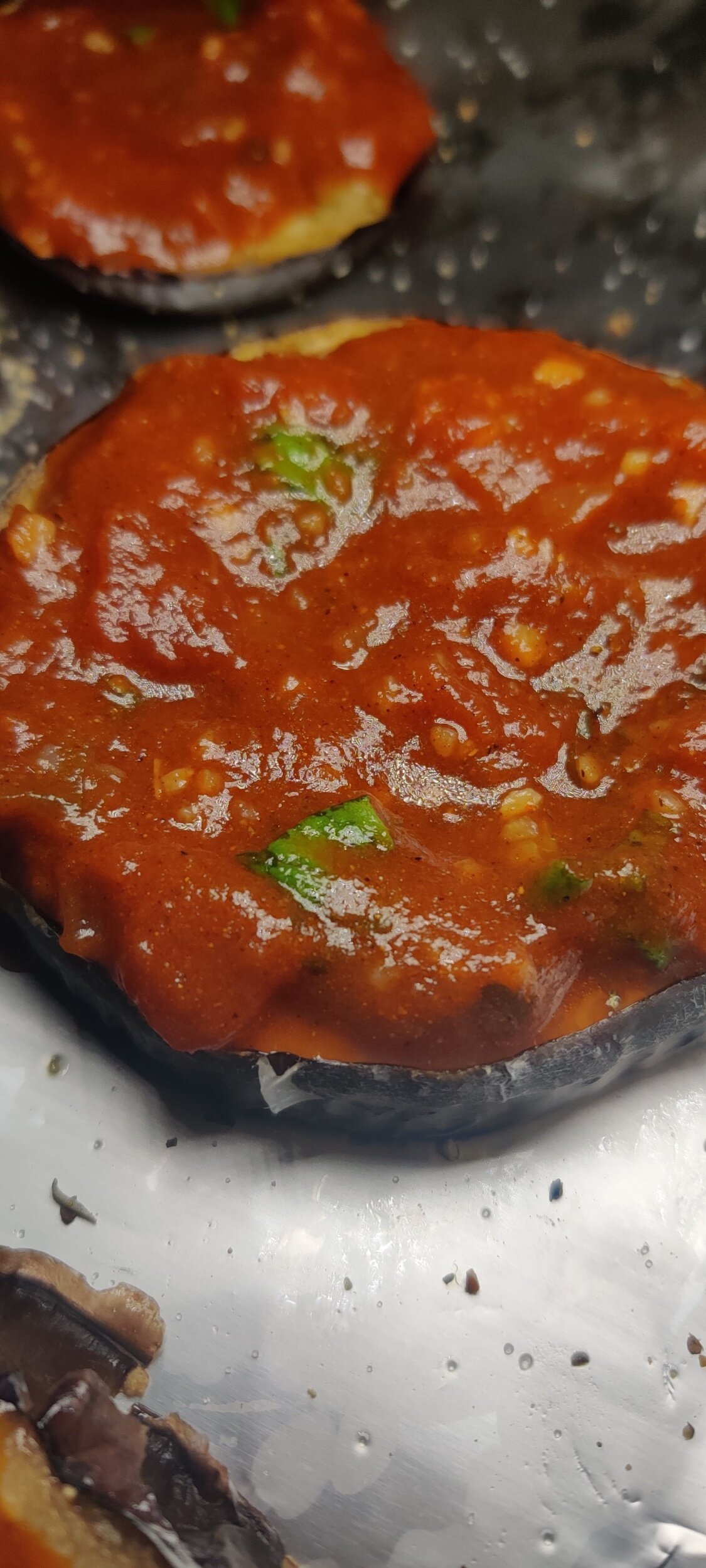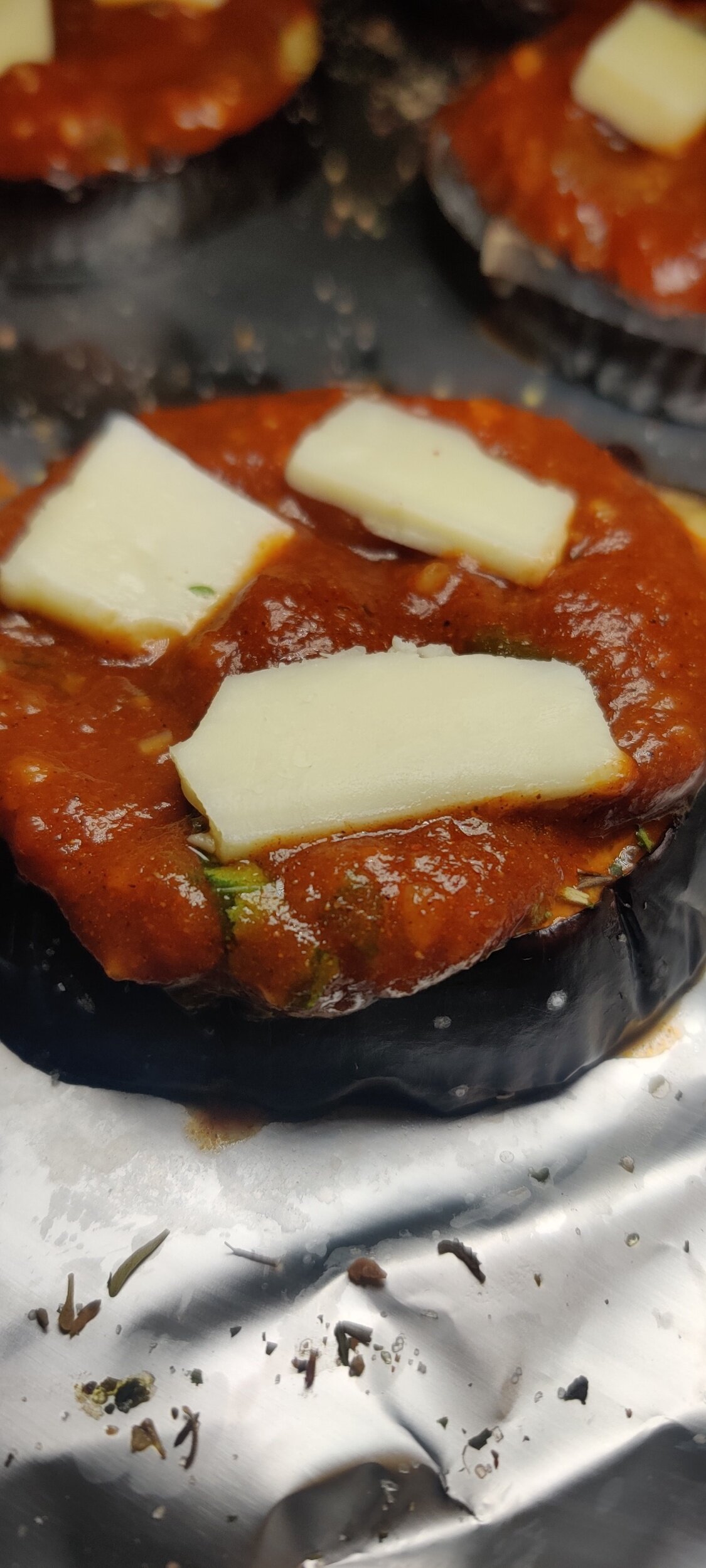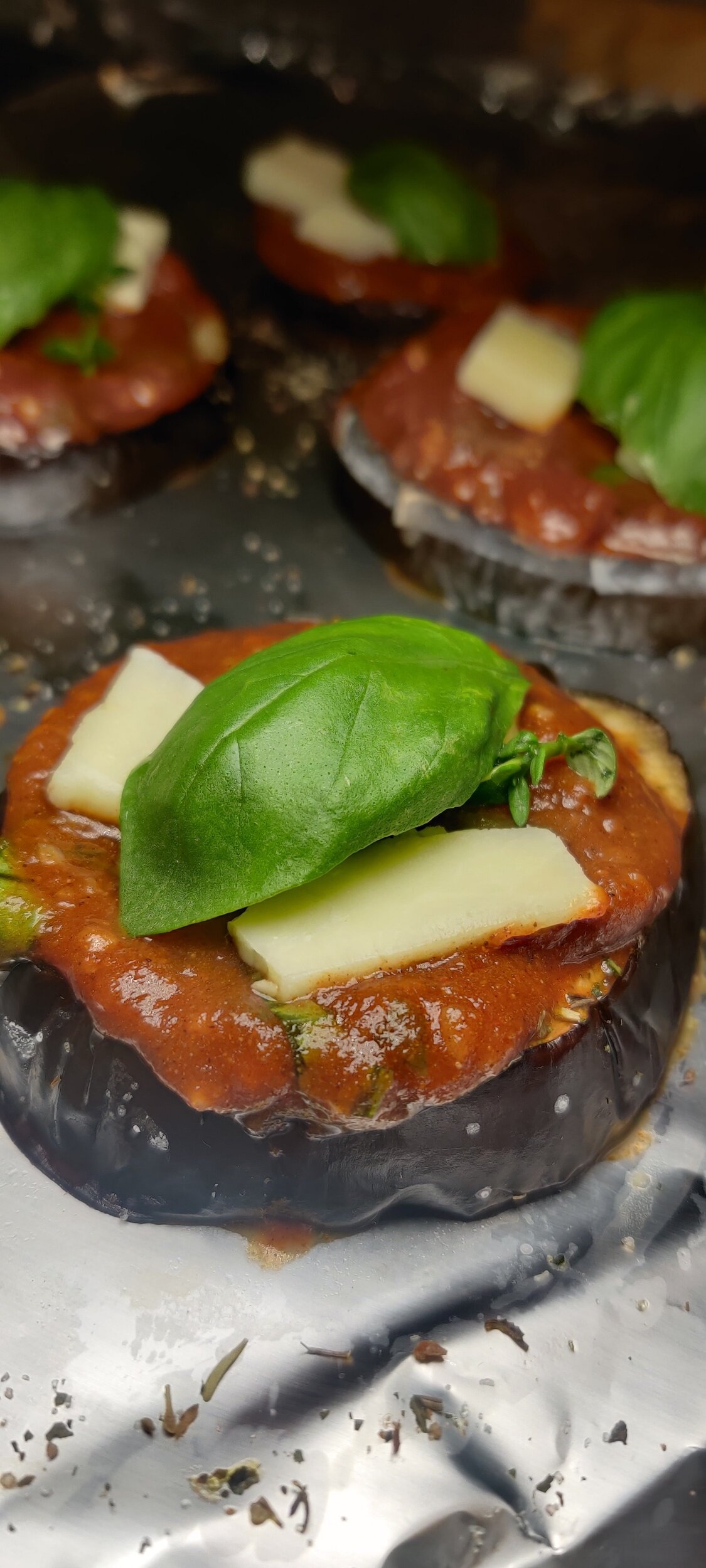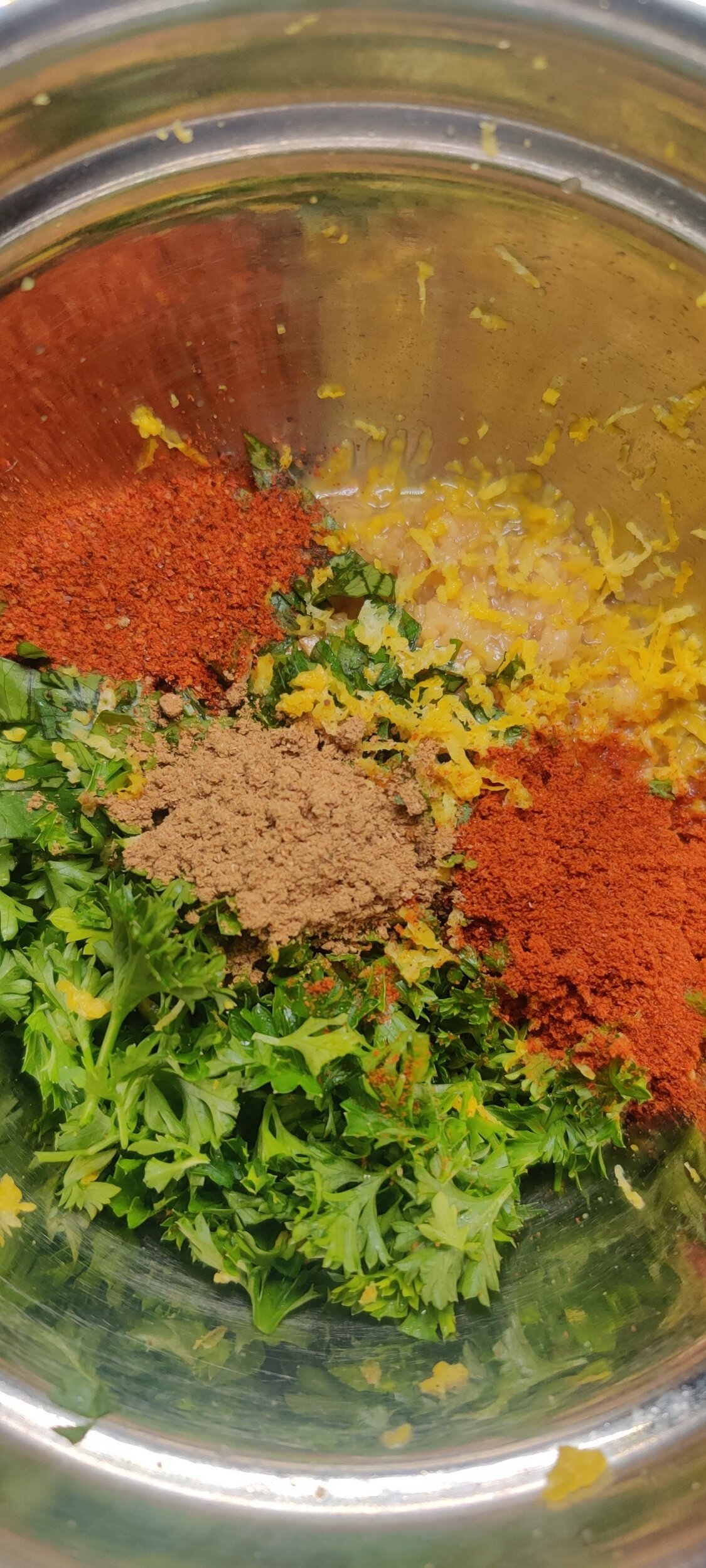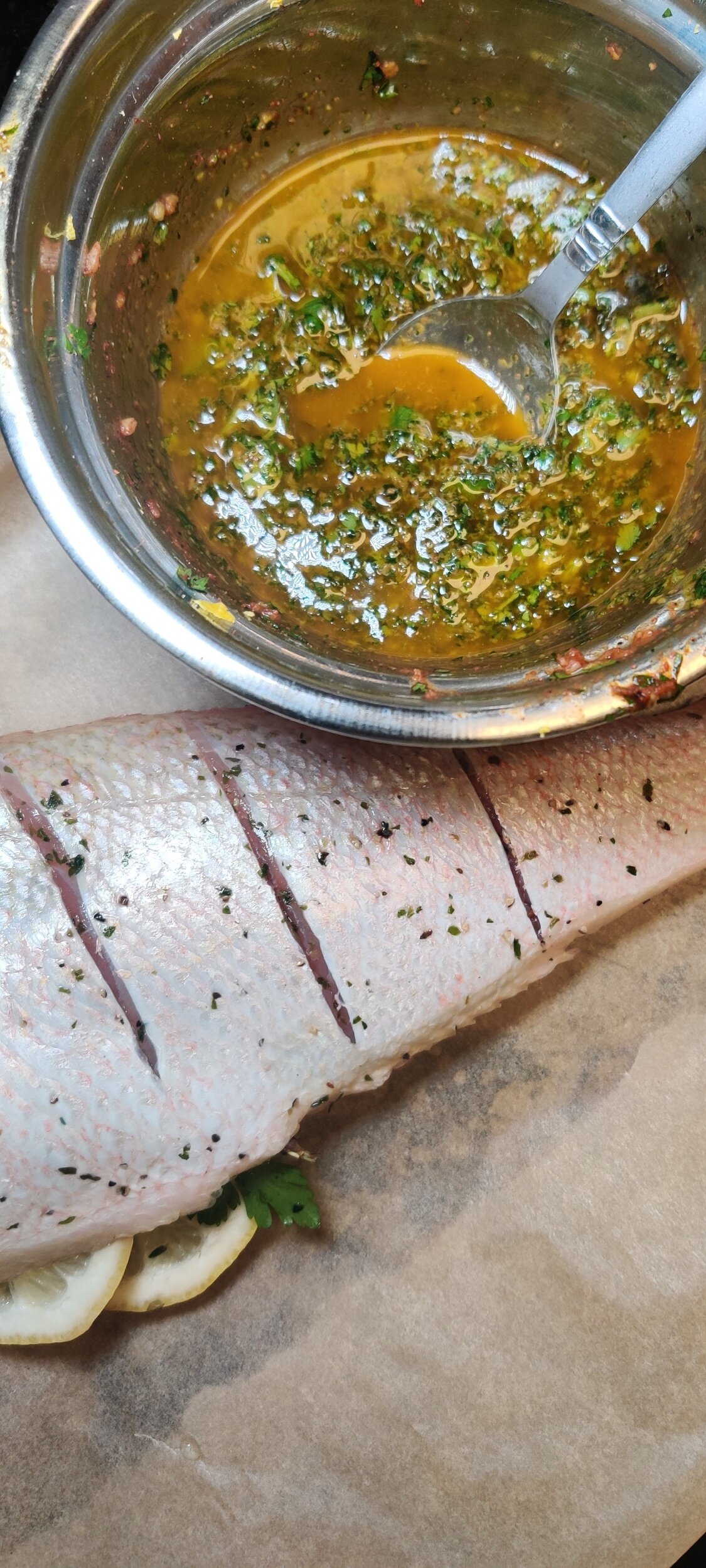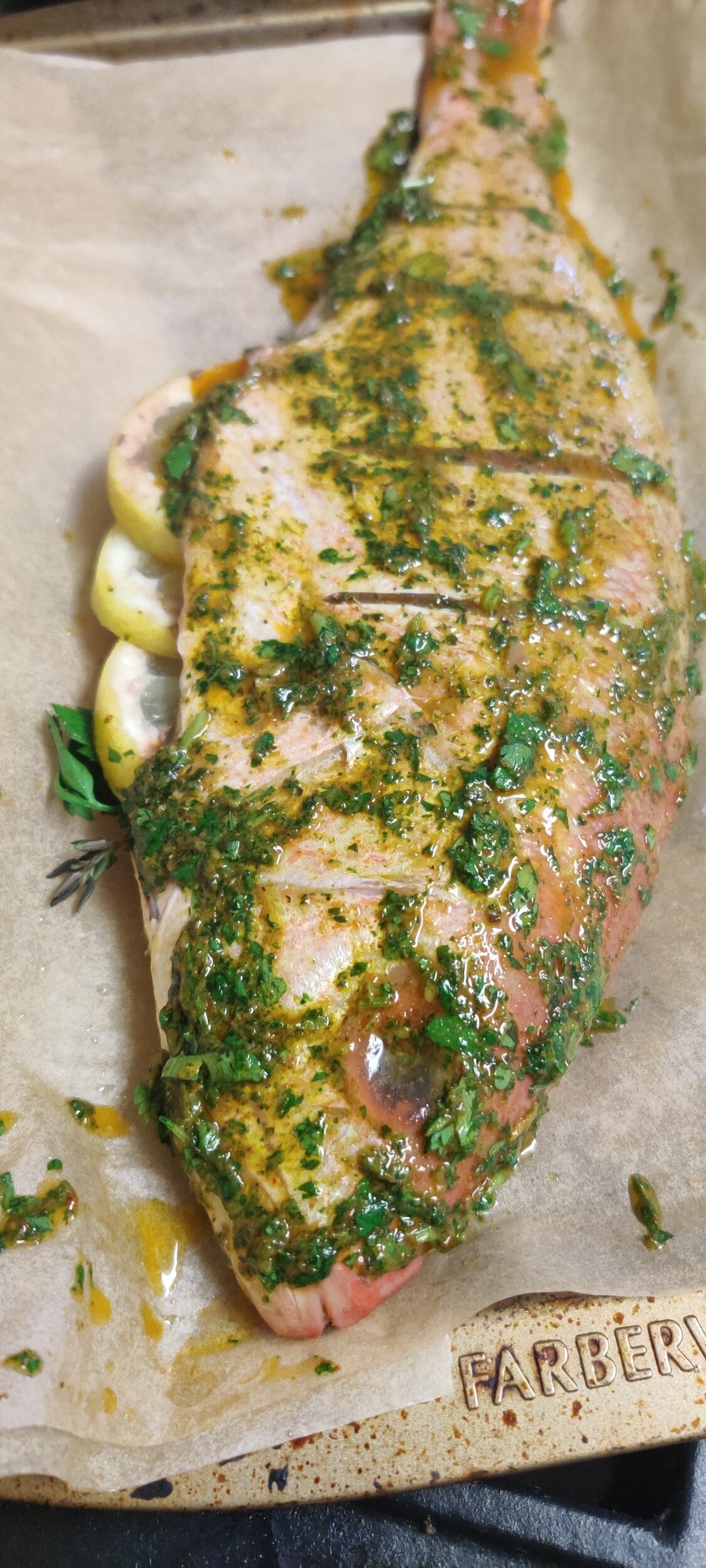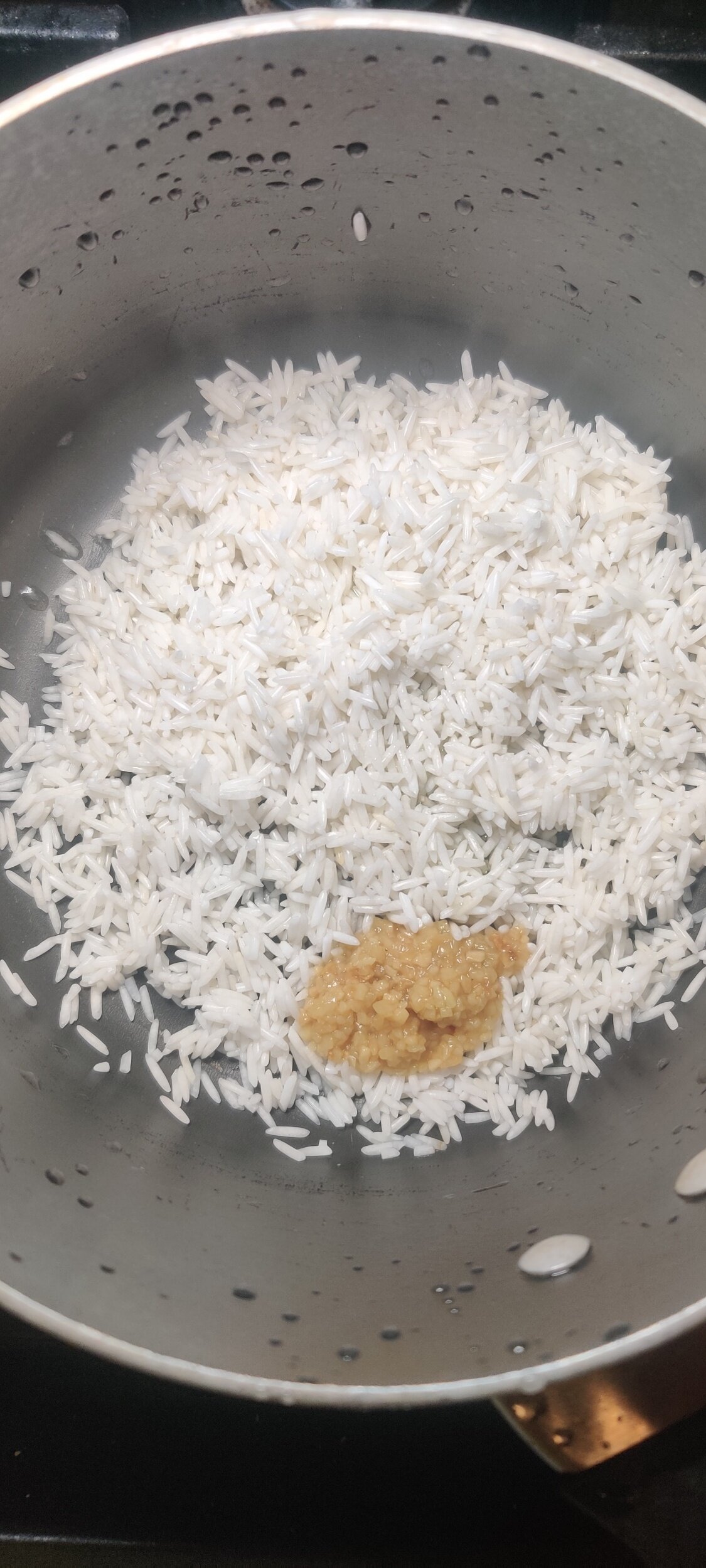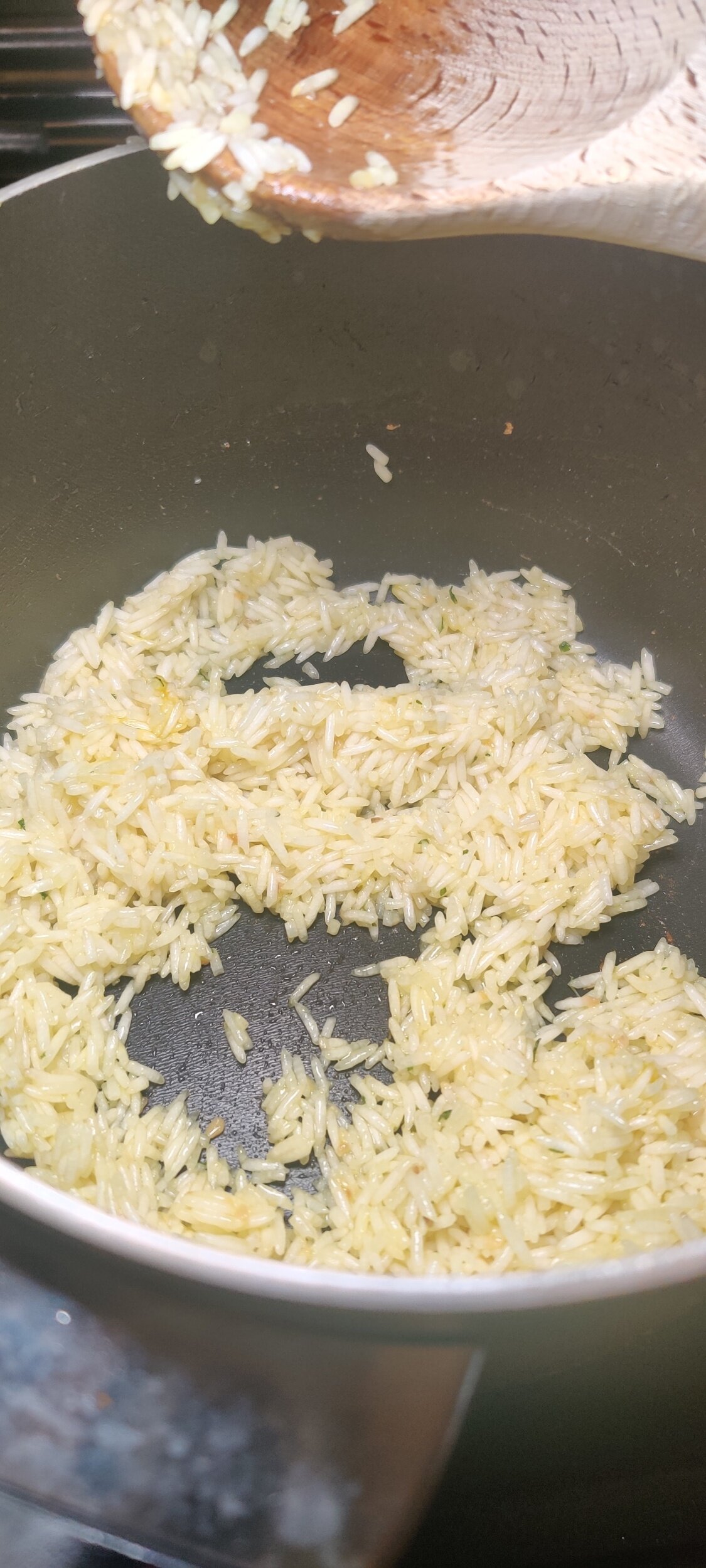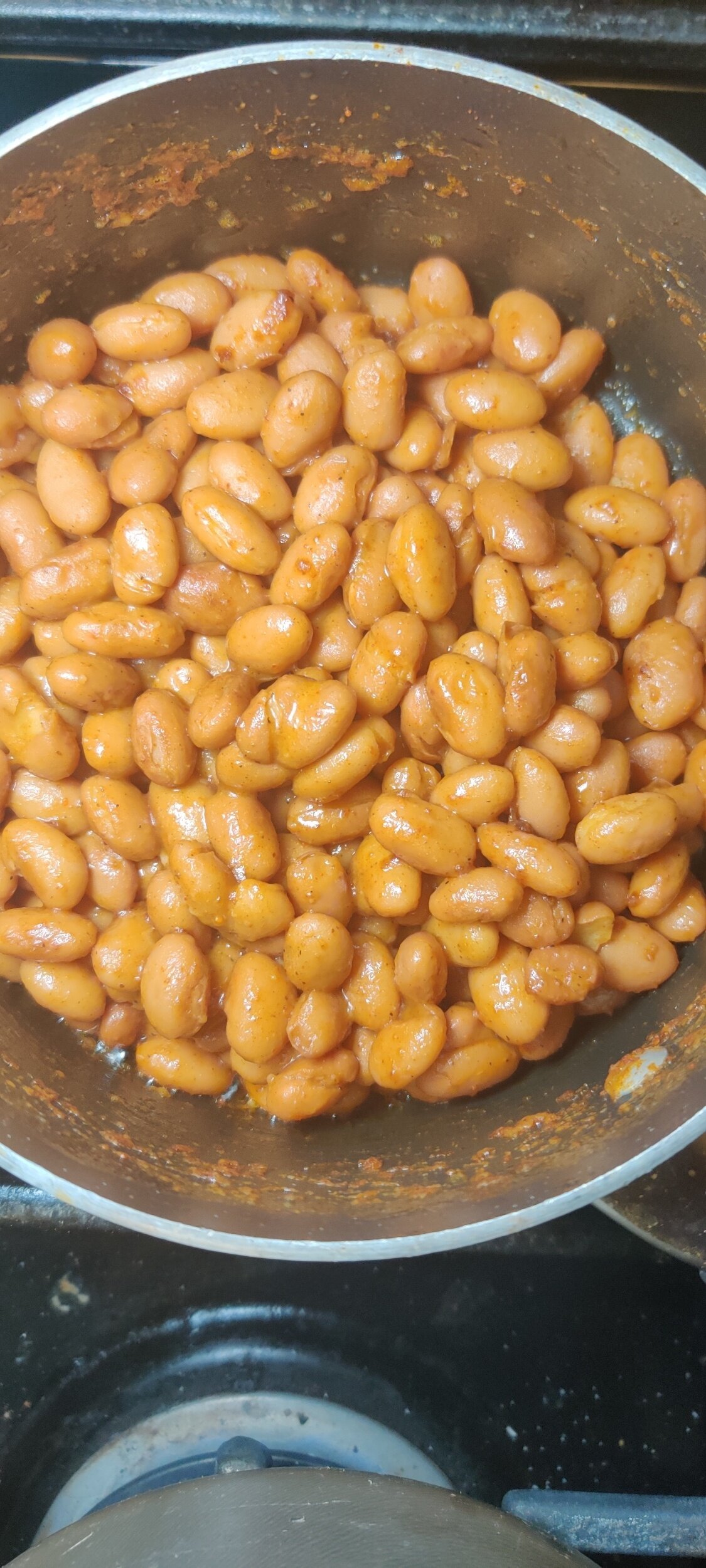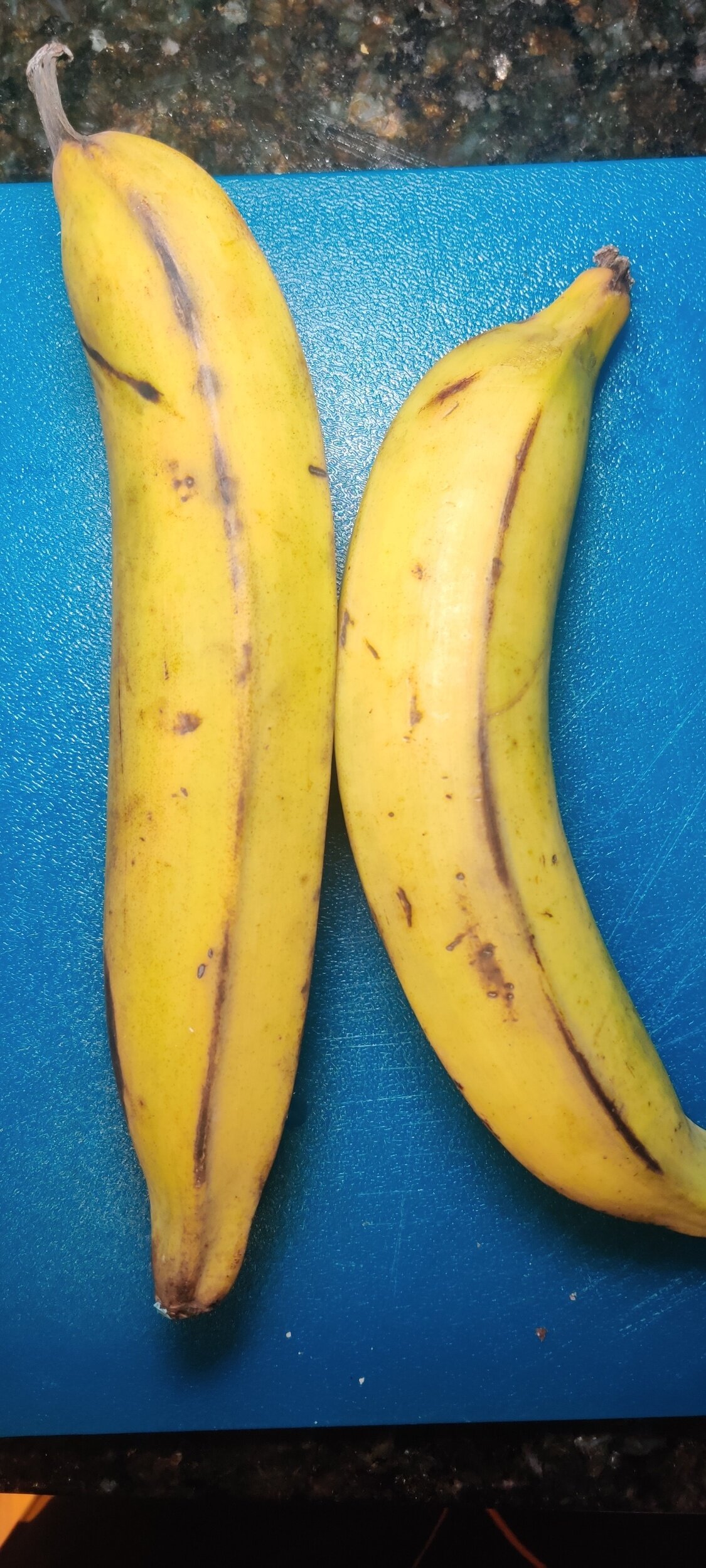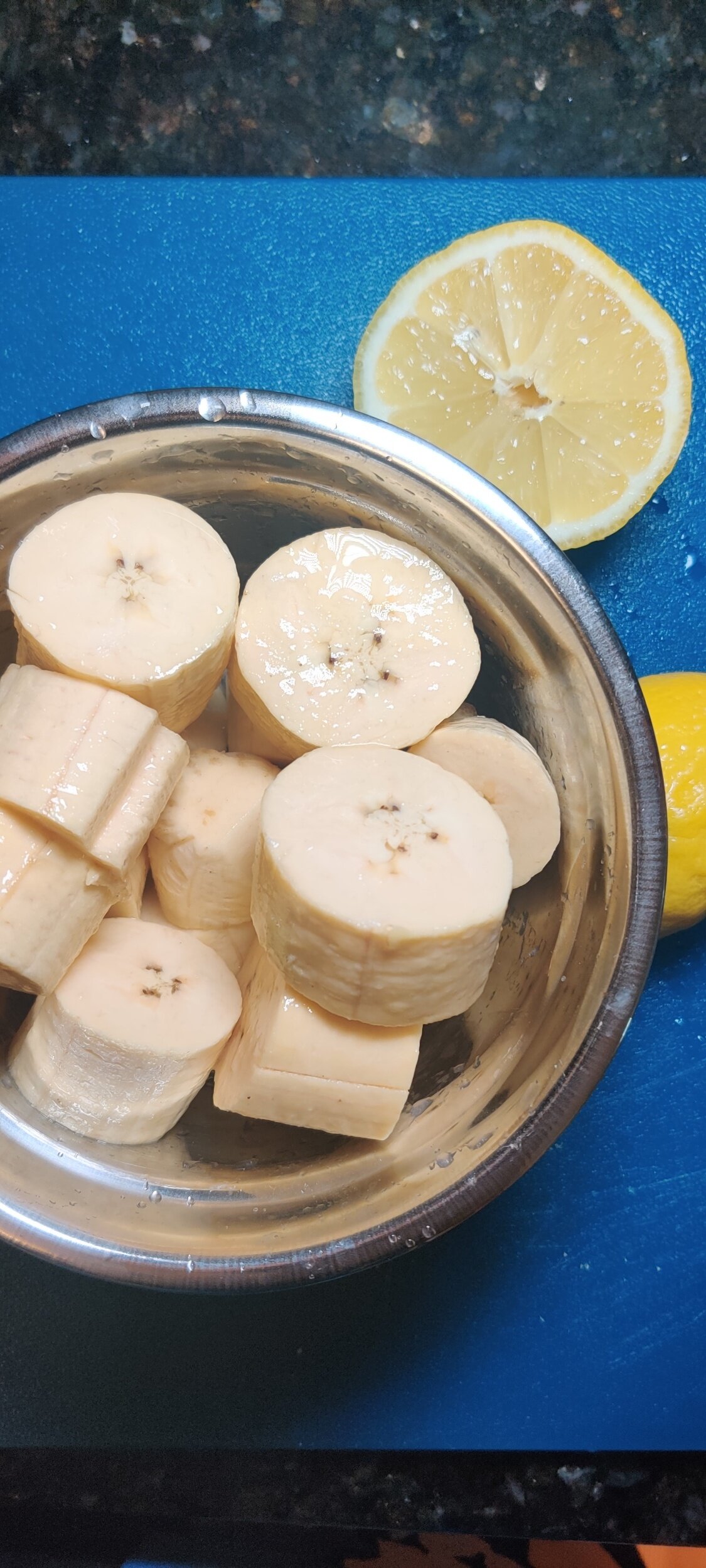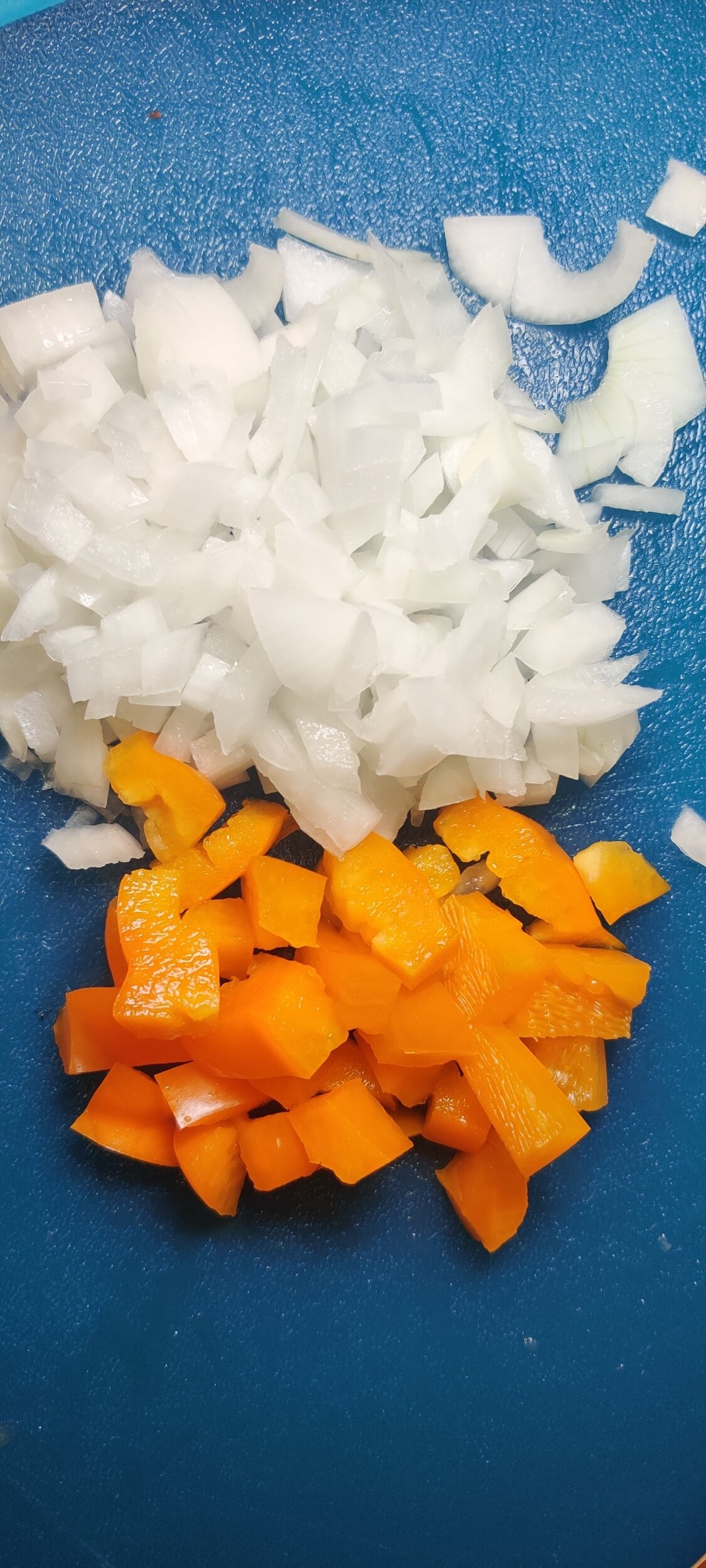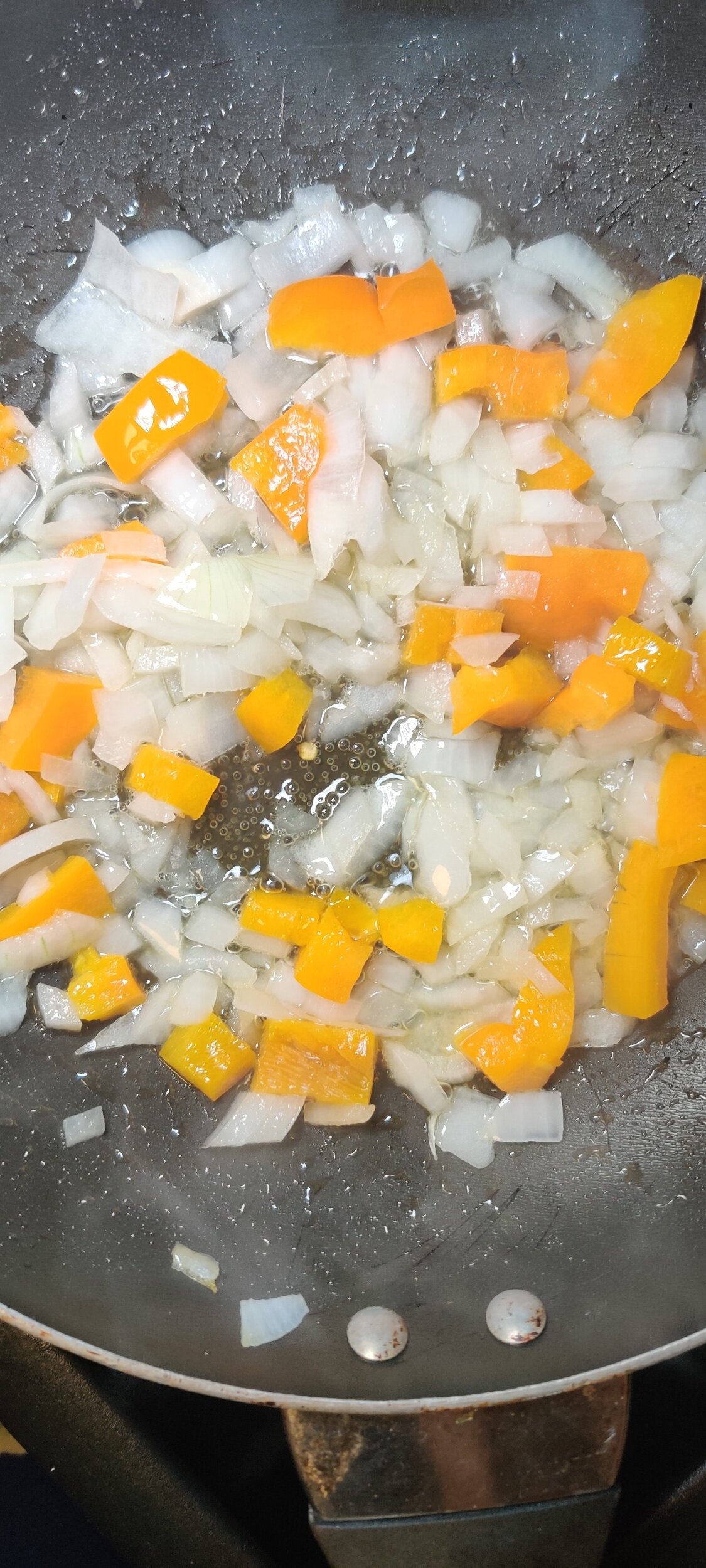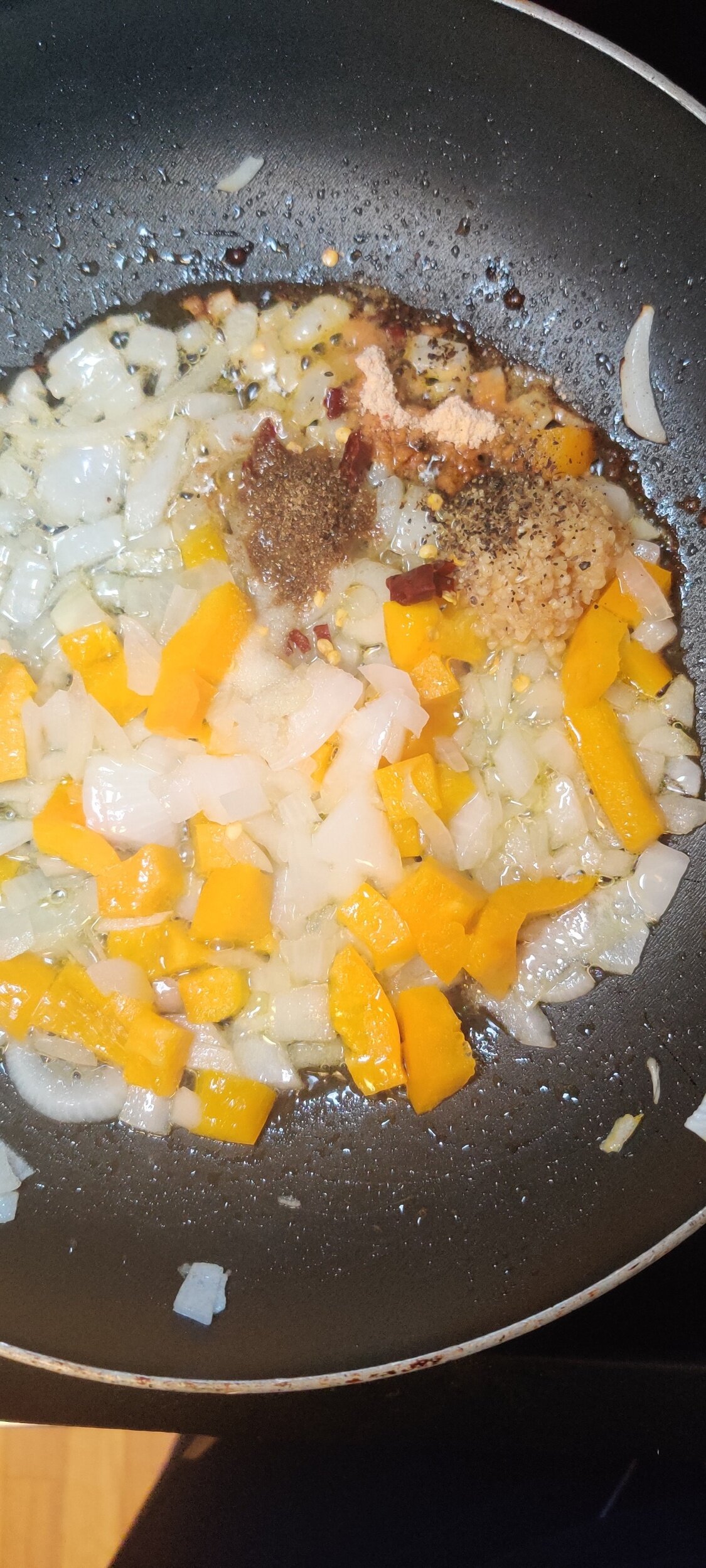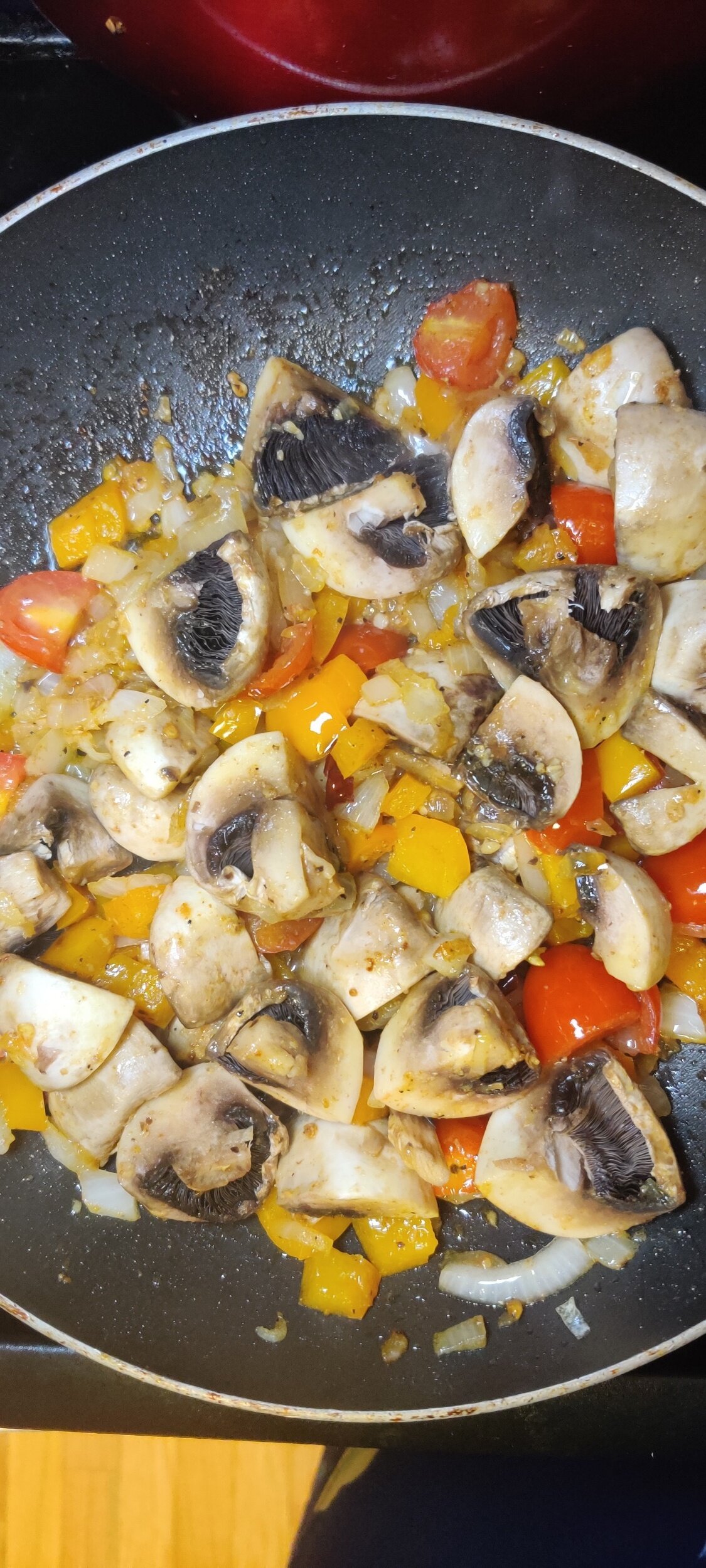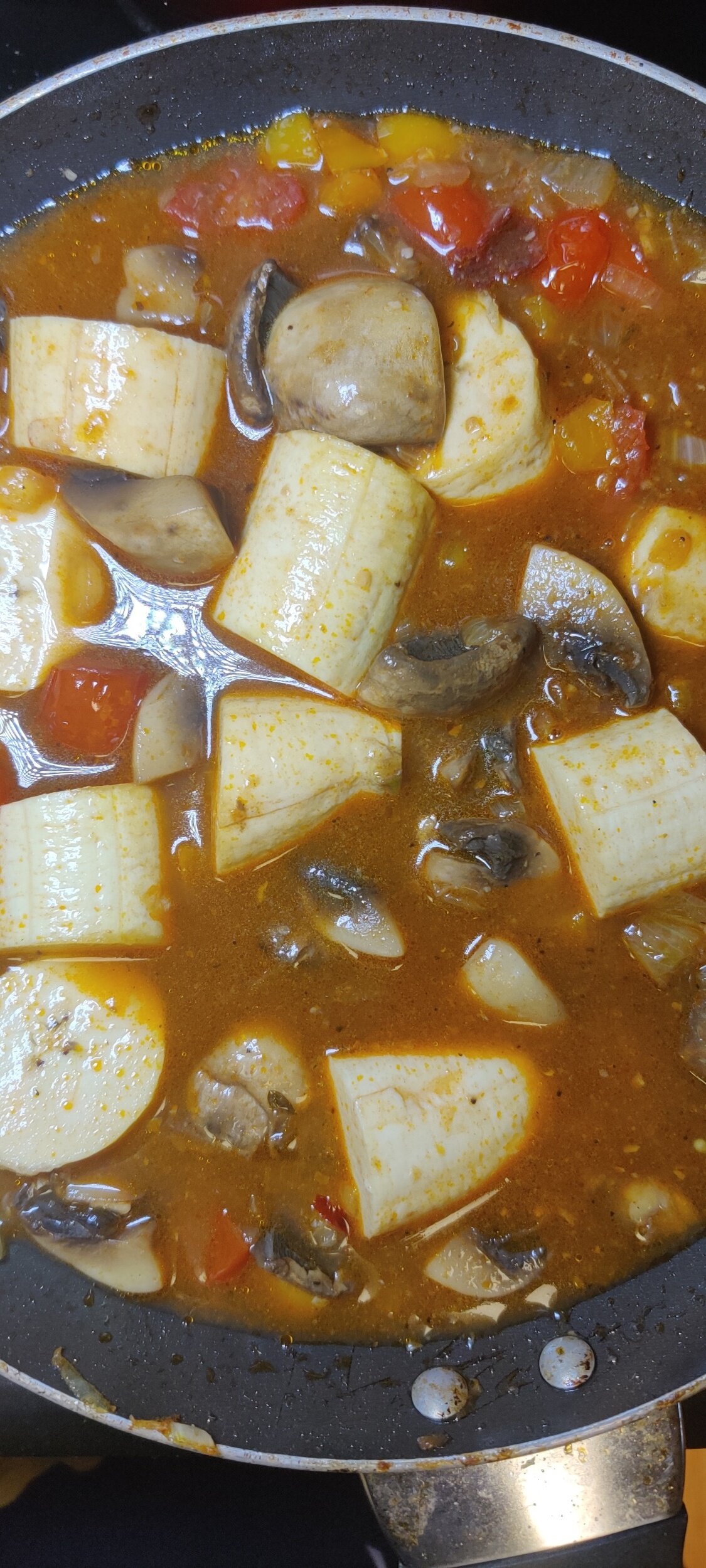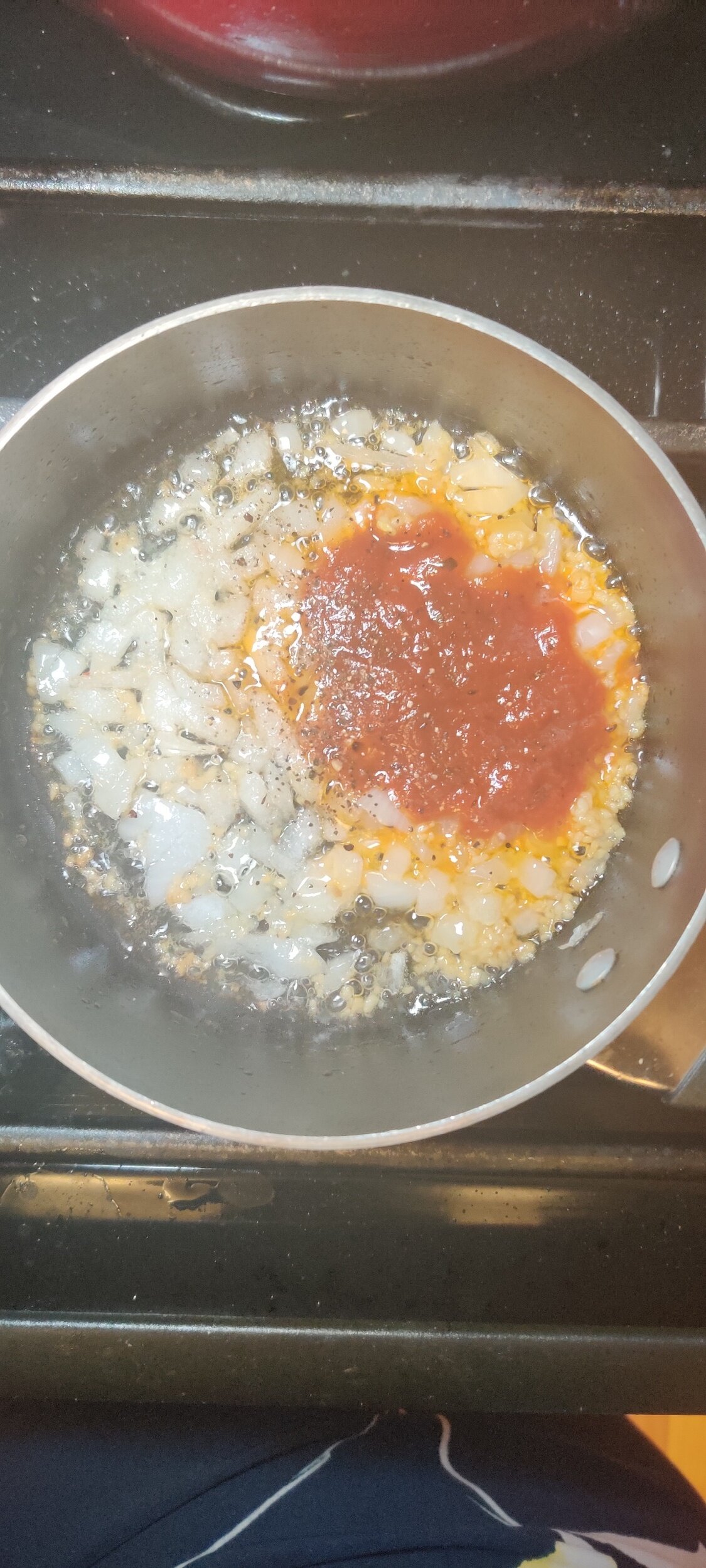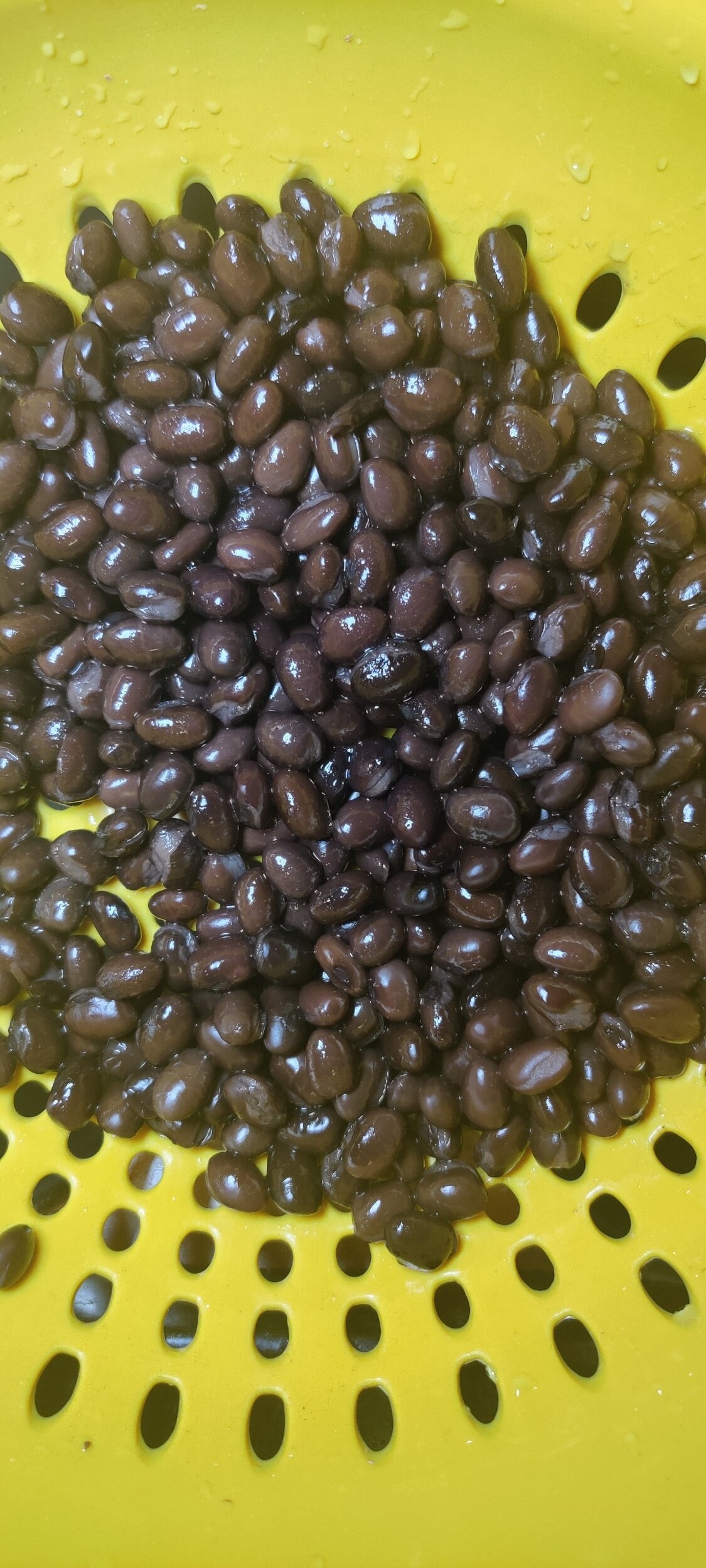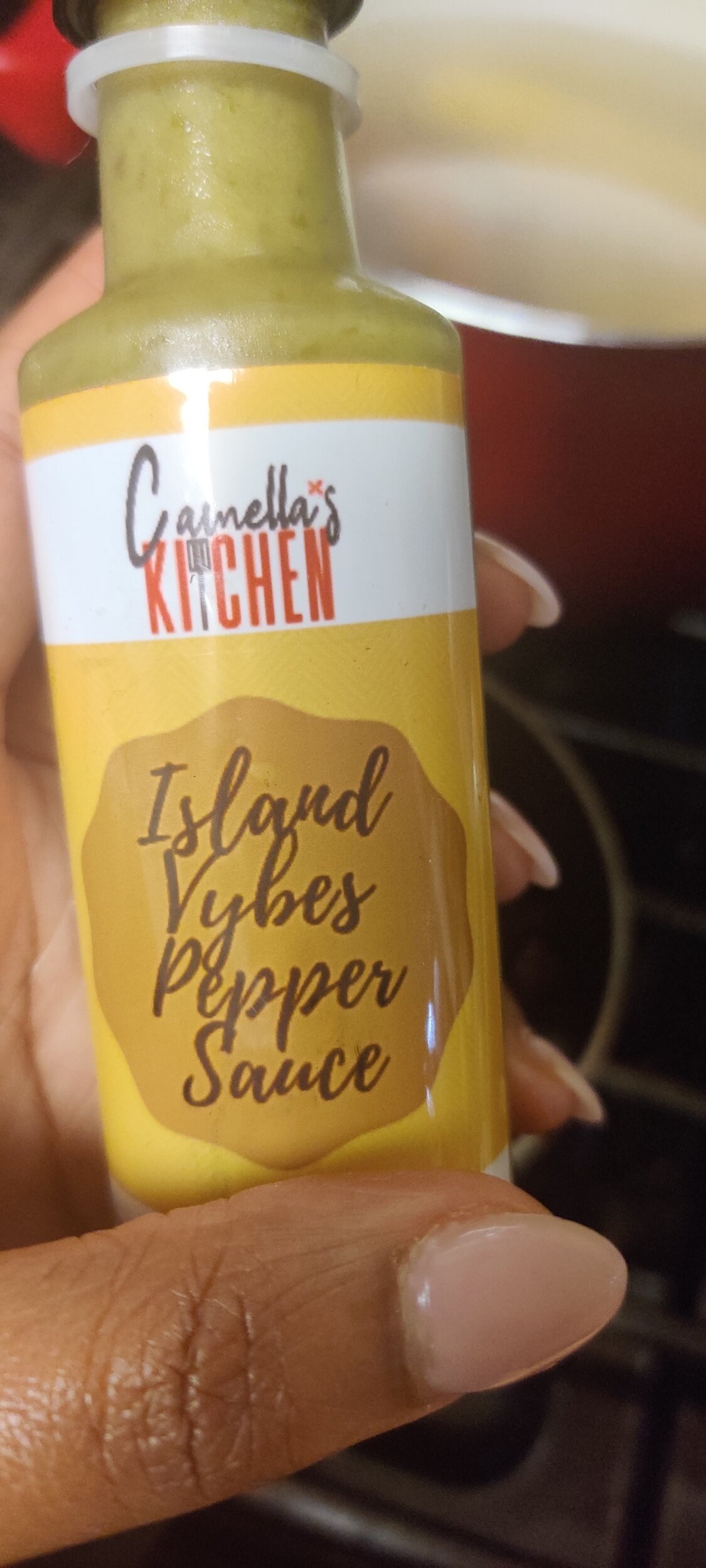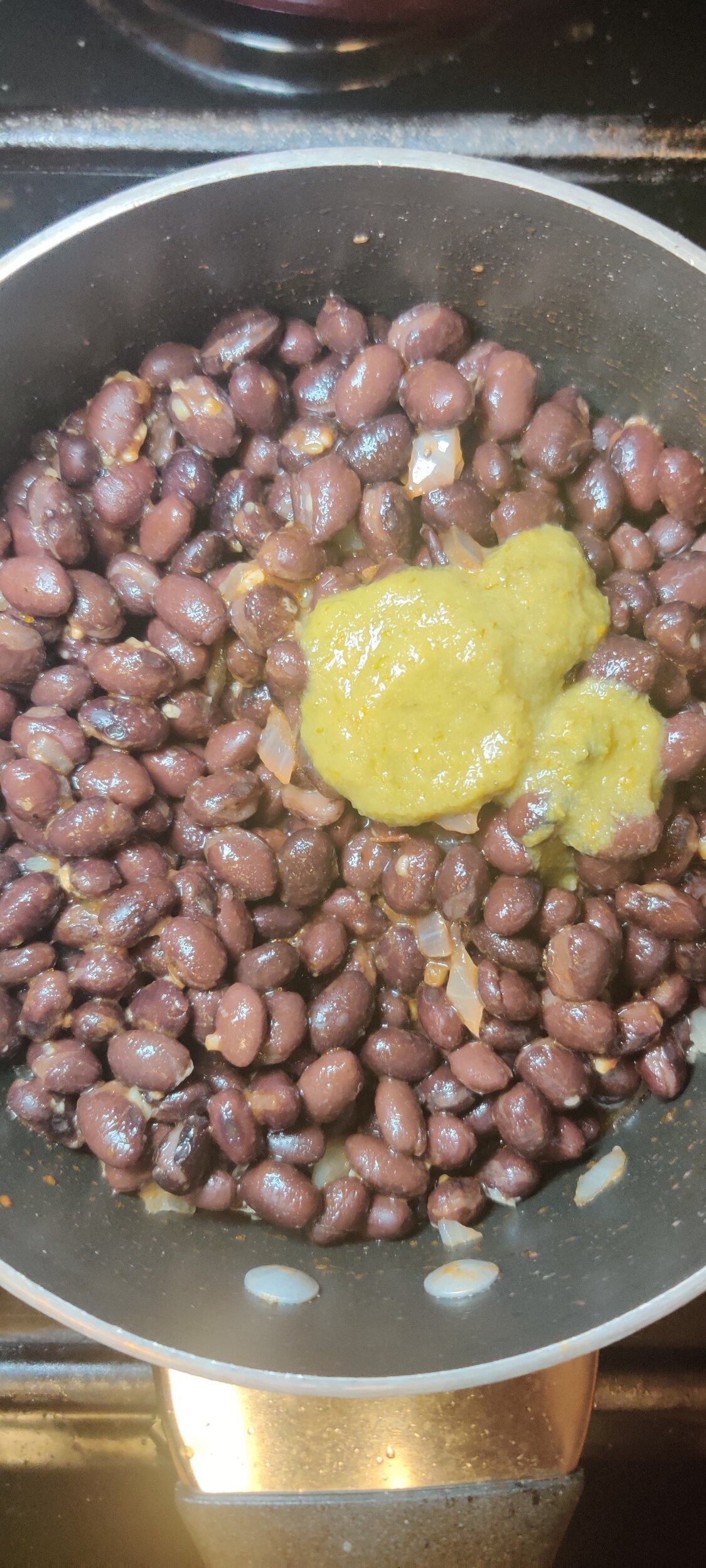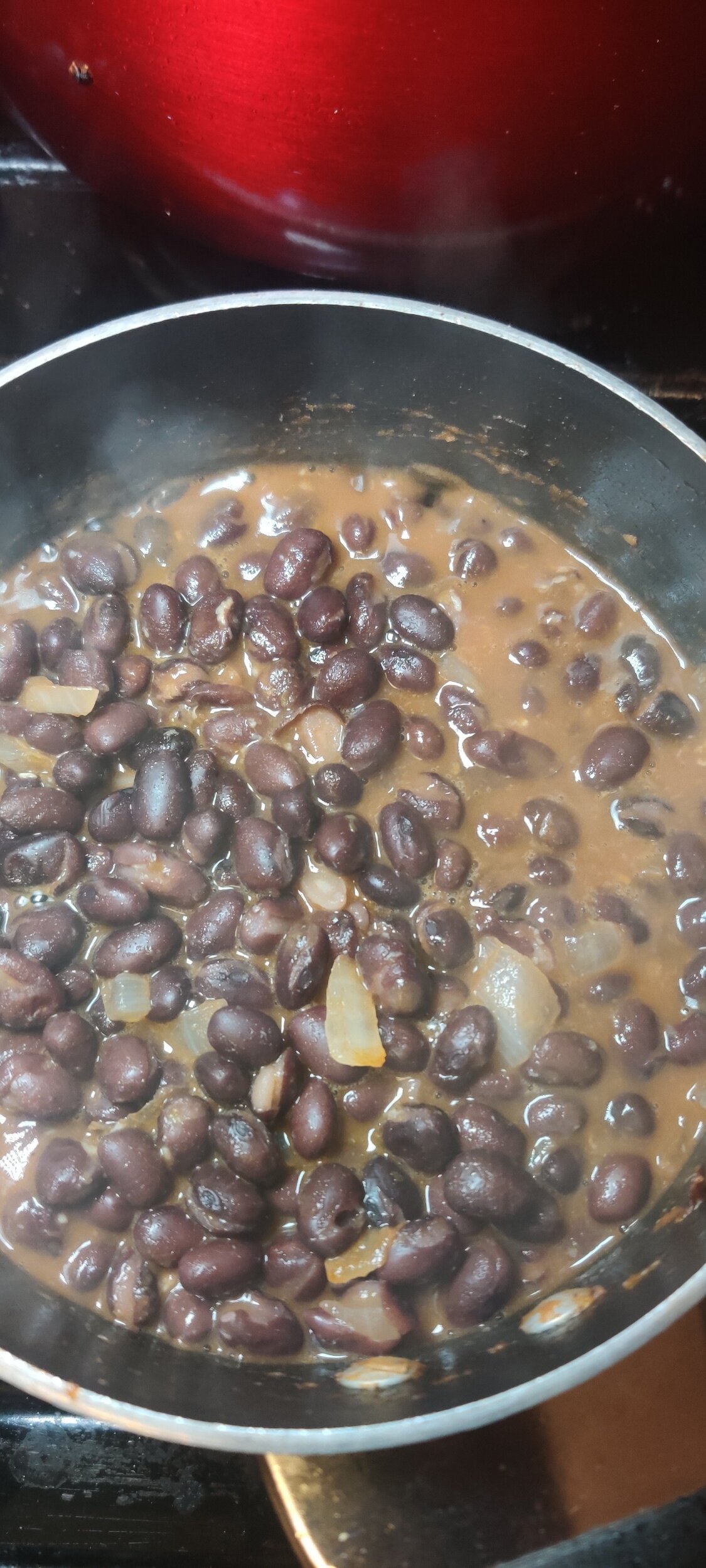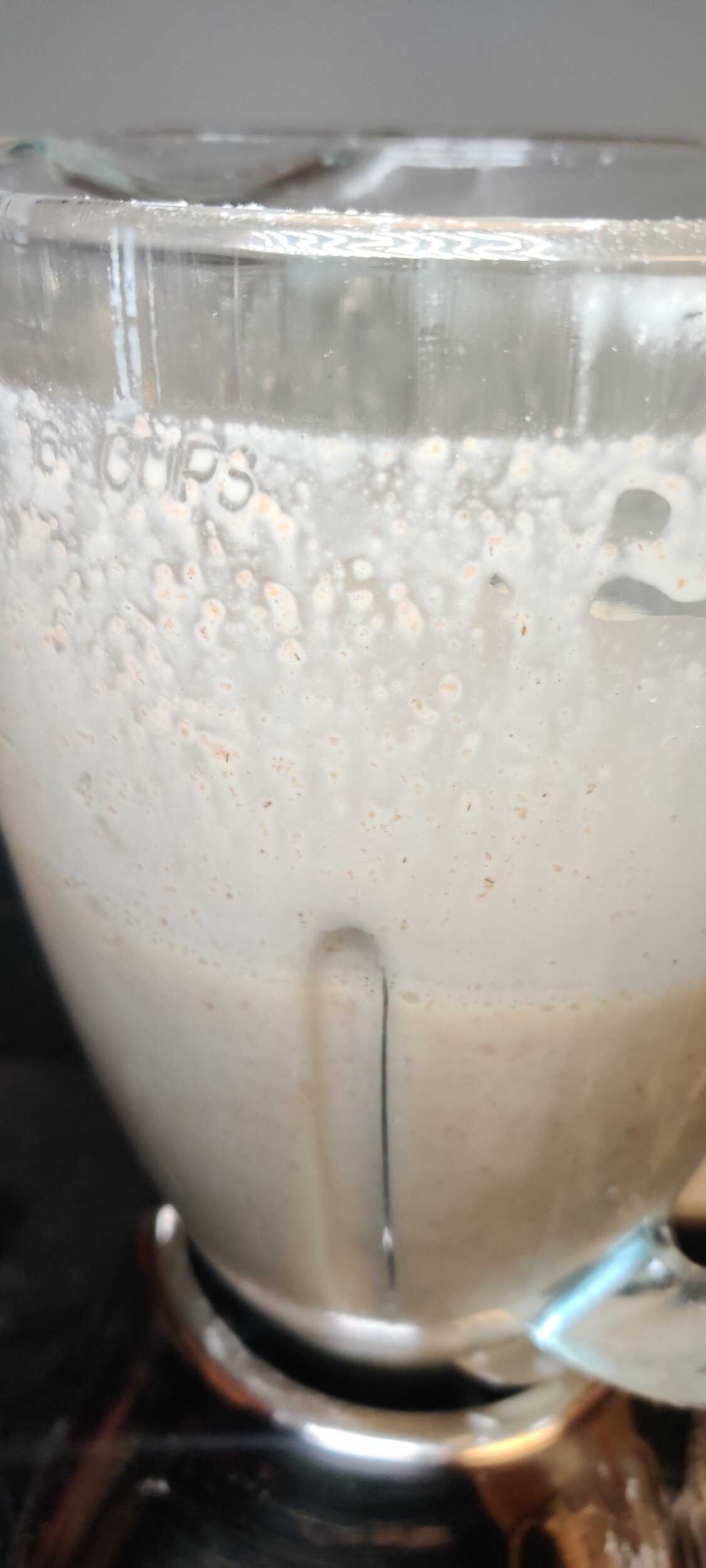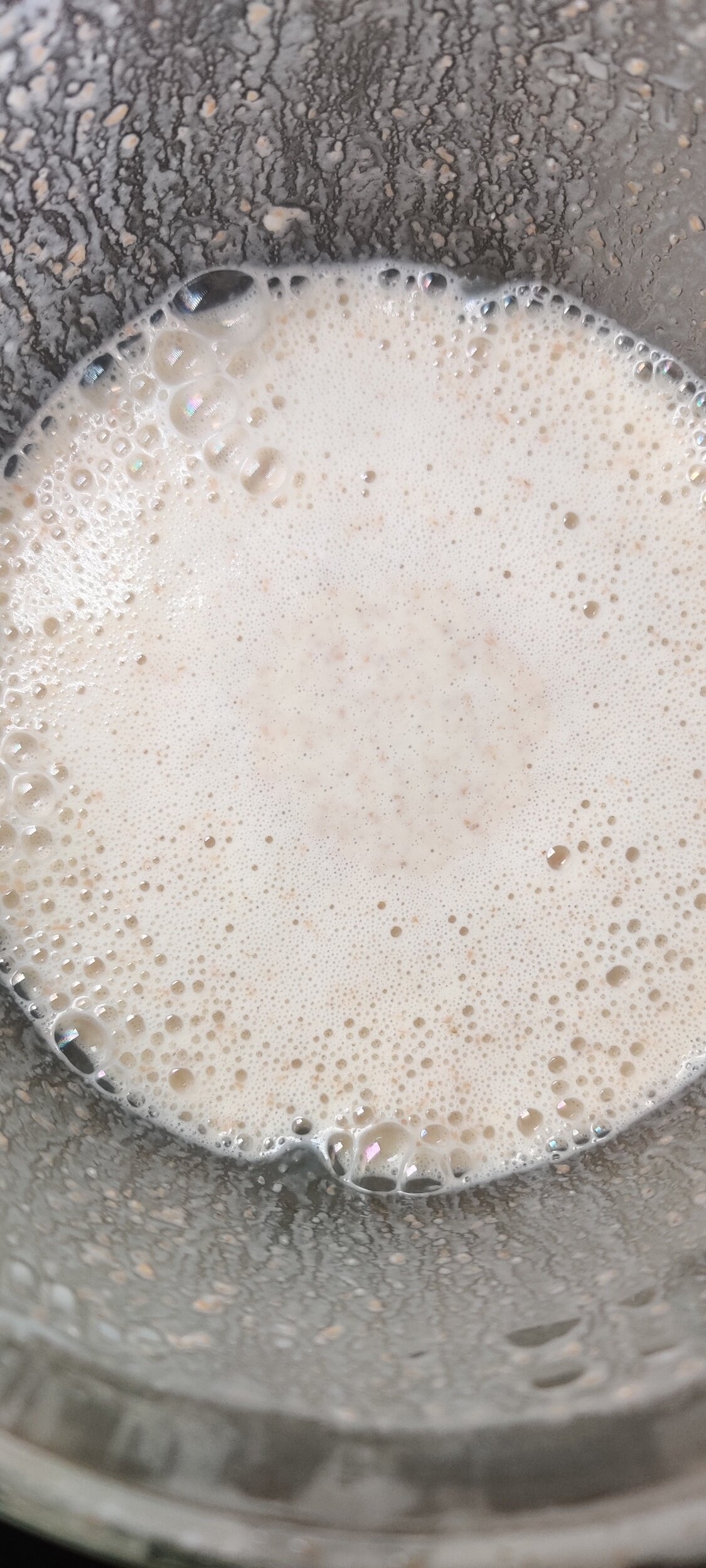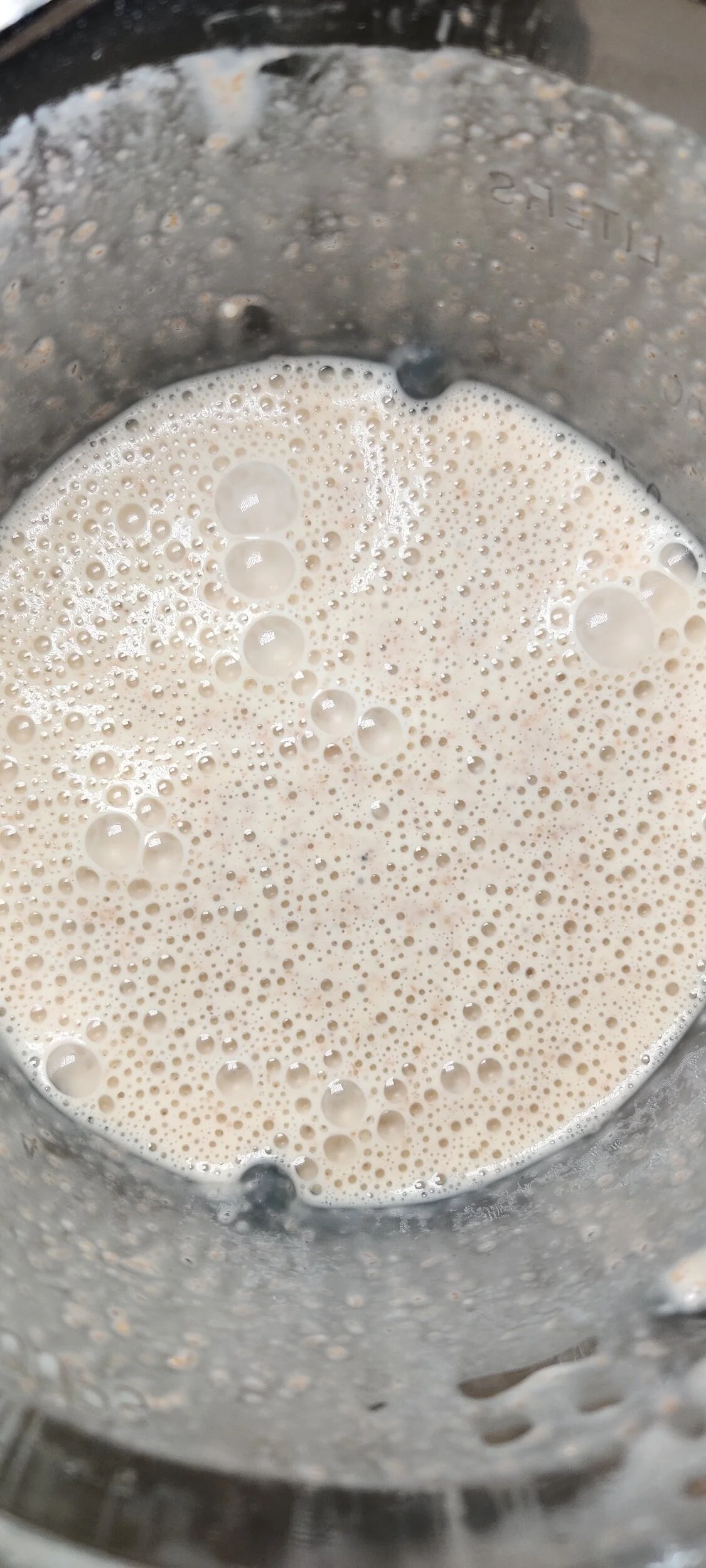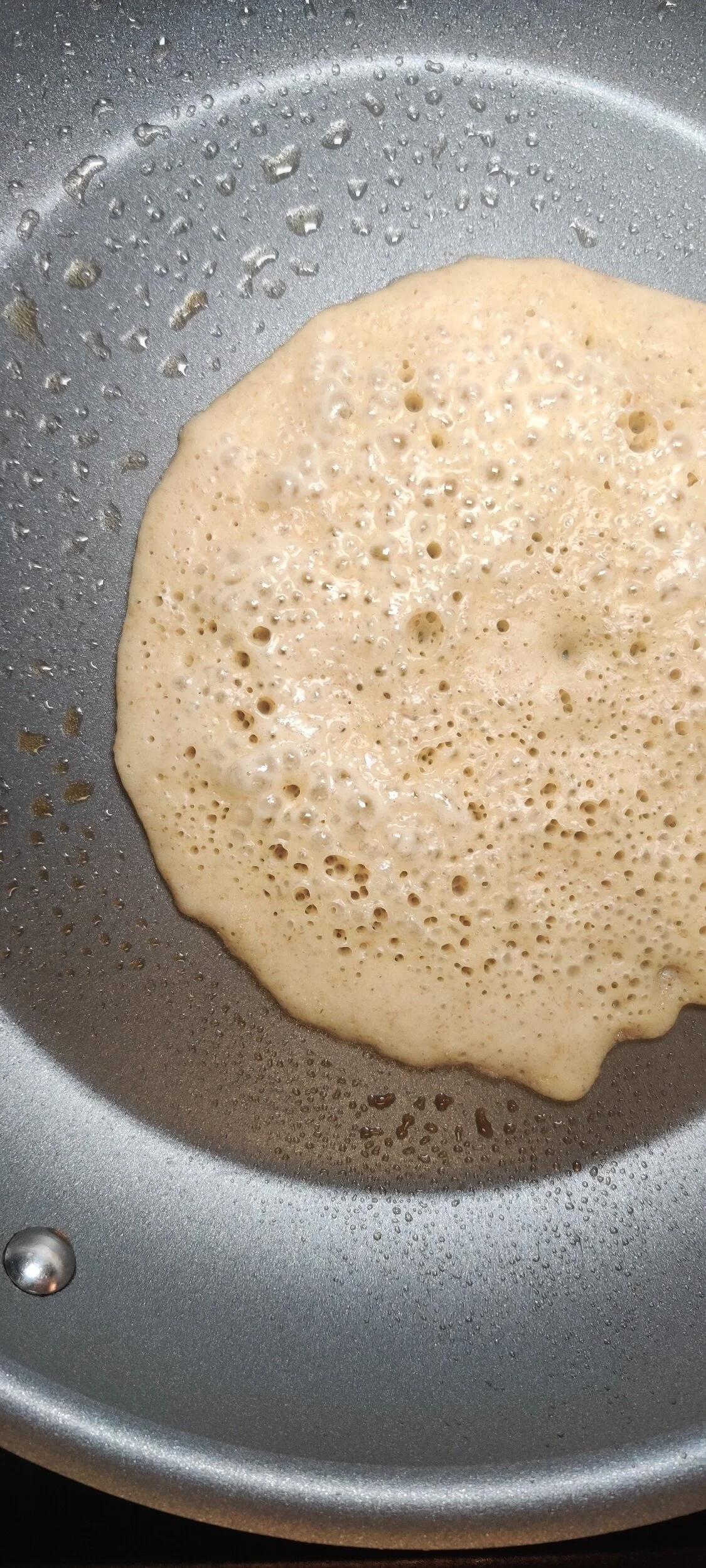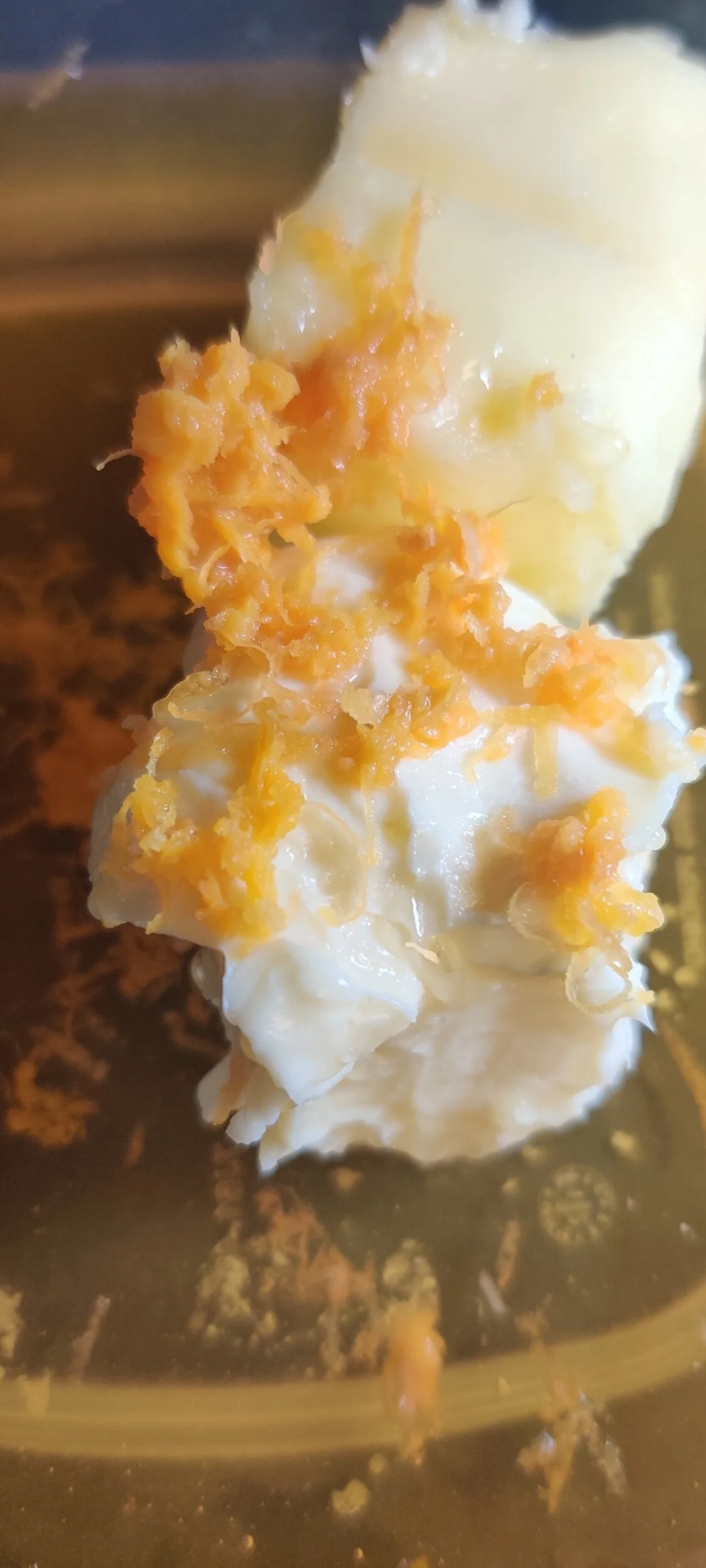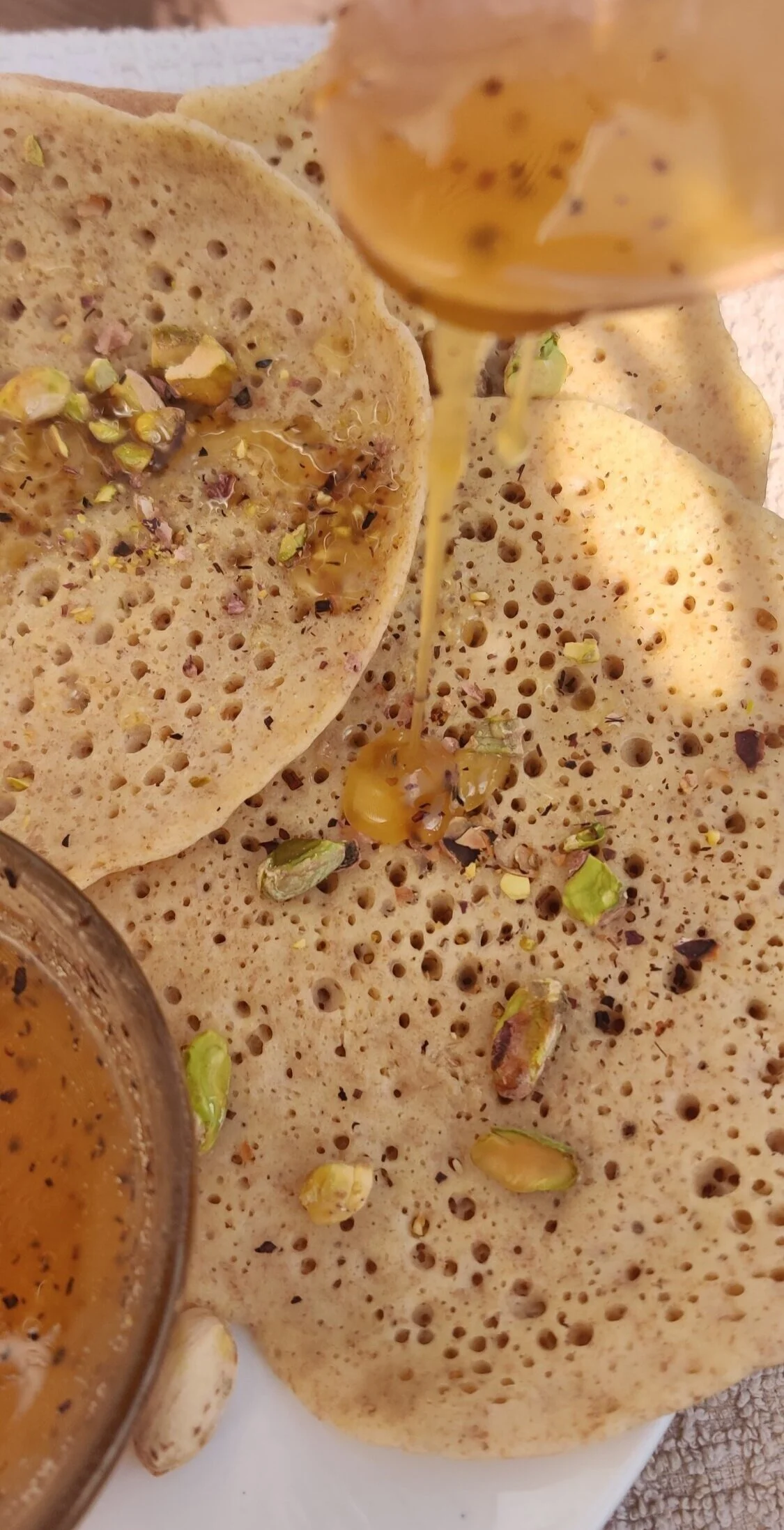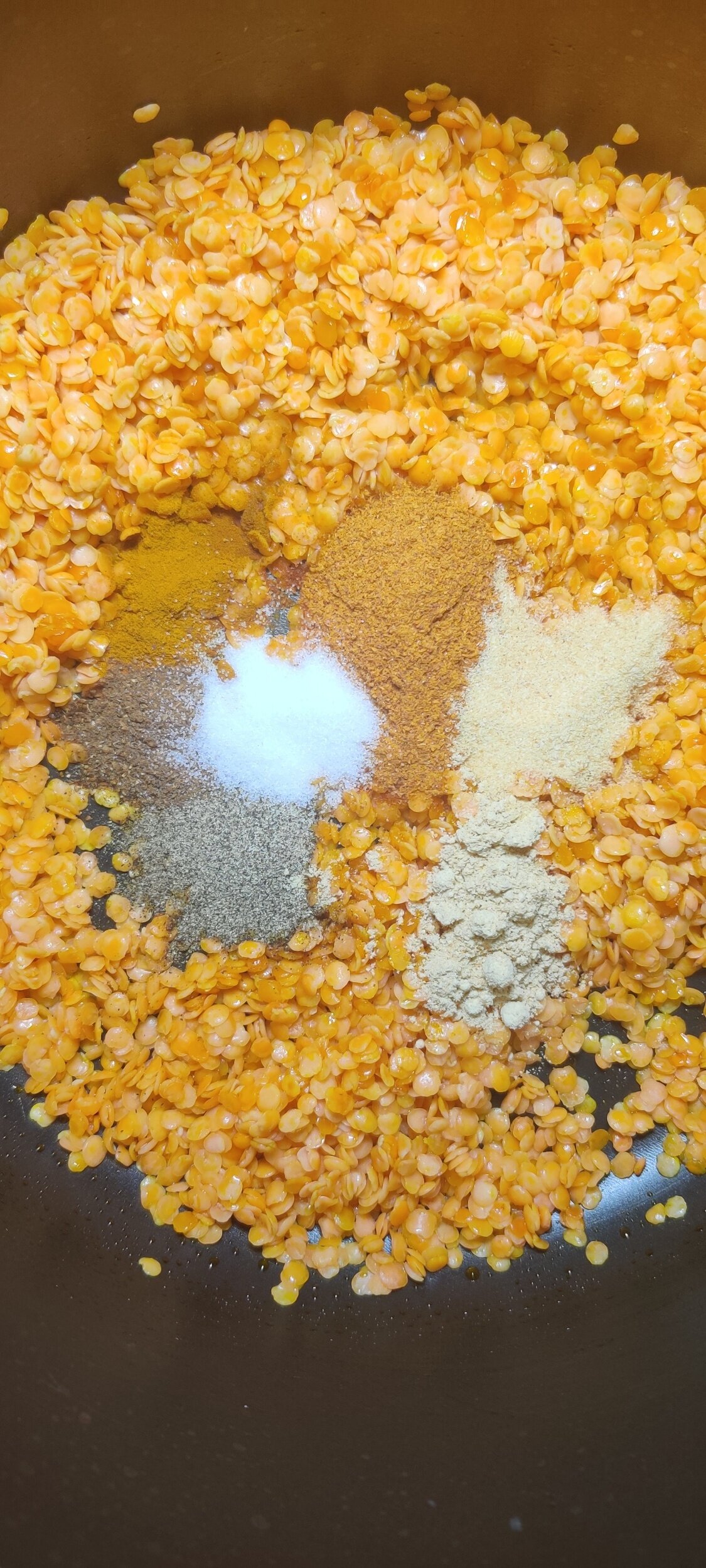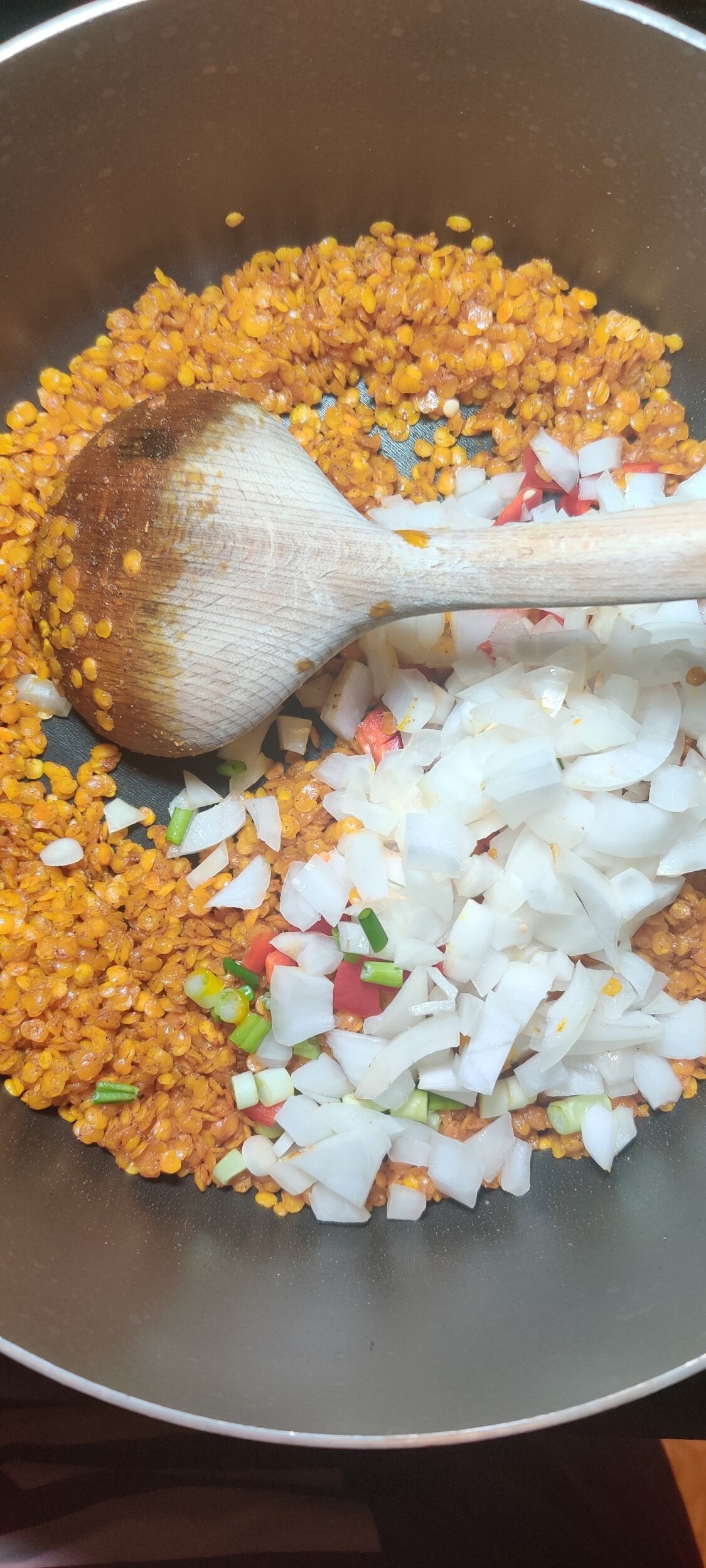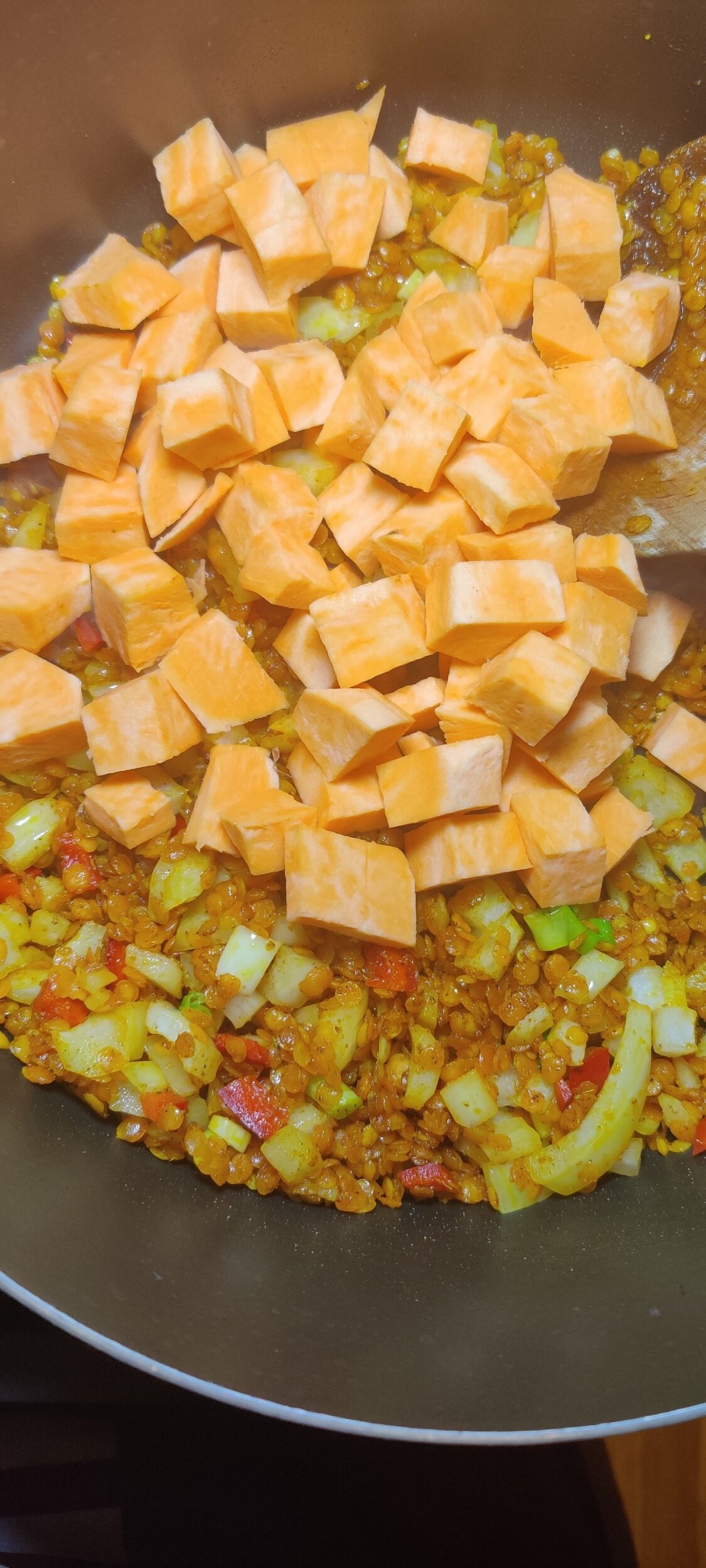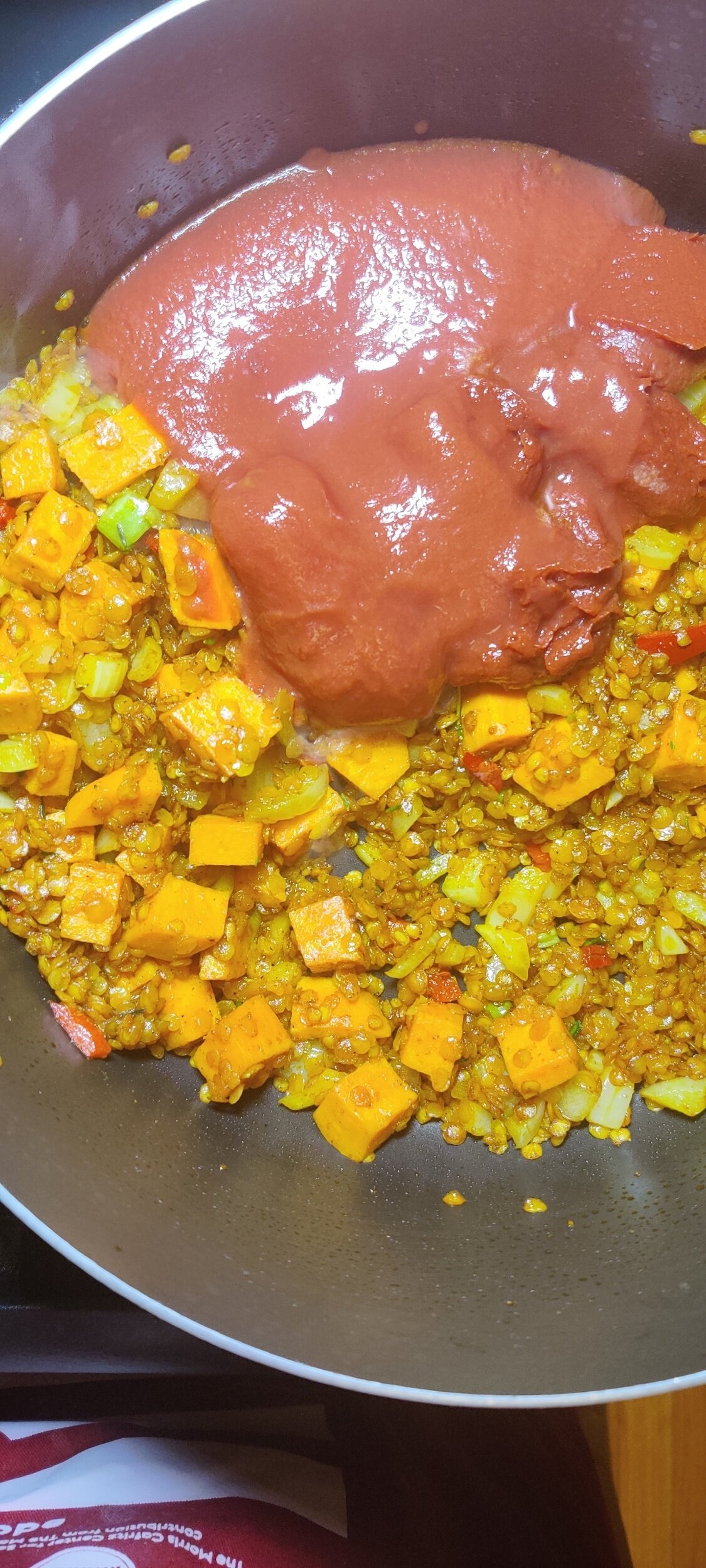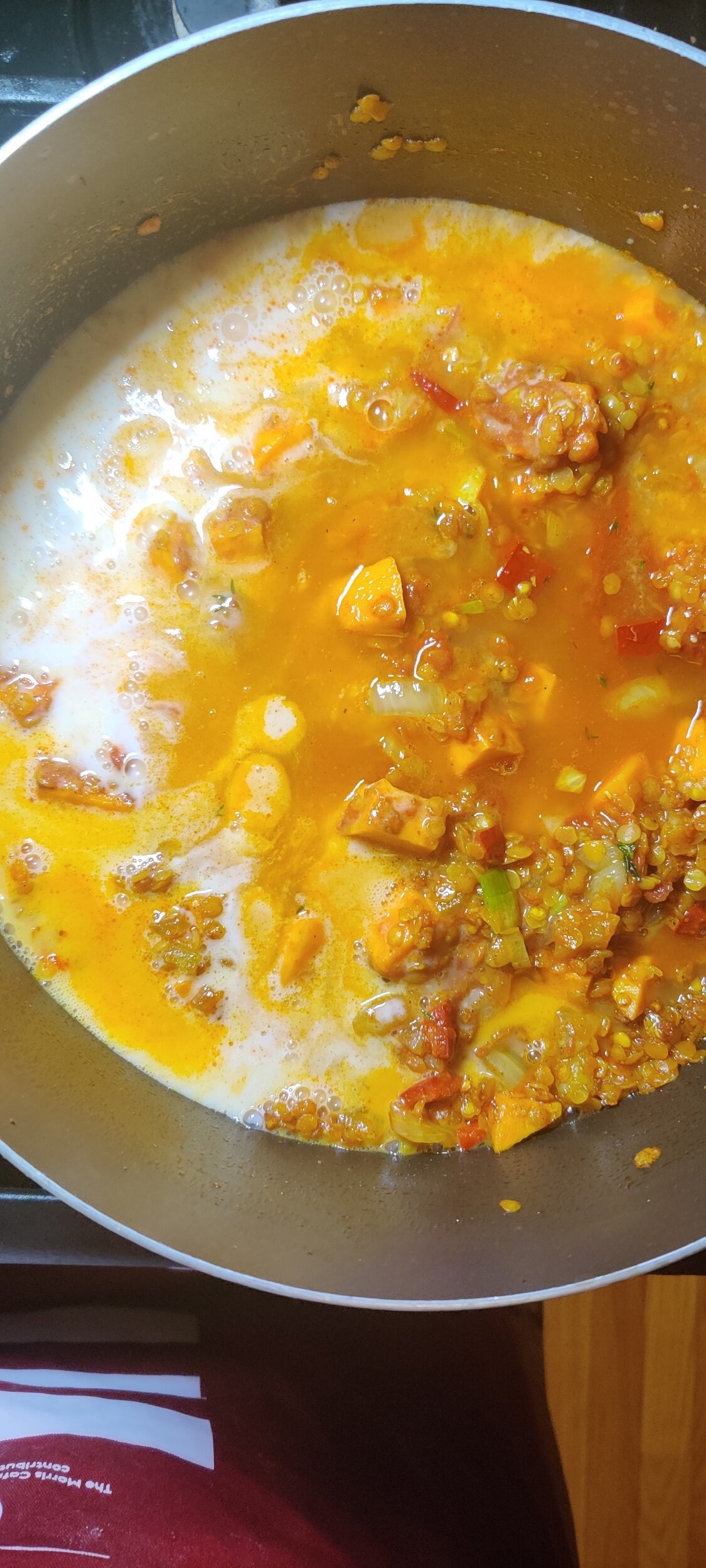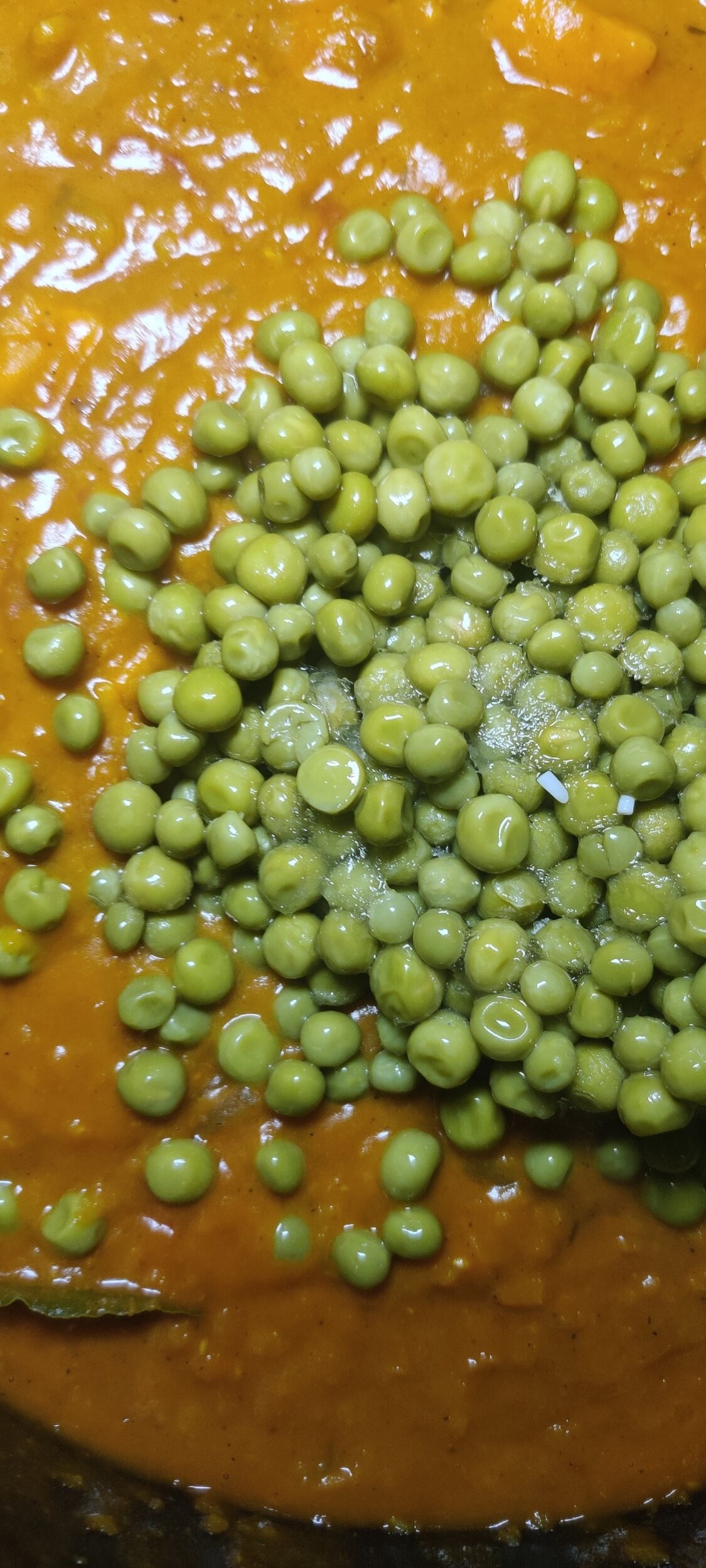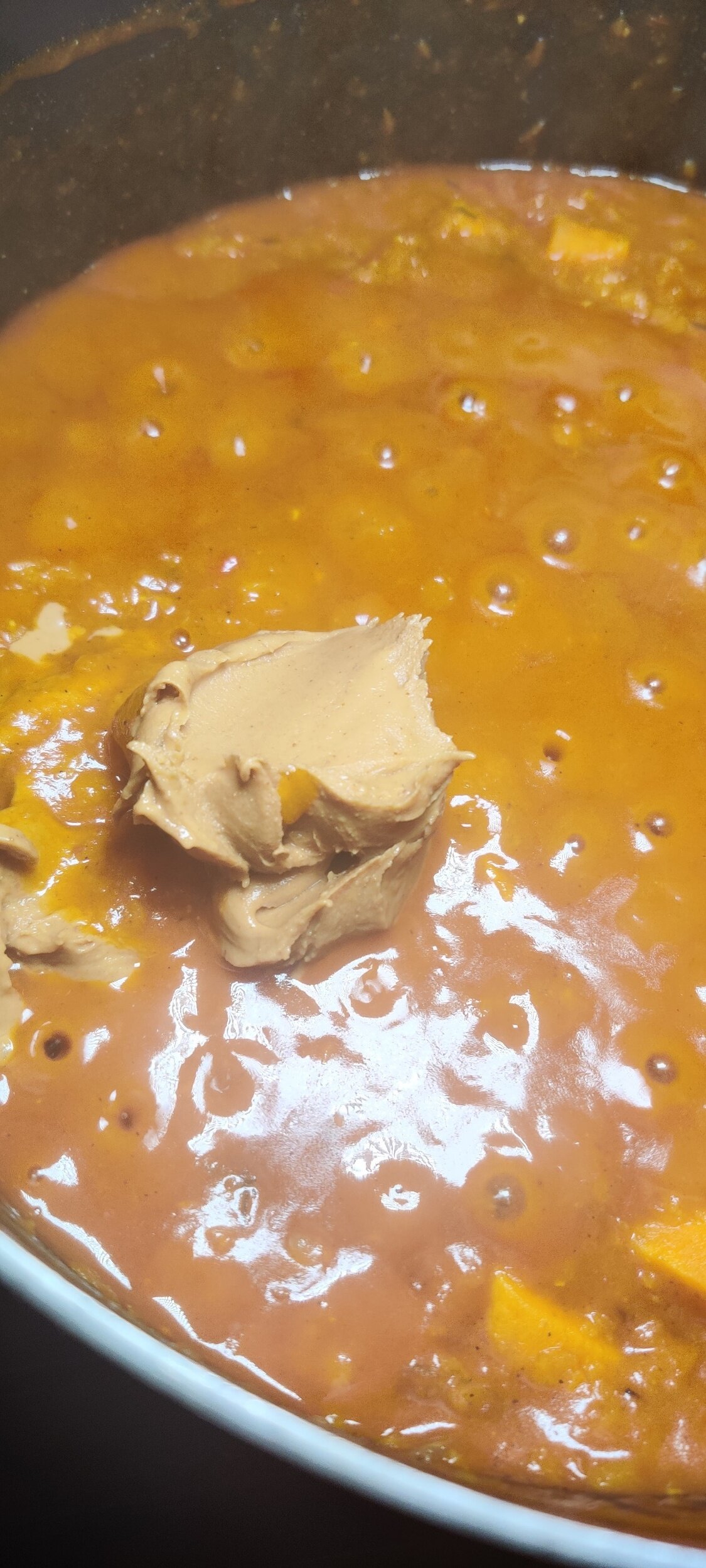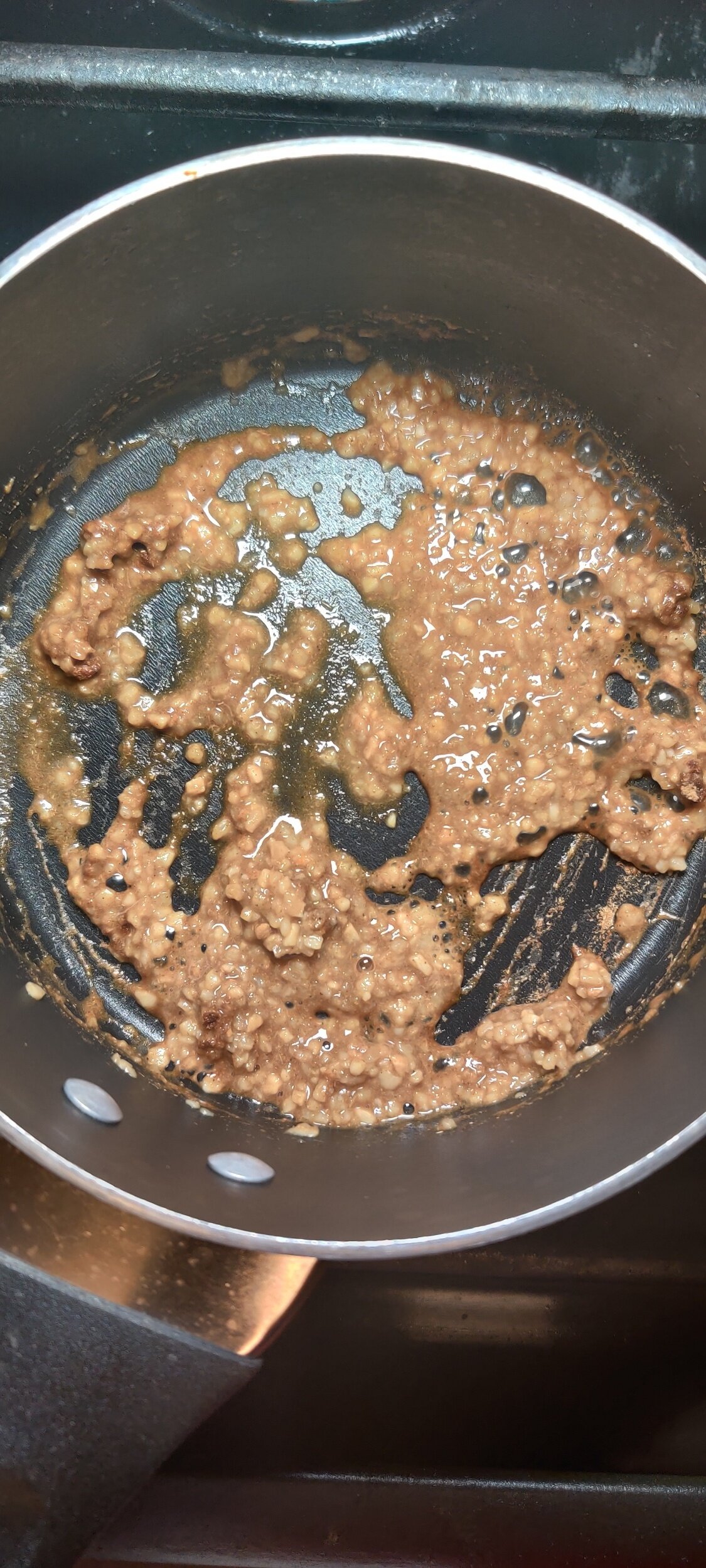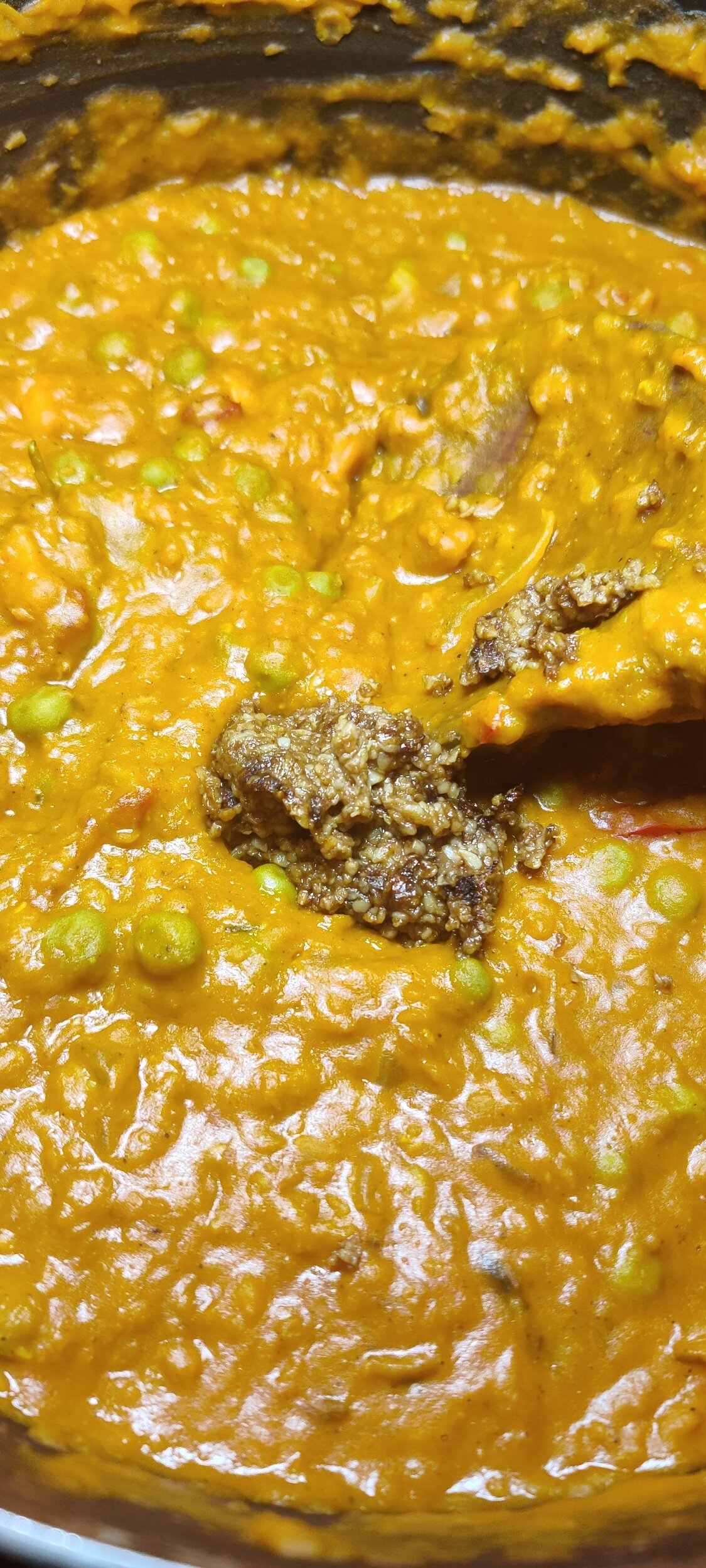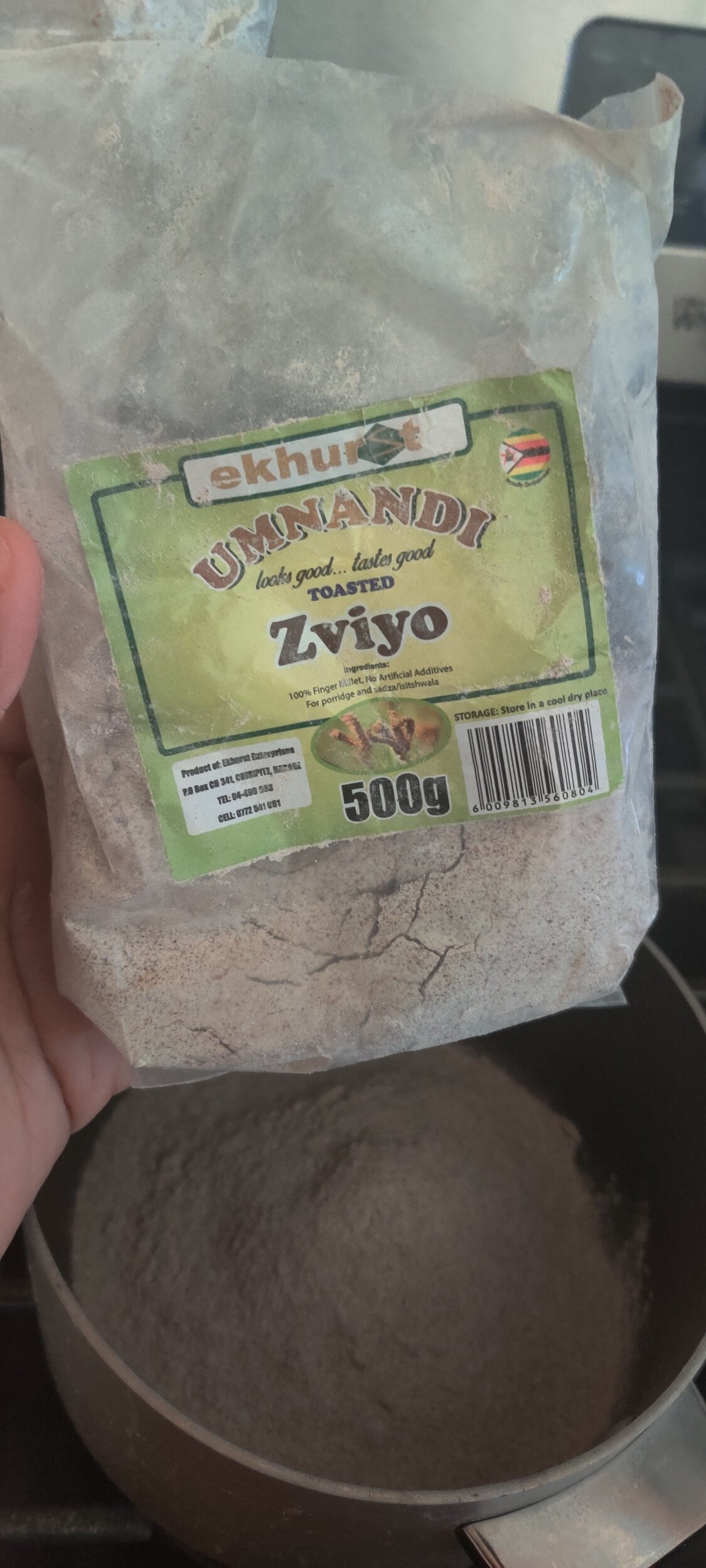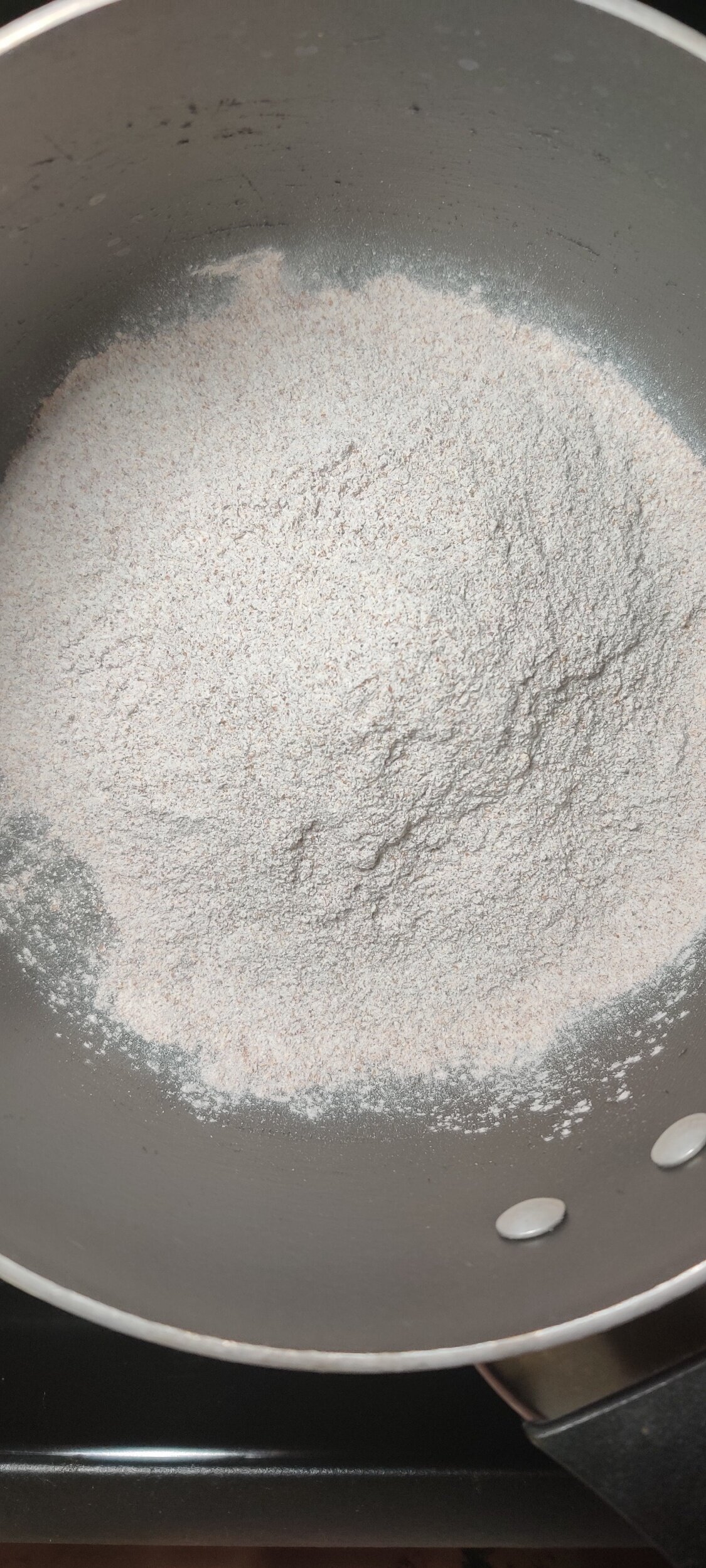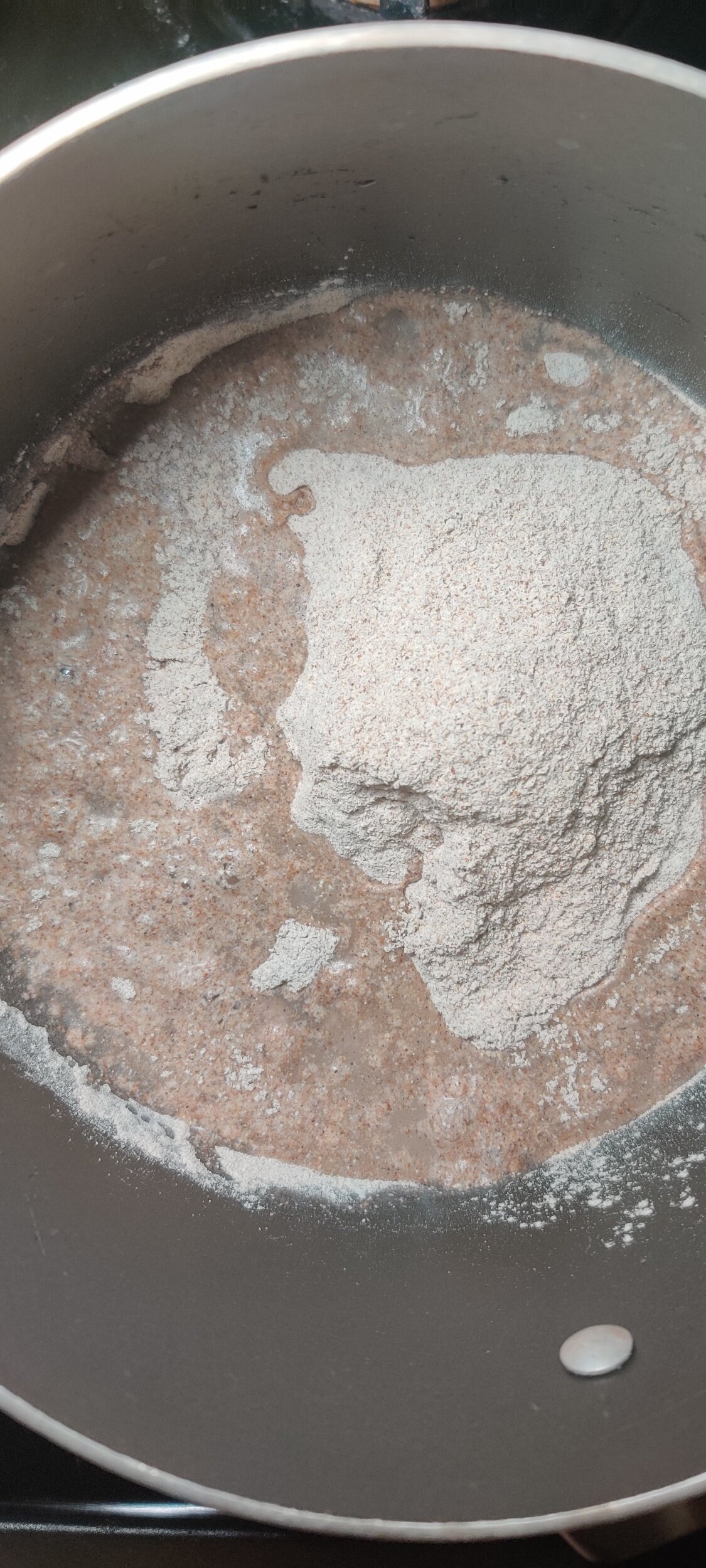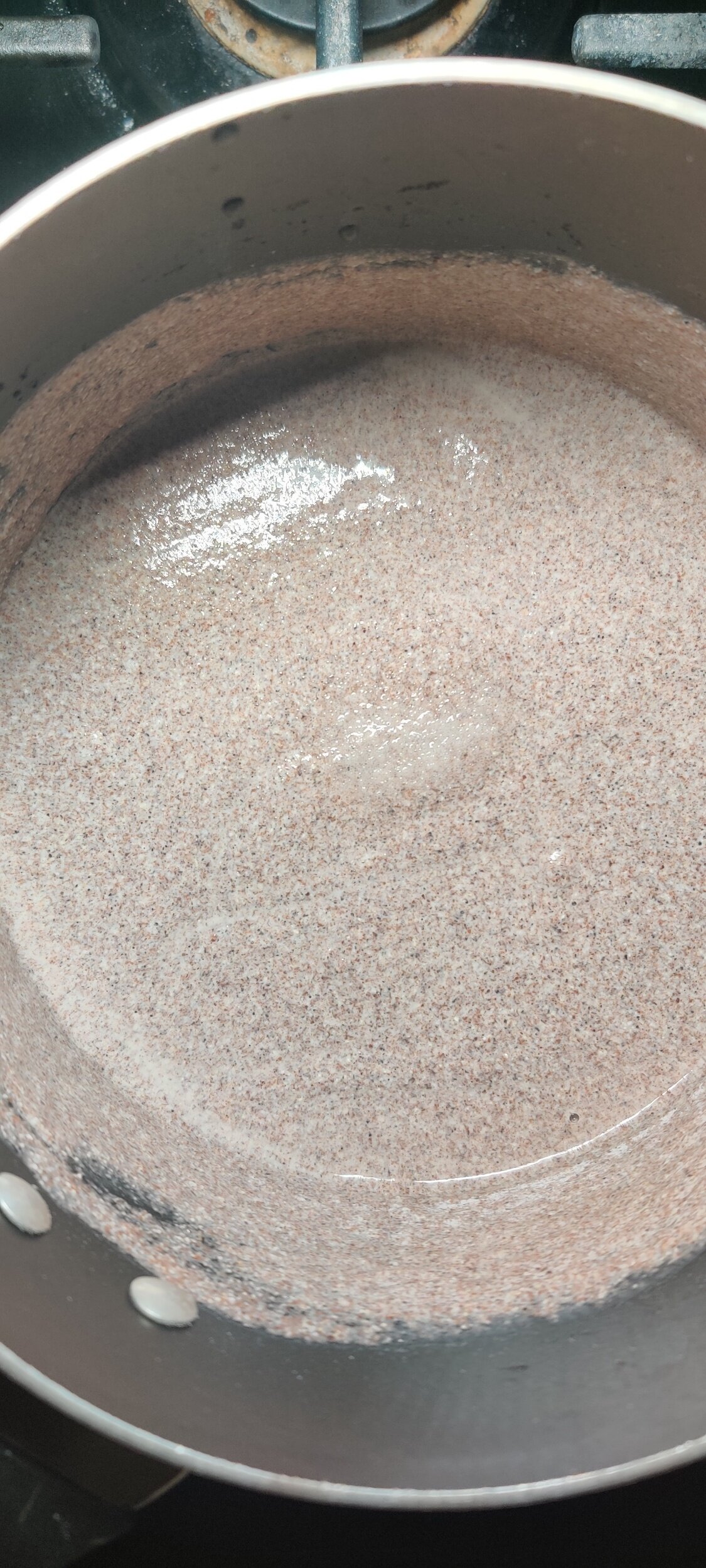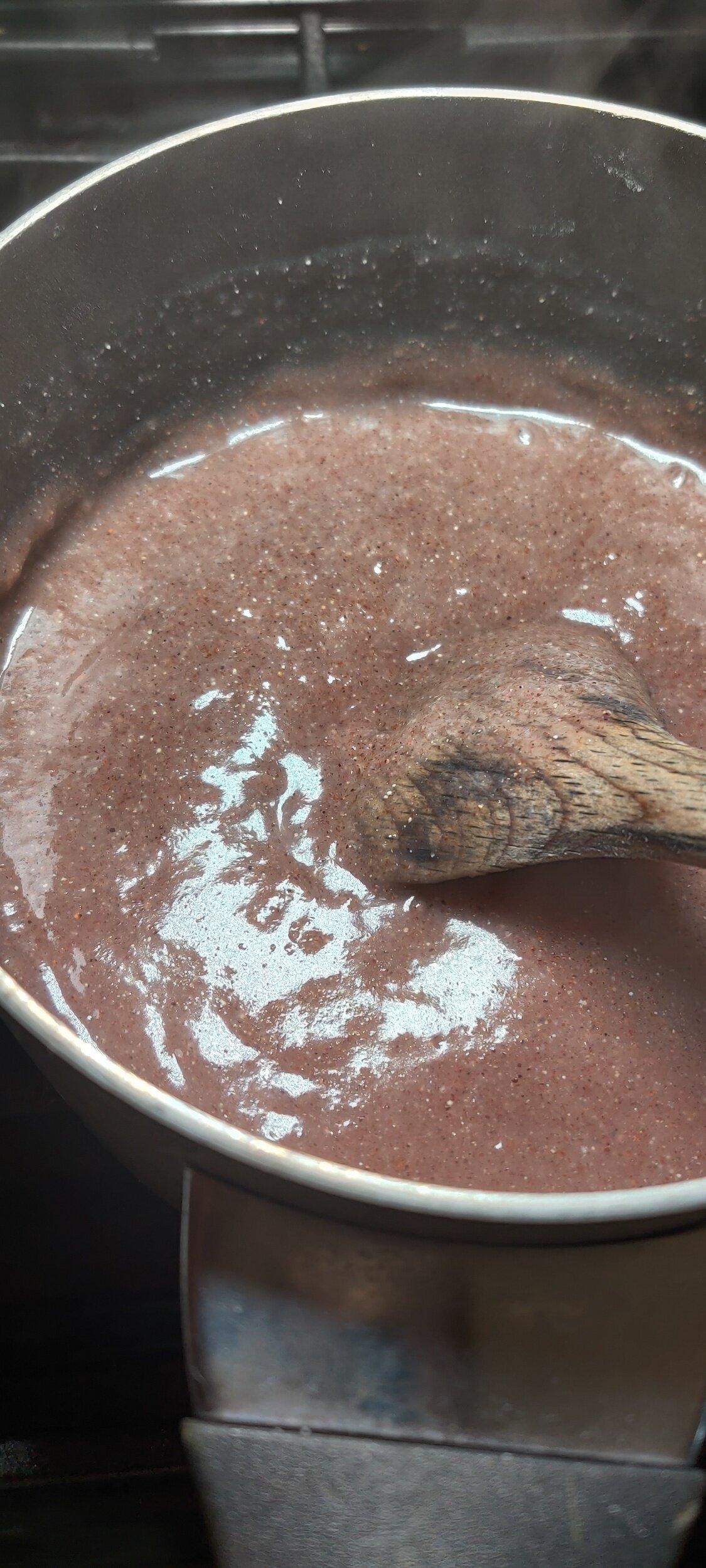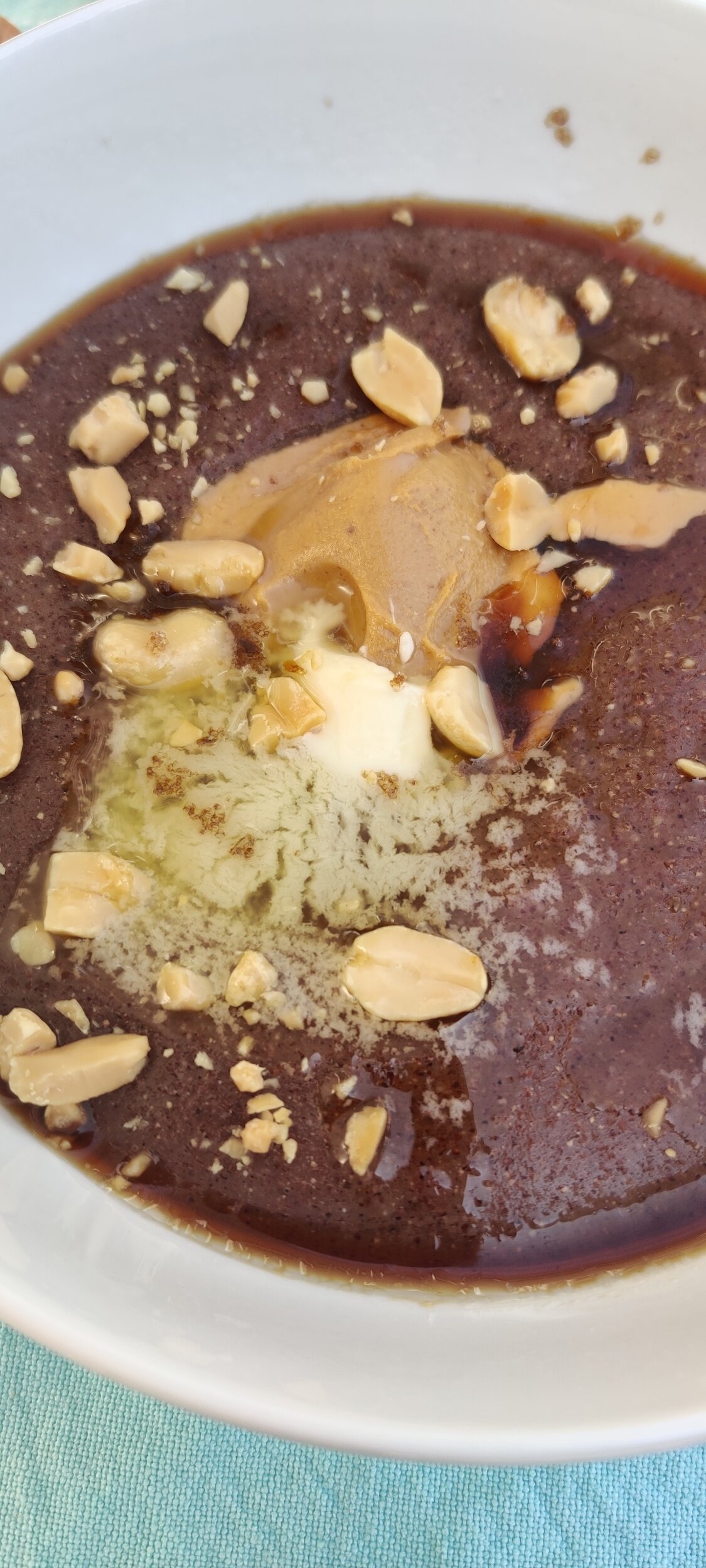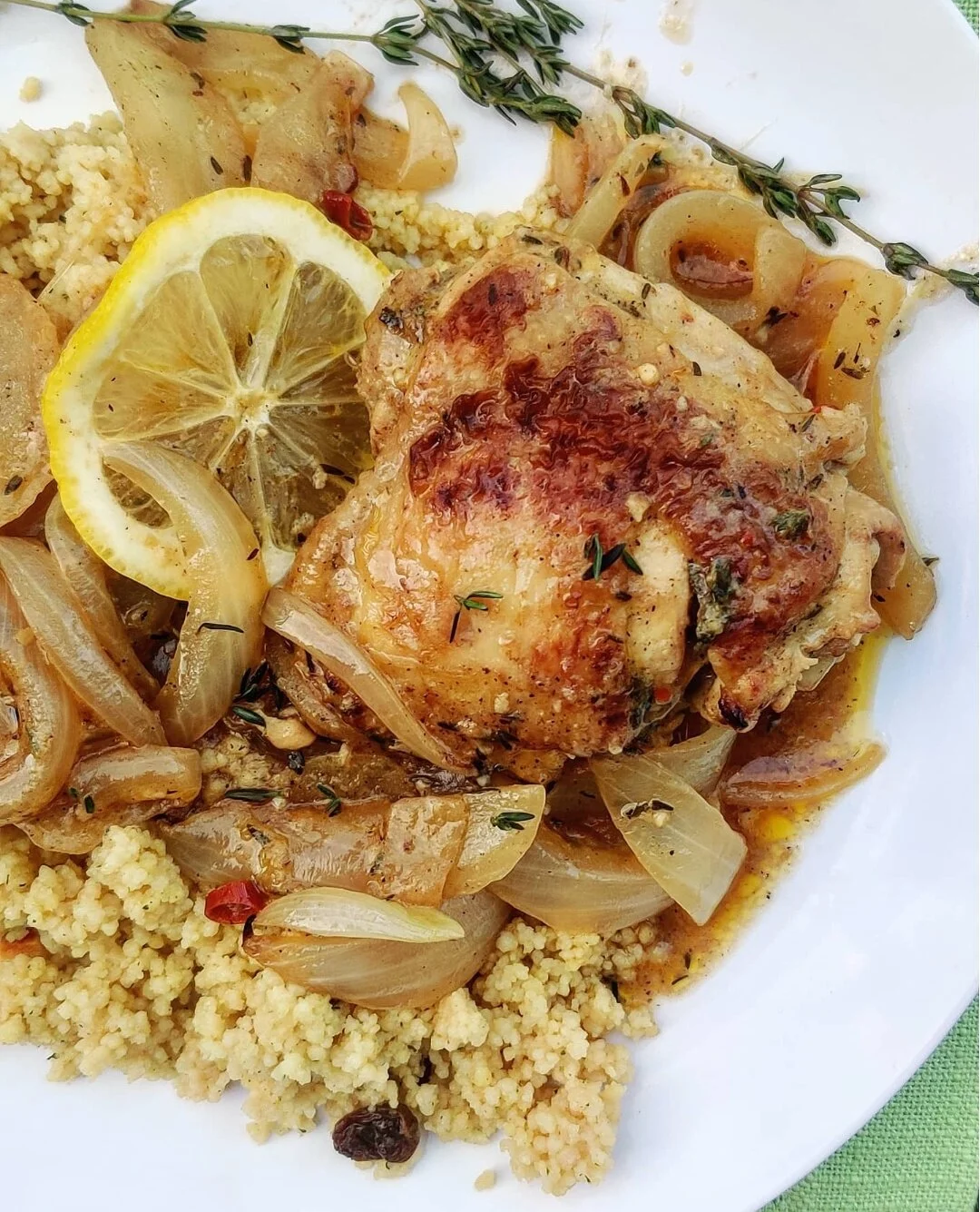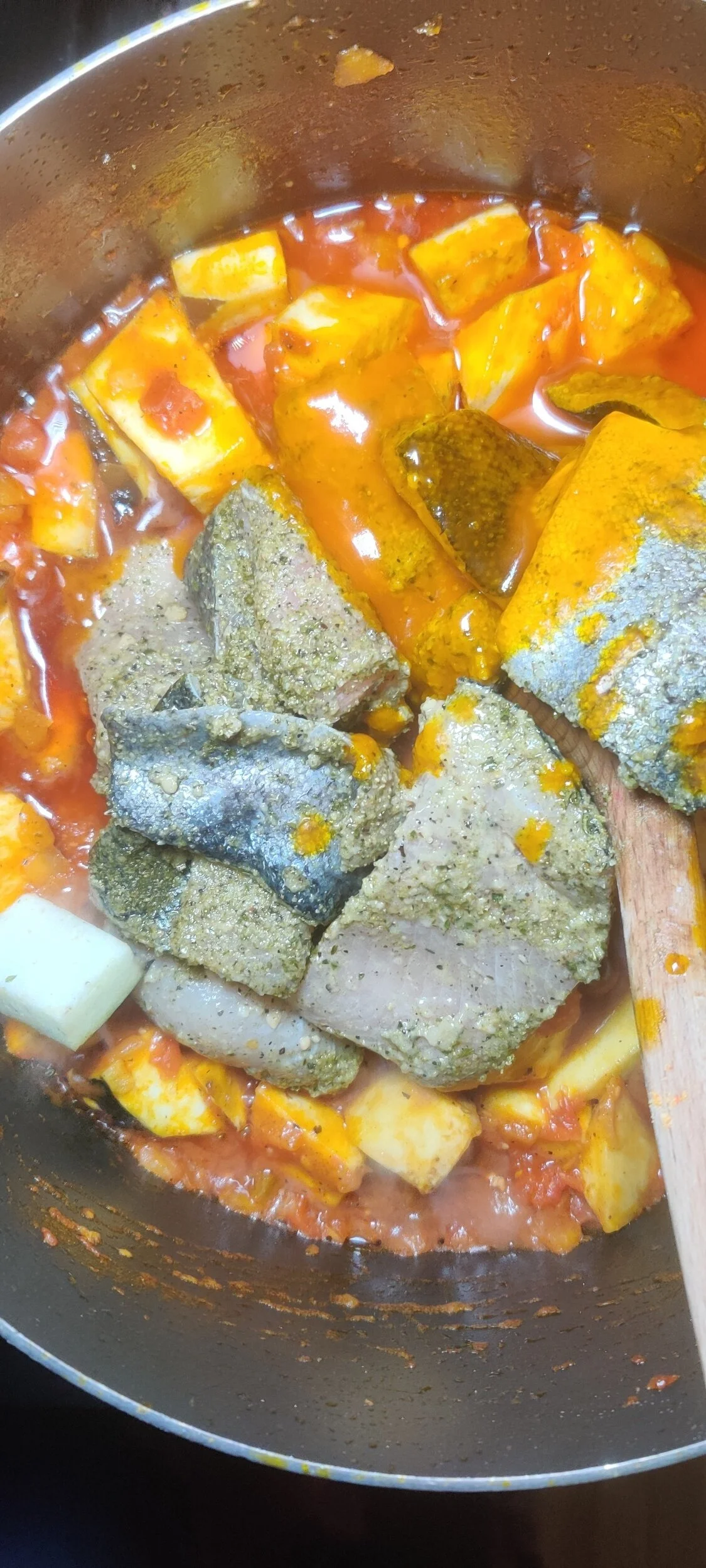Kale-Stuffed Shells in a Pumpkin Peanut Sauce
Stuffed pasta shells are an the easy recipe for a quick supper that is sure to please. You can probably make the shell-stuffing a family exercise as well! I reached back to a familiar ingredient trio I grew up on I like to bring to life in modern classics like this one. That is, peanut butter, pumpkin and kale! The recipe, of course, includes other ingredients including spinach, ricotta, parmesan, and pesto, which bring everything together nicely.
The beauty is you can adjust it to suit what you have available in your kitchen, what's in season, and your preferences.
The most important thing is to make sure both the filling AND the sauce the shells are nestled in are equally intense in flavour. Keep tasting as you go. It will make the finished product so much better.
Speaking of which, I had some left over jerk mushroom and lentil mixture I used to stuff some mini turnovers, about 1/4 cup. I add that to the peanut pumpkin sauce. If you want to add another dimension of flavor, you could start off with diced bacon when you sauté the onions, or, add some ground beef to the sauce to make a sort of Bolognese.
Ingredients
Sauce:
1/2 a box of jumbo shells
2/3 cups pumpkin puree
1/4 cup peanut butter
1 tablespoon palm oil
1 tablespoon olive oil
1 teaspoon salt
1/2 cup vegetable broth
2 tablespoons cooking wine
2 tablespoons Worchester sauce
1 tablespoon black pepper
1/2 yellow onion, chopped
1 tablespoon garlic
1 teaspoon fenugreek powder
1 teaspoon fresh sage, chopped
1 teaspoon coriander
1 teaspoon paprika
3 tablespoons pumpkin spice pepper sauce (I used Camella’s Kitchen’s)
1 teaspoon chili flakes
1/2 cup tomatoes, diced
1/4 cup tomato paste
Filling:
1 cup chopped kale and spinach
1 cup ricotta cheese
1 teaspoon olive oil
1/3 cup grated parmesan
2 tablespoons lemon juice
1 teaspoon salt
1 tablespoon black pepper
2 tablespoons pesto
Instructions
Cook the pasta as directed on the box until al dente, set aside. If you overcook they will break down so keep that mind.
Sauté the onion, spices, sage, and garlic in the olive and palm oil for about 3 minutes until fragrant on medium-low heat - don’t burn!
Add the tomato paste and diced tomatoes and cook for 2-3 minutes. Add the pumpkin puree, broth, cooking wine, and Worchester sauce. Stir until evenly mixed and thickened, then add the peanut butter, paprika and chili flakes. Simmer for about 5 minutes, set aside.
Fill your baking tray about halfway with the sauce, set aside.
In a small bowl, stir the parmesan, salt, olive oil, pepper, pesto, spinach and kale until evenly mixed.
Stuff the shells with about 1 heaped teaspoon, then carefully lay the shells on top of the pumpkin peanut sauce.. Bake in the oven at 350F for about 25 minutes.
Remove the baking dish to cool for about 5 minutes before serving.
Makai Paka Fish Pie
I’ve mentioned several times before that although I cut back on meat consumption with plans to be completely vegan, I still occasionally eat fish and seafood. What says fall better than a hot, flavourful stew pie? I grew up on both and wanted to share a delicious meal to celebrate them and keep you cozy.The recipe is a combination of two different dishes.
As the weather gets cooler many of us will be seeking out pie recipes. One of the most scrumptious in my humble opinion is fish or fisherman's pie. The flavours the white fish absorbs, muddled with vegetables and a white sauce, topped with creamy, baked mashed potatoes make for the ultimate, mouthwatering treat. Fish pie is similar to the well-known
shepherd's pie. Some classic renditions call for the addition of boiled eggs and shrimp. No need for pastry!
Why not spice things up to make your fish pie extra special?
For this, I turned to a Kenyan preparation of mealie Cobb, also known as makai paka, cooked in coconut milk and spices. Instead of whole mealies, of course, I used corn kernels. It's a popular dish in the South Asian community in Mombasa and across East Africa.
This makes for the kind of meal you'll be happy to serve your guests or present at the Family dinner table. I hope you enjoy it!
Ingredients
Fish stew:
1-2 pounds tilapia fillets (or any boneless white fish)
1/2 cup frozen corn kernels
2 tablespoons mustard
2 tablespoons lemon juice
2 tablespoons soy sauce
3 tablespoons olive oil
1/4 cup frozen peas
1/4 cup leeks, diced
1 can coconut milk
1 tablespoon tomato paste
1 tablespoon Madras curry powder
2 tablespoons black pepper
2 teaspoons salt
1 teaspoon turmeric
1 teaspoon coriander
1/4 cup parmesan cheese
1/3 cup scallions
2 tablespoons fish spice
1 tablespoon dill
1 tablespoon minced garlic
1/4 cup red onion, chopped
2 tablespoons butter
1 jalapeno, diced
1/3 cup crushed tomatoes
2 heaped tablespoons tomato paste
Mashed potatoes:
3 russet Potatoes
1/4 cup coconut cream
2 tablespoons butter
1/4 cup grated parmesan
Salt and pepper
Fresh coriander, scallions or chives to garnish
Instructions
Prepare the fish. In a shallow dish, season the fillets with 1 teaspoon salt, 1 tablespoon black pepper, 1 tablespoon olive oil, dill, lemon juice, soy, and 1 tablespoon fish spice. Set aside to marinate.
Prepare the mashed potatoes. Boil the potatoes in water until they are soft, about 20 minutes, fully submerged in a large pot. Using a potato masher, crush the potatoes with the butter, parmesan, and coconut cream until smooth. Season with salt and pepper and set aside.
In a large skillet or non-stick saucepan, sauté the jalapeno and green onions in the butter, garlic and olive oil for about 2 minutes, mix in the flour and cook for another minute. Add the red onion, leeks, and spices, cook for about 3 minutes, until fragrant.
Add the tomatoes and tomato paste, sauté for 2-3 minutes. Add the coconut milk, corn, mustard, and peas, reduce to simmer for about 5 minutes. Add the fish pieces, simmer for another 2-3 minutes before transferring to a sprayed baking dish.
Spoon the mashed potato on top and create a pattern with a fork if desired. Bake at 400F for 25-30 minutes. Rest for 5-10 minutes and serve hot with a side salad.
Black-Eyed Peas with Coconut and Tomato
I'm a huge fan of beans, and they are great if you are looking to cut down or eliminate your meat intake. They are filling, nutritious, and high in protein to name a few benefits.
Black-eyed peas - also known as cowpeas - are hearty and delicious. This bean is eaten extensively across West Africa where it's said to have originated and is an important staple in the Caribbean and the American South - where they are considered a lucky charm by some during New Years.
You can do a lot with black-eyed peas as they are quite versatile, check out my black-eyed pea and pinto bean meatloaf recipe for example.
I served this stew with finger millet in the form of sadza, a thick porridge native to Zimbabwe using an ancient grain much healthier than its white corn counterpart. You can find a recipe for it, here.
The spices muddled in the coconut milk and tomato makes for a rich stew that can be paired with a variety of vegetables or grilled meats or served as a main dish. You won't regret it!
Ingredients
3 cups dry black-eyed peas (soaked for 24 hours and drained)
1 tablespoon salt
2 tablespoons black pepper
1 tablespoon cumin
1 tablespoon coriander
1 tablespoon ginger
1 can coconut milk
3 beef bouillons
6 cups water
1 teaspoon fenugreek
1 teaspoon paprika
1 tablespoon garlic
1/2 yellow onion, chopped
1 small green pepper, finely chopped
1 cup tomatoes, diced
2 tablespoons tomato sauce/ketchup
2 tablespoons butter
2 tablespoons olive oil
2 tablespoons curry powder
Instructions
In a large pot, saute the onion and garlic in olive oil and butter for 3 minutes until the onion starts to soften.
Add the spices, bouillon cubes, salt and black pepper, cook for another 2 minutes.
Mix in the diced tomatoes and tomato sauce/ketchup, cook for about 5 minutes.
Stir in the green pepper and black-eyed peas, then pour in the water and coconut milk. Season to taste with additional salt and pepper if necessary.
Reduce the temperature and simmer for 35-40 minutes. Check the stew periodically and stir until the black-eyed peas soften and are cooked through. Add more water if needed.
While the beans are cooking, prepare your sadza or whatever starch you want to serve the stew with. All you'll need for that is water and corn/maize/millet meal.
Serve both hot, enough for 4-5.
Spicy Falafel with Cucumber Avocado Salad
Falafel is so satisfying to eat I don't know what it is. Well, maybe I do. Then again I'm biased because I absolutely love chickpeas and if you're reading this you probably are too!
The original recipe is said to have come out of Egypt. This was before it spread to the rest of North Africa and the Middle East where it is now a staple. I had my first encounter with falafel, folded into some pita bread with tomato, lettuce, cucumber, onion and sauce in New York City - I fell in love ever since!
Since they are on the dry side, it's a must that a sauce accompanies the falafel. I used tzatziki to compliment the refreshing cucumber and avocado salad, but tahini salad is another popular condiment you can use too.
The most important thing to know about this recipe is the use of dried beans.
Even though you soak them and they need to be drained beforehand, this helps with the integrity of the falafel balls versus using canned chickpeas. The same goes for hummus. I've read anecdotes of people drying canned peas in the oven if that is all they have, so it is not impossible.
Ingredients
2 cups dried chickpeas (soaked overnight then drained)
1/2 medium onion, finely minced
1 tablespoon roasted sriracha sesame seeds
2 tablespoons garlic, minced
1/2 cup parsley, finely chopped
1 tablespoon lemon juice
1 teaspoon coriander
1 small habanero, finely minced
1 tablespoon cumin
1/4 teaspoon salt
1 teaspoon black pepper
1 teaspoon chili powder
1 tablespoon paprika
1/2 teaspoon baking soda
1 egg (optional)
Salad:
1 large cucumber, thinly sliced and quartered
1 large avocado, sliced
3 teaspoons olive oil
1 teaspoon lemon juice
1/2 teaspoon salt
1 teaspoon black pepper
Tzatziki sauce
1 1/2 cups sprouts
Instructions
In a food processor, pulse the chickpeas, cumin, coriander, lemon juice, salt, pepper, chilli powder, paprika, parsley, onion, and garlic. A thick paste you can mold should form. If it seems too crumbly, add the egg to help bind everything together.
You can bake or fry falafel depending on your preference. If you like a crunchy exterior, frying will make that happen! I used an air fryer and cooked the falafel balls at 400F for 15 minutes, flipping them halfway after spraying with olive oil. You can also bake them for 30 minutes, turning them over after 15 minutes. Roll your falafel into smoothened balls - about two scoops with a cookie scoop and your hands.
Prepare your salad. In a bowl, toss the cucumber, avocado and sprouts in the olive oil and lemon, season with salt and pepper. Layout the salad on each plate, and add 1-2 teaspoons of tzatziki on top. Set your cooked falafel on top of the tzatziki and eat immediately or warmed.
Serves 2-3 people!
Tip: if your falafel base seems a bit wet and you struggle to form balls, bake in a 350F oven for about 5-7 minutes to dry it out a bit, but don't overcook.
Jollof Rice-Stuffed Tomatoes and Mushrooms
If you haven't had jollof rice yet, you're missing out. It's a cornerstone of West African food. Each country that does make it a central aspect of their cuisine have particular methods of preparing the rice. I’m not going to get into the nuances because I’m from Southern Africa and not really in a position to get into the specifics and get it exactly right! I will say though, that some people might say it my rendition is closer to the 'Ghanaian way', due to the spiciness and lack of bay leaf (common in some Nigerian recipes I've seen). I seasoned the tomato stew the rice cooks in to my liking, and the result is pretty delicious.
You can eat the jollop rice as it is, with beans, fish, plantains, or do what I did and stuff some juicy vegetables! Stuffing veggies with rice (and sometimes a protein) is nothing new. It’s usually an easy and delicious meal, and quick if you have precooked your rice.
This method is something fun to do year-round with whatever is in season.
I was going to get brave and try and stuff some grapes leaves and cabbage, but this kept it simple since tomatoes and mushrooms lend themselves well to stuffing/topping, are easy to find and relatively affordable.
Hope you find this as tasty as I did!
Ingredients
1 large yellow onion, chopped
2 tablespoons olive oil
1 tablespoon garlic, minced
1/4 cup vegetable oil
1 tablespoon butter
1 (14-ounce) can diced tomatoes
1 small habanero pepper, chopped
1 (6-ounce) can tomato paste
2 beef bouillon cubes
1/2 cup frozen peas
1/2 teaspoon cumin
1 tablespoon curry
1 tablespoon paprika
1 teaspoon salt
1 tablespoon black pepper
1 teaspoon garlic and herb blend
1 teaspoon ginger
1/2 teaspoon coriander
3-4 large tomatoes
Fresh thyme
Garlic powder
Olive oil
3-4 portobello mushrooms
Instructions
Blend the onion and olive oil into a paste and set aside.
Clean out the blender and repeat this step with the pepper, tomatoes, and tomato paste.
In a large pot, melt the butter with the vegetable oil. Add the onion paste and garlic and cook on medium-low heat, stirring frequently for 5 minutes. Add the spices, salt, pepper, and bouillon cubes. Simmer for an additional 5 minutes or until the onion paste looks drier and the water content is reduced.
Add the tomato sauce and continue to simmer for about 15-20 minutes, stirring frequently.
Finally, add the rice and frozen peas. Top with water, cover with foil and a lid, and steam cook for 30 minutes until the rice is done. You can check from time to time to make sure the bottom isn’t burning. Note - the foil will help to keep all the flavours in!
Prepare your vegetables for stuffing. Hollow out the insides carefully with a knife, and drizzle with olive oil. Dust with garlic powder, salt, pepper, then top with fresh thyme.
In a 400F oven, bake your vegetables for about 25 minutes, until they have softened (but don’t overcook).
Remove your vegetables and let them cool for about 5 minutes, then using a teaspoon scoop the rice into the tomatoes and mushrooms. Serve hot!
East African Mashed Kale Stew (Sukuma Wiki) with Chapati
This dish is inspired by one of East Africa’s most beloved comfort foods: Sukuma Wiki, a flavorful sautéed kale or collard green dish often served with chapati or ugali. Common across countries like Kenya, Uganda, and Tanzania, Sukuma Wiki is a simple, affordable way to stretch meals, the name literally means “stretch the week” in Swahili.
I’ve taken that foundation and turned it into a heartier, stew-like version by adding peanut butter, yam, mushrooms, and eggplant for extra richness. This version leans into bold spices and a creamy texture, making it filling enough to enjoy as a main dish.
While this stew draws heavily from Sukuma Wiki, I was also inspired by other traditions across the continent. In Zimbabwe, pumpkin leaves (muboora) are cooked with peanut butter to create a deeply savory side or main. They’re often overlooked, but when cooked right, they're just as good as kale or collard greens. Since I’m currently in the United States, I’ve used kale (muriwo) as a substitute, it’s readily available and holds up beautifully in stews.
In Rwanda, a dish called isombe uses ground cassava leaves stewed in a similar way, often served with plantains and, of course, chapati, my favorite flatbread of all time.
I’ve paired this stew with East African chapati, which is soft, flaky, and layered. It’s made differently from Indian chapati, using a coiled rolling technique that creates those signature flaky layers. You can find my chapati recipe [here] if you’d like to make it from scratch.
This dish is warm, deeply nourishing, and full of flavor. It’s a beautiful mix of traditions and ingredients that come together to celebrate African cooking in a way that’s comforting and easy to recreate at home.
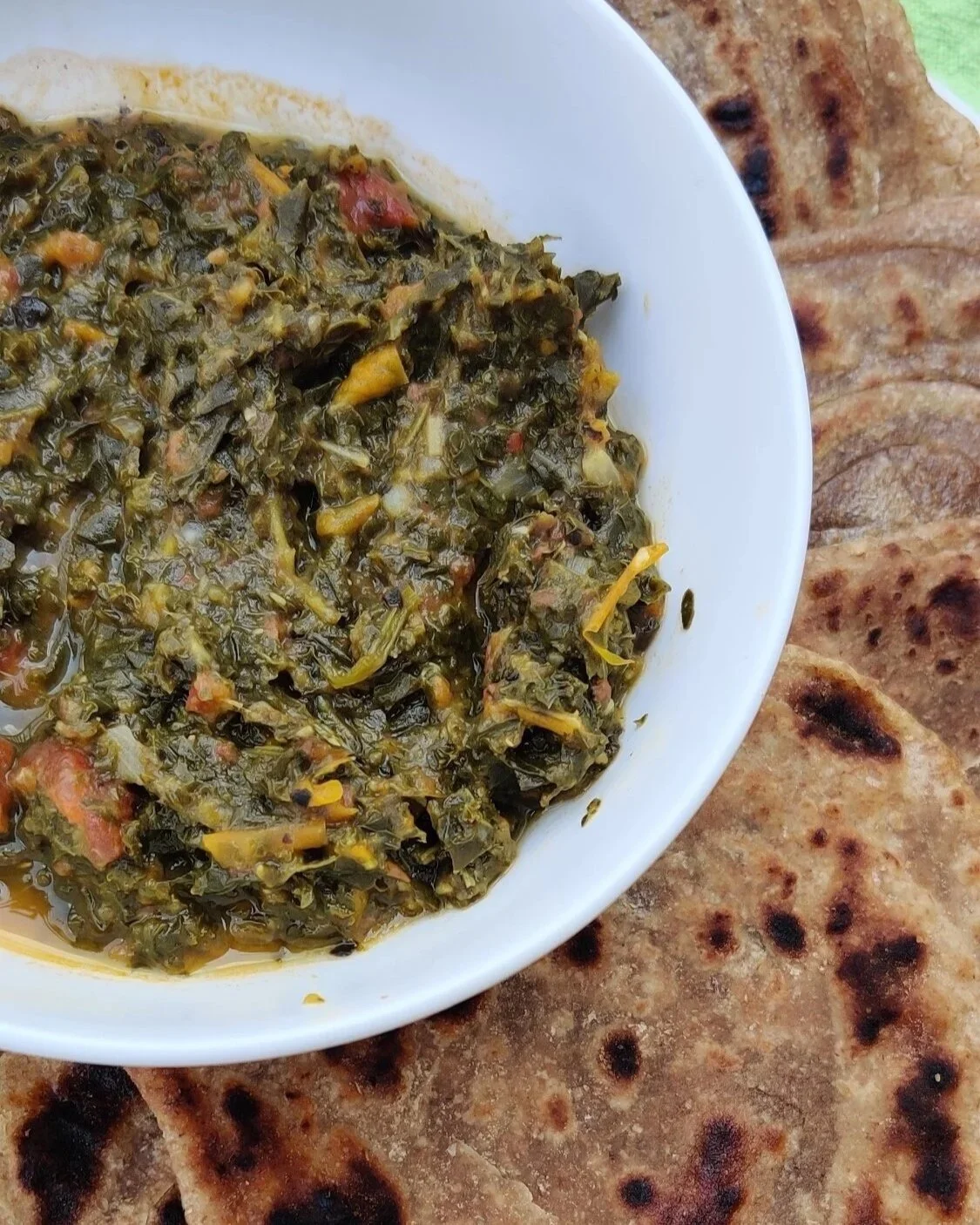
East African Mashed Kale Stew (Sukuma Wiki) with Chapati
A hearty, comforting East African-inspired kale stew packed with vegetables, spices, and richness from peanut butter. Serve with chapati for a complete meal.
Ingredients
- 1 pound kale, chopped
- 2 tablespoons garlic, minced
- ¼ cup fresh parsley, chopped
- ½ large eggplant, chopped
- ½ cup mushrooms, chopped
- 1 large tomato or 1 (14-ounce) can diced tomatoes
- ½ white-fleshed yam or sweet potato, chopped
- ½ large onion, chopped
- ½ large bell pepper, chopped
- ½ jalapeño, chopped
- 6 cups beef broth
- 2 vegetable bouillon cubes
- 1 tablespoon salt
- 2 tablespoons black pepper
- 1 tablespoon chili flakes
- ½ cup peanut butter
- 2 cups water
- 2 tablespoons vegetable oil
- 1 teaspoon fenugreek
- 1 teaspoon cumin
- 1 teaspoon coriander
- 1 teaspoon paprika
- 1 teaspoon sugar
- 1 teaspoon fennel
- ¼ cup chopped parsley (for garnish or added at the end)
Instructions
- Heat the vegetable oil in a large pot over medium heat. Add the chopped kale and cook until wilted and the edges begin to crisp slightly.
- Stir in the garlic and parsley. Cook for 2 minutes, until fragrant.
- Add the onion, eggplant, mushrooms, and all the spices (fenugreek, cumin, coriander, paprika, sugar, fennel, salt, pepper, and chili flakes). Sauté for another 2 minutes.
- Add the bell pepper and jalapeño, and cook for 1 more minute.
- Stir in the tomato, yam (or sweet potato), bouillon cubes, water, and beef broth.
- Reduce the heat to low, cover, and let the stew simmer for about 35 minutes. Stir occasionally and add more water if the stew becomes too thick.
- Once the vegetables are soft and the flavors are well developed, stir in the peanut butter and simmer for 5 more minutes. Taste and adjust seasoning as needed.
- Serve hot, ideally with freshly made chapati or another flatbread.
Notes
Tips:
- The richer your broth, the more flavorful the stew will be. Homemade stock or beef bone broth adds incredible depth.
- While traditionally made with beef broth, this stew can easily be made vegetarian or vegan by using a well-seasoned vegetable broth.
- You can also blend part of the stew for a smoother texture or leave it chunky, depending on your preference.
I am not a certified nutritionist and any nutritional information on dontmissmyplate.com should only be used as a general guideline.
How to Make East African Chapati – Step-by-Step Recipe
Chapati is one of the most beloved and widely eaten flatbreads in East Africa. Popular in countries like Kenya, Uganda, and Tanzania, it’s a staple at family dinners, street food stalls, and festive gatherings. While chapati originated from the Indian subcontinent and was introduced to Africa through trade and migration, it has evolved into a distinct East African version that is softer, flakier, and richer than its Indian counterpart.
What sets East African chapati apart is the generous use of oil or ghee in both the dough and the cooking process. This gives the bread its signature soft texture and golden, flaky layers. When made well, chapati is slightly crisp on the outside, soft and chewy on the inside, and perfectly seasoned with just the right amount of salt and fat.
In many African homes, bread is more than just food. It plays an important cultural role at the table and is often shared during meals as a symbol of hospitality. Chapati in particular is used to scoop up stews, beans, or vegetables, making it an essential part of everyday meals and celebrations. For many, learning to make chapati from scratch is a family tradition passed down through generations.
I originally created this recipe to pair with a mashed kale stew, but it's incredibly versatile. Chapati is also perfect with curries, lentils, grilled meats, or simply served as a side with a variety of other dishes.
If you’ve ever ended up with dry or tough chapatis, this recipe offers a few simple but essential tips. Be generous with the oil or ghee, knead the dough thoroughly to build elasticity, and give it time to rest before rolling. For extra flaky layers, try the folding and coiling method described in the recipe. These steps make a big difference in achieving that classic East African chapati texture.
Whether served with sukuma wiki, lentils, or a cup of tea, this chapati brings the flavor and comfort of East African home cooking to your kitchen.
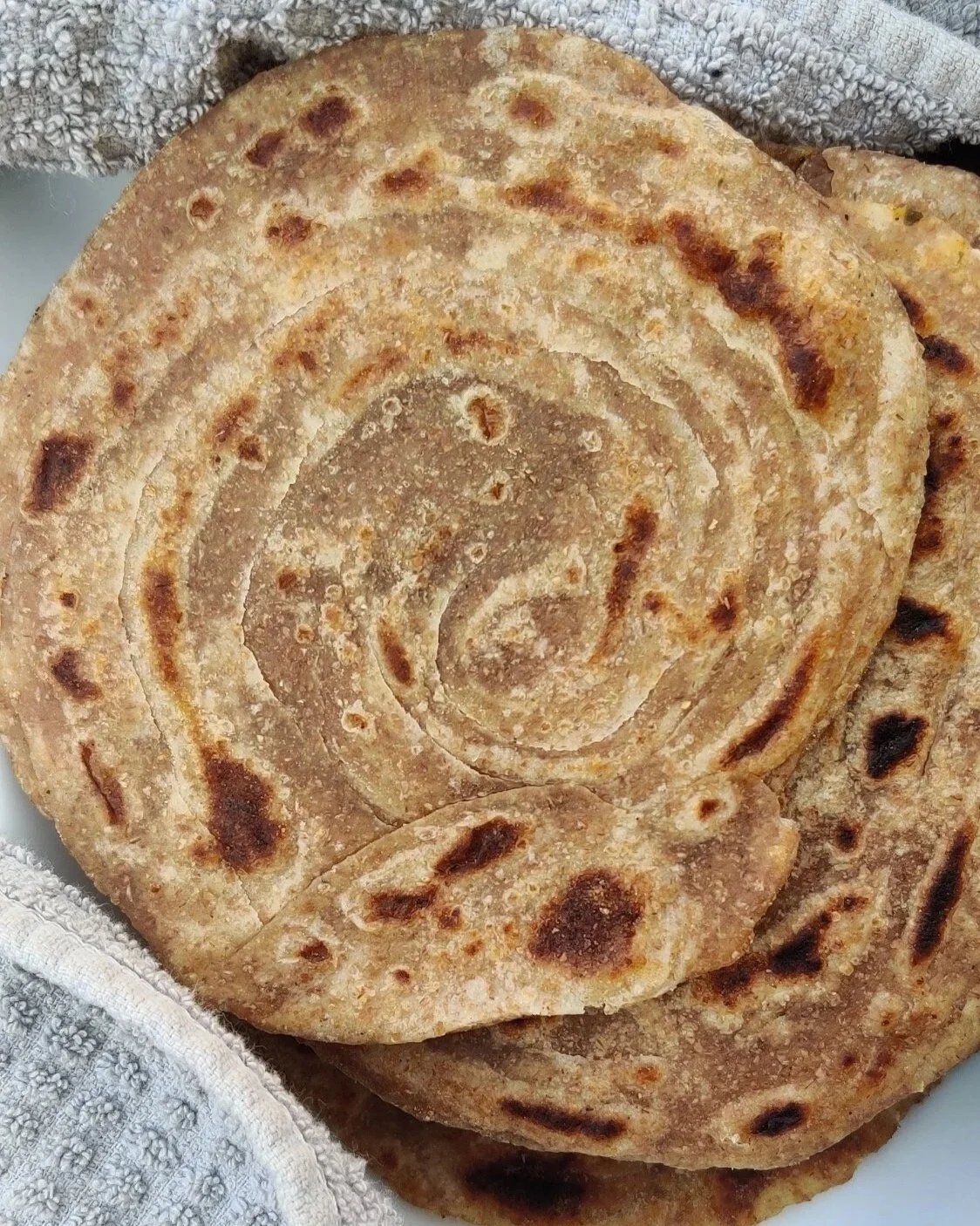
How to Make East African Chapati – Step-by-Step Recipe
A soft, flaky flatbread that's a staple across East Africa. This chapati is easy to make, incredibly versatile, and perfect with stews, curries, or on its own.
Ingredients
- 1 cup whole-wheat flour (you can substitute all-purpose flour if desired)
- 1 cup all-purpose flour, plus extra for dusting
- 1 teaspoon salt
- 2 tablespoons olive oil or ghee, plus extra for brushing
- ¾ cup hot water
Instructions
- In a large bowl, combine the whole-wheat flour, all-purpose flour, and salt.
- Using a wooden spoon or spatula, mix in the oil or ghee. Gradually add the hot water in two parts, mixing until a soft, elastic dough forms. Don’t skimp on the oil or ghee, this helps prevent dry chapatis.
- Turn the dough out onto a lightly floured surface. Knead for about 10 minutes until smooth and pliable.
- Divide the dough into 8 to 10 equal portions, depending on your preferred chapati size.
- Cover and let rest for 10 minutes.
- On a floured surface, roll out each dough ball into a round shape, similar to a tortilla but slightly thicker.
- Lightly brush each side with oil or ghee, then dip both sides in flour, shaking off any excess.
- Heat a dry, non-stick pan over medium-high heat.
- Place one chapati in the pan and cook for about 30 seconds, or until brown spots begin to form. Flip and cook the other side. Repeat with the remaining dough.
- If you'd like to create distinct layers inside your chapati, follow these extra steps after dividing the dough:
- Take each dough ball and fold it back and forth like a fan or piece of paper.
- Alternatively, roll it up tightly like a carpet.
- Coil the folded dough into a spiral shape (like a cinnamon roll), then cover and let rest under a damp towel for 30 minutes.
- After resting, gently press each dough coil flat and roll it out again into a round shape.
- Lightly brush both sides with oil/ghee, press into flour, and shake off the excess.
- Cook as described above.
Notes
Serving and Storage Tips
- Serve chapatis warm, ideally right off the pan.
- To store, wrap them tightly in foil or a clean cloth to keep them soft and prevent drying out.
I am not a certified nutritionist and any nutritional information on dontmissmyplate.com should only be used as a general guideline.
Ras El Hanout- Spiced Eggplant Crust Mini Pizzas
If you have some leftover eggplant and don't know what to do with it, make some mini Margherita pizzas! These crustless babies are keto, low-carb, and vegetarian, with umami taste similar to mushrooms. They absorb flavour like a sponge!
Speaking of flavour, instead of a regular, tomato sauce, I wanted a flavour that would pack a punch and not rely on the cheese. I seasoned the pizza base with homemade ras el hanout, a spice blend prevalent in North Africa, particularly in Algeria, Morocco and Tunisia. It’s a mix of intense, complex flavours (better if you can grind it up to from whole spices)! The ras el hanout enhances the sauce and goes well with the eggplant, and is often used to season meat, fish, couscous and other vegetables.
I love the spice mix because there are no hard rules in terms of ratios, but generally cumin, cardamom, cinnamon, coriander, turmeric, ginger, paprika, black pepper, and cayenne pepper make a feature.
The name ras el hanout translates to ‘head of the shop’, alluding to a blend of the best spices in store!
Also, if you can get your hands on fresh herbs, use them! This will give your pizzas a fresh bite.
Ingredients
1/2 large eggplant
Olive oil
1 tablespoon dried thyme
1 tablespoon fresh thyme
1 tablespoon fresh basil, chopped
5 basil leaves
Dried parsley
1 heaped teaspoon garlic
1 teaspoon Worchester sauce
1/4 cup tomato salsa
1/2 cup tomato ragu
Salt and black pepper
Mozzarella or sharp cheddar, cut into small squares
Chili flakes
Ras el hanout:
1 teaspoon salt
1 teaspoon black pepper
1/2 teaspoon cumin
1 teaspoon cinnamon
1 teaspoon coriander
1/4 teaspoon cardamom
1/2 teaspoon cloves
1/2 teaspoon turmeric
1/2 teaspoon cayenne pepper
1/2 teaspoon ginger
1 teaspoon smoked paprika
1/2 teaspoon nutmeg
(Makes about 1/4 cup)
Instructions
Cut your eggplant into thick slices (not too thin, they will shrink a bit in while baking). Brush them generously with olive oil and sprinkle with dried thyme, salt, and pepper on both sides. Bake at 400F for 15 minutes.
While the eggplant is in the oven, prepare your spiced tomato sauce in a small bowl. Mix the ragu, salsa, Worchester sauce, garlic, and basil. Blend the spices in a small container where you can store what remains. Add one teaspoon to the tomato sauce and mix well.
Remove the eggplant from the oven and top with the tomato sauce, cheese squares, fresh thyme, and basil leaves.
Bake for another 10 minutes and until the cheese starts to melt.
Serve hot and garnish with chilli flakes, parsley, and ground pepper.
Chermoula Red Snapper with Peanut Butter Rice
This dish is a combination of a lot of different influences. Meals like this that make me appreciate the exposure I've had to food from my background, visiting restaurants, reading, and exploring in the kitchen.
Let’s start with the peanut butter rice!
This is a favoured way of preparing rice in Zimbabwe. It’s an easy, affordable way to add protein to the rice when there is no meat, but even when there is adds an interesting dimension to rice. If you haven’t tried peanut butter rice, I encourage it of course!
The second most important thing, the fish and the marinade!
Chermoula is a herb marinade used to season fish and vegetables in Morocco, Tunisia, Libya, and other parts of North Africa. It adds a rich taste to even the mildest fish. Once you make it you will be using it forever.
As for the red snapper, once clean, stuff it with simple herbs and add some lemon slices for favour on the inside. You can also get it from the butcher prepared for you, but that doesn’t mean you can’t add seasoning!
Ingredients
Chermoula and fish:
1 red snapper, cleaned
1/2 cup parsley, chopped
1/4 cup cilantro, chopped
1 teaspoon cumin
1/2 teaspoon black pepper
Pinch of salt
1 teaspoon paprika
1/2 cup olive oil
1 tablespoon lemon zest
4 teaspoons garlic, minced
1 teaspoon chili powder
4 lemon slices
1 thyme sprig
1 parsley spring
Peanut butter rice:
1 cup white rice
1/3 cup peanut butter
1/2 teaspoon black pepper
1/4 teaspoon salt
1/4 hot cup water
1 3/4 cups water
1 vegetable sachet or bouillon
1 tablespoon olive oil
1 teaspoon garlic, minced
Beans:
1 teaspoon paprika
1 teaspoon chili powder
1 can pinto beans (sugar beans if you can get them, that was my first choice!)
1 teaspoon black pepper
1/2 teaspoon salt
1/2 cup water
1/2 vegetable bouillon, crushed
1 tablespoon Scotch bonnet pepper sauce
Instructions
Prepare the chermoula. In a blender or food processor, add the parsley, cilantro, lemon zest, paprika, cumin, and chilli powder. Mix on low while adding the olive oil to create a paste, so don’t blend until it turns into a liquid! If you accidentally do, add some more parsley to thicken.
For the red snapper, if it isn’t already, stuff the fish with the herb sprigs and lemon slices. Baste the fish on both sides with the chermoula and chill what remains for later. Bake the fish at 450F on each side for 10-15 minutes. When done, the fish should flake easily using a fork. You can also check the internal temperature and go by what’s recommended. Set aside to rest.
While the fish bakes, prepare your rice. Cook the rice with garlic and olive oil before adding the broth sachet. Follow up with 1 3/4 cups water (or whatever rice quantity you want according to the package) and simmer with a lid until the water has evaporated - you want your rice on the drier side because the peanut butter will be added.
Mix the hot water with the peanut butter to make a smooth paste and mix it into the rice. Steam with the lid on for 5 minutes, then remove from heat.
For the beans, sauté them in the oil, bouillon, and spices for about 3 minutes, then simmer in water for about 5-7 minutes. Since canned beans are cooked this should not take long otherwise the beans will break down into mush.
Use the chermoula to baste the cooked snapper and serve with the hot beans and peanut butter rice, feeds 2!
Plantain Stew with Black Beans
If you're looking for a rich, plant-based meal, this is it. I was inspired to cook these plantains and make them the star of the dish like matoke, Uganda’s national dish that uses East African Highlands bananas. They are starchy bananas made into a stew and sometimes mashed, often mixed or served alongside stewed beef. I substitute the beef with mushrooms and still got a great flavour with simple spices and broth. This melody makes for a comforting dish that is mostly guilt-free!
Ugandan cuisine does have some elements also found in Zimbabwe such as ugali (thick corn porridge), but cooked bananas play an unparalleled role in the region as a whole which I don't see in Southern Africa.
Many people are familiar with fried plantains, but they are just as delicious stewed!
Since you already have starch in this dish, I would suggest pairing the plantains with some high protein beans! I seasoned my black beans with a pepper sauce, and it all came together perfectly.
Ingredients
2-3 plantains, chopped
1/2 white onion, finely chopped
1 tablespoon garlic, minced
1 tablespoon black pepper
1 teaspoon salt
1/2 bell pepper, chopped
2 dried peppers, finely chopped
8 ounces mushrooms (1/2 pound, cubed)
1/2 cup tomatoes, chopped
2 cups vegetable or beef broth
2 cups water
2 vegetable or beef bouillons
1/2 teaspoon Usavi mix
1/2 teaspoon coriander
Lemon juice
2 dried chili peppers, finely minced (keep the seeds for more heat)
1/3 cup tomato ragu sauce
Black beans:
1 tablespoon pepper sauce (I used Camella's kitchen)
1/4 cup onion, finely chopped
1/2 teaspoon salt
1 can black beans
1 teaspoon black pepper
1/4 cup tomato ragu sauce
1/4 cup water
Instructions
Cut your plantains or green bananas into small pieces lengthwise, toss in lemon juice and set aside.
Saute the onion and pepper in the vegetable oil, cook for 3-4 minutes.
Add the spices, chilli peppers, and the garlic, cook for another 2 minutes until fragrant.
Add the tomato, mushrooms, and ragu, cook for 5 minutes to sweat out the tomato.
Add the bouillons and water. Reduce the heat and simmer for 10 minutes.
Add the plantains and the broth, season with additional salt and pepper if needed. Simmer for another 20 minutes or until the plantains have softened.
As the plantains simmer, prepare the beans (or whatever side you have in mind). Cook the onion, water, ragu, salt, and black pepper for about 3 minutes, until the onions softened.
Add the beans and pepper sauce, simmer for about 3-5 minutes, season to taste and serve with the plantain stew.
Serves 2-3 people!
Pistachio and Orange Pancakes
I had some pistachios and had been reading up on North African cooking, plus, it was breakfast time! I was instantly inspired by baghrirs, which, with the addition of yeast, are enjoyed in the North African region, often served with a mix of honey and butter. They are also known as Moroccan pancakes. The spongy appearance and texture come from the yeast and semolina flour, but I used regular whole wheat flour, they came out great!
Raisins are a common addition, but I decided to add pistachios to the mix as a topping to add crunch and compliment the citrus element. Pistachios are also no stranger to Maghreb kitchens! Cooking with citrus is underrated, but commonly paired with pistachio so I grated in some orange. I have made orange glaze for babka which I sprinkled pistachios over, and that was delicious proof! It also helps that orange mixed with honey is a glorious combination.
The holes allow the pancakes to soak up your sauce.
These pancakes serve as a fabulous breakfast, brunch or tea time addition, definitely try them out! I will be making these more often.
Ingredients
1 cup all-purpose flour
1 cup whole-wheat or semolina flour
2 teaspoons baking powder
1/4 cup pistachios, crushed
1/2 teaspoon fast acting dry yeast
1 cup warm water
1 teaspoon salt
1/2 teaspoon white sugar
1/8 + 1/8 teaspoon almond extract
1/4 teaspoon vanilla
1 cup milk
2 eggs
1 teaspoon orange zest
1 teaspoon orange juice
1/2 orange herbal tea bag
1/2 cup honey
4 tablespoons butter
Instructions
In a blender (or bowl where you'll use a hand mixer), add the sugar, water, and yeast. Sit until the yeast activates and foams, in about 5-10 minutes.
Add the flours, milk, baking powder, salt, vanilla, 1/8 teaspoon almond extract, and eggs. Beat the mixture until smooth and the flour is all incorporated with no lumps. Sit the batter for 35 minutes.
Scoop a 1/4 cup on a non-stick pan and cook until bubbles show and burst, don't turn over! Just remove from heat once the pancake has browned underneath.
Heat the butter, orange zest, orange juice, 1/8 teaspoon almond extract, and honey in the microwave until the butter melts, stir well. Mix in the tea bag contents.
Pour the hot honey orange butter sauce over your pancakes, sprinkle with pistachios and serve! Makes 12-16 pancakes.
Tip: as you cook your pancakes, occasionally blend your batter for a few seconds to revive the fluffy factor.
Sadza with Butter Bean Kale Relish
Ah yes, I love a meal that tastes like home. Home being Zimbabwe in this case. There's nothing like a plate of hot relish (stewed vegetables) and sadza (thick corn/maize meal porridge). This is considered one of the cornerstones of our cuisine and feeds millions of people across the country. It's kind of like how pasta is to the Italians dare I say!
Perhaps I'm biased, but it's some of the best-tasting comfort food, and not smothered in fat either. I made it vegan although some Zimbabweans would request some grilled or in-bone meat. You can do without it.
The one thing I'd insist you include if possible is the Usavi mix. It's a spice brand you'll find in most households but is essentially just a blend of cornstarch, salt, sugar, turmeric, coriander, garlic, fennel, methee/fenugreek, cumin, and paprika. Some people like to add curry powder to their relish, but I find that changes the flavour profile into something completely different. This is all about simple deliciousness!
Ingredients
1 can butter/Lima beans (keep the sauce)
1 tablespoon garlic, minced
1 tablespoon olive oil
1/2 onion, chopped
1/4 tomato, chopped
2 tablespoons Usavi mix
1/2 teaspoon salt
1 tablespoon chili flakes
1 teaspoon black pepper
1/4 cup water
1 tablespoon butter
2 tablespoons vegetable
3 cups chopped kale
Sadza:
1 cup white corn/maize meal
3/4 cup cold water
2 1/2 - 4 cups boiling water (depending on how thick you want your sadza)
1/2 teaspoonsalt
Instructions
Heat the olive oil and butter, saute the garlic and onions for about 3 minutes to sweat them out.
Add the Usavi mix, salt, and pepper, cook for another 2 minutes to bring out the flavours.
Add the chopped kale and cook until wilted down, then add the tomato and vegetable oil and fry for 2 minutes.
Add the beans along with the sauce from the can, chilli flakes, and water. Reduce heat and simmer for about 10 minutes, stirring occasionally. Set aside.
Prepare your sadza. In a pot, make a paste using the cold water and a 1/2 cup of maize meal, add the salt. When you add the cold water, do it gradually to keep control of the consistency of the paste, you don’t want clumps and it should all come together.
Place the pot over medium-high heat and add 1/2 cup of boiling water. With a wooden spoon, stir quickly and get rid of any lumps. You want a smooth porridge to form. If you need to, use a whisk!
Add the rest of the hot water a 1/2 cup at a time, still stirring or whisking to ensure you still develop a smooth porridge. At this point, it will start to bubble or kwata. Reduce to medium-low heat and place a lid on top. Careful not to get burnt. Let the sadza cook for about 10 minutes.
Once cooked, fold in the rest of the corn/maize meal. You’ll want to use a twisting or figure-8 motion with your wooden spoon to make sure all the dry mix is coated and you incorporate air. This is the final step to make it a thick, dough-like consistency. You can add more corn/maize meal depending on the texture and consistency you want.
Put the lid back on and sit on low heat to allow the sadza to rest for about 5 minutes. You might hear it 'breathing' or puffing at this point.
When ready to serve, dip your wooden spoon in some cold water to prevent too much sticking. Mould your sadza into a round shape and serve with your relish, enough for 2 people.
Tip: to smoothen your sadza use cling wrap as you shape it.
Also, eat with your (washed) hands! It tastes better.
Creamy Mushroom Soup with Plantain Fufu
I love mushrooms and appreciate fufu even though I'm more familiar with its starchy cousin sadza (a thick maize/cornmeal porridge).
Fufu is pounded or ground cassava or yam cooked with water often served with vegetable relish, soup or meat stew. It is central to many West African dishes.
I used plantain fufu flour. I love plantains, and they are gluten-free, high in antioxidants, fibre and several other nutrients. You can use other types of ground or pounded root or starchy vegetable such as malanga.
Groundnut or pepper soup are commonly served with fufu, but I was inspired to use mushrooms instead, or more specifically nhedzi. This is a type of mushroom found in Zimbabwe often served as a rich broth-based soup. I used what I could get my hands on - namely dried shiitake (which helps add extra flavour) and cremini mushrooms. I add the coconut milk element to make the soup creamier. Not surprisingly, cream of mushroom soup is very popular, I hope you try the recipe out!
Ingredients
1 cup dried shiitake mushrooms, rehydrated
1 1/2 cups frozen cremini mushrooms
1/3 cup vegetable oil
1 tablespoon butter
2 tablespoons Worchester sauce
1/4 cup cooking marsala wine
1 1/2 teaspoons salt
2 tablespoons olive oil
2 tablespoons black pepper
1/2 teaspoon chili flakes
2 tablespoons thyme
2 teaspoons cumin
1/2 cup yellow onion, chopped
1/2 cup red onion, chopped
1 tablespoon garlic, minced
1 teaspoon garlic powder
1 tablespoon Royco Usavi mix (optional)
2 tablespoons flour
1/2 cup coconut milk (or heavy cream)
1 vegetable bouillon
2 cups water
1 tablespoon tomato paste
Plantain fufu:
1/2 - 1 cup plantain fufu powder (I used Tropiway’s)
1-2 cups water
Depends on how much you need for serving.
Instructions
In a medium pan, fry the shiitake mushrooms in vegetable oil with 1/2 teaspoon salt, 1 teaspoon black pepper, 1 teaspoon thyme, 1 teaspoon cumin, 1 teaspoon garlic powder, and 2 tablespoons Worchester sauce.
Fry for 5-7 minutes, or until the mushrooms start to crisp up around the edges without burning, set aside.
In a large pot, saute the onions and minced garlic in butter and olive oil for about 3 minutes. Add 1 teaspoon salt, 1 tablespoon black pepper, 1 teaspoon cumin, 1 tablespoon Usavi mix, and 1 tablespoon thyme. Cook for another 2-3 minutes until fragrant.
Add the frozen mushrooms to the pot, cook until the water has melted and the mushrooms are mixed in well. Add the vegetable bouillon (crush it), water, and cooking wine. Reduce the heat and simmer for about 10 minutes.
Whisk in the flour until the soup begins to thicken and it's completely dissolved. Add the coconut or cream and 3/4 of the shiitake mushrooms, simmer for another 5 minutes.
In another pot, prepare the fufu according to the box's instructions. All you will need is water and the fufu powder, which you will knead and shape with a wooden spoon and your hands into a dough.
Serve the fufu ball(s) with the soup ladled on top or to the side with the rest of the fried mushrooms.
Lentil Peanut Stew
Dhal is a lentil or split pea curry popular in parts of the Caribbean with its origins in India. In Zimbabwe, peanut stew involves cooking peanut butter with chili, spices, vegetables and starch or protein (typically chicken). The dish is common in many other parts of West and southern Africa.
I had to combined the two and it worked seamlessly! This is in no way an exact rendition of either dish, I'm not an expert.
This is based this off what I have tasted eating at various restaurants, grew up eating in my own culture as a Zimbabwean, and read.
I wanted to serve the stew with plantains so I needed a thicker consistency but dhal is typically blended into a soup texture. You can do what works best for you. I did, however, add sautéed garlic and cumin, which is meant to add a smoky element to the dhal.
This is a hearty, tasty meal perfect for weeknights, enjoy!
Ingredients
1 1/2 cups lentils
1/2 large sweet potato, diced
1 cup coconut milk
1/2 cup peanut butter
3 cups water
2 tablespoons Worchester sauce
2 tablespoons tomato paste
1 tablespoon hot madras curry powder
1 tomato + 1/3 cup tomato sauce
1/2 large yellow onion, diced
1 teaspoon salt
1 tablespoon black pepper
1 small chili pepper, finely chopped
1 teaspoon turmeric
1/2 teaspoon garam masala
2 tablespoons palm oil (or vegetable oil)
1/2 cup frozen peas
1/2 teaspoon ginger
3 tablespoons garlic, minced
2 tablespoons ground cumin
1 scallion, chopped
2 bay leaves
Instructions
Wash the lentils and sweet potato.
In a large pot mix in the lentils with palm oil and the spices. Cook for 3 minutes.
Add the onions, chili pepper, sweet potato and scallion, cook for another 2 minutes.
Add the tomato paste, sauce, and tomato. Cook for 2 minutes.
Add the water and coconut milk, then simmer for about 25 minutes with the bay leaves until the sweet potato is softened and the lentils break down easily.
About halfway through add the peanut and stir until incorporated.
In a small separate pan, heat the garlic and cumin until almost burnt, then add to the stew. Remove the bay leaves.
Serve hot with plantains, rice or flatbread.
Finger Millet Peanut Butter Porridge
Most people enjoy porridge as oatmeal, but it's also quite popular in cornmeal form with an array of toppings. I grew up eating it pretty plain, save for butter, sugar, honey or peanut butter. I used to love it in the morning before school, especially during the winter. Porridge is a very popular breakfast option for most Zimbabweans. It's cheap and can keep you full for hours. Peanuts also feature prominently in African cuisine, so you won't find a shortage of meals that include them. Luckily, peanut butter is amazing! Ground millet is a healthier option with tons of calcium and tastes better than ground cornmeal porridge in my opinion. So try this recipe out, it's comforting and delicious!
Ingredients
1 cup finger millet, ground and toasted
2 1/2 cups hot water
1 cup cold water
1/2 teaspoon salt
1 teaspoon butter
1 tablespoon peanut butter
1 teaspoon honey
1 teaspoon sugar
1 teaspoon peanuts (to garnish)
Instructions
Combine the millet and cold water to make a paste.
Add the boiled water and stir with a wooden spoon or whisk to remove the lumps.
Reduce the temperature and simmer covered for 10-15 minutes.
Serve hot with sugar, honey, butter, and peanut butter.
Lemon Chicken with Caramelized Onions (Chicken Yassa)
Chicken, lemon, and thyme go wondrously together, and who doesn’t love caramelized onion or garlic right? This is one of my favorite chicken dishes after coq au vin, which I have a recipe for here. The dish I was inspired by - chicken yassa or poulet au yassa - is a mainstay in West Africa and considered to be a notable Senegalese dish from what I know. The chicken is also apparently supposed to be marinated for hours.
This recipe, makes for a super easy lunch or dinner, and a fresh and zesty springtime meal sure to please your guests! I recommend you use chicken thighs as your cut of meat, those are the juiciest.
Ingredients
4 chicken thighs (with bone and skin in)
1 large sprig of fresh thyme
1 tablespoon dried thyme
1 1/2 tablespoons black pepper
1 teaspoon hot dried chili, finely chopped
2 teaspoons salt
2 tablespoons olive oil
2 tablespoons fresh garlic, minced
5 slices fresh lemon
3 tablespoons of lemon juice
1/2 cup + 1/4 cup of vegetable broth
1 chicken bouillon cube
2 large yellow onions, chopped into thin wedges
1 tablespoon butter
2 bay leaves
2 tablespoons Dijon mustard
Instructions
Step 1
In a large bowl, score the chicken and season with 1 teaspoon salt, 1 tablespoon black pepper, the dried chili, and the garlic. Add the onions, 1 tablespoon olive oil, 4 of the lemon slices, 3/4 of the thyme spring, 1/4 cup broth, the mustard, bay leaves, lemon juice, and the dried thyme. Mix until everything is evenly combined. Cover and marinate in the fridge for at least 2 - 4 hours or overnight.
Step 2
Heat a large ovenproof pan and melt the butter and 1 tablespoon olive oil. Brown the individual chicken thighs along with the lemon slices and thyme sprigs, cook each side for about 4 minutes - the skin should be mostly crispy.
Step 3
Remove the chicken pieces and lemon, set aside. Cook the onions and any remaining marinade in the chicken fat for about 5 minutes or when the onions begin to caramelize and soften. Add the rest of the broth and the bouillon cube and simmer for 10 minutes, season to taste with the remaining salt and pepper.
Step 4
Sit the chicken thighs on top of the onions and place a hot pepper in the center, cover with a lid and simmer for another 10 minutes. Place in a 400F oven and simmer for 10 more minutes. Baste and smother the chicken with the onions and pan sauce at least once during this time. Once you are done, remove the bay leaves, lemon and any unwanted thyme sprig.
Serve hot with couscous or rice, garnish with fresh lemon slice and thyme sprig. Enough for 2-4 people.
Eggplant and Fish Stew
Garden egg is another term for eggplant, and they lend themselves well to stews because they absorb like sponges. The traditional Ghanaian ‘garden egg stew’ - what inspired this recipe - uses a white eggplant different the type I have always known (the elongated, purple version). The palm oil adds a unique flavor and reddish colour to the dish, but if you don’t have any babassu or coconut oil should do! That said, with the palm oil, this is a dish you will want to make once in while since it's on the greasy side, but it’s super yummy!
Ingredients
1 cup onion, chopped
1 teaspoon butter
3 large eggplants (chopped and peeled)
1 can diced tomato (15oz)
1/2 jalapeno, chopped
1 teaspoon garlic
1/4 cup palm oil
2 tablespoon fish spice
1 tablespoon lemon juice
1 teaspoon lemongrass
1 tablespoon lemongrass spice
1 tablespoon + 1 teaspoon black pepper
1 tablespoon + 1 teaspoon salt
3 trout fillets or steaks with skin, halved
3 cups broth
2-3 boiled eggs (optional)
Instructions
Step 1
Marinate your fish in 1 teaspoon lemongrass, lemon juice, 1 teaspoon salt, and 1 teaspoon pepper. Put it in the fridge for about half an hour.
Step 2
Heat the butter, onions, jalapeno, and garlic in a large pot, sauté for 3 minutes.
Step 3
Add the can of tomatoes, broth, and palm oil, cook for 5 minutes.
Step 4
Add the fish, eggplant, fish spice, lemongrass, salt, and black pepper, simmer for about 20 minutes. Top with the boiled eggs and cook for another 2-3 minutes. Careful while cooking not to over stir and break down the fish.
Serve with mealie cobs, rice, plantains, or your starch of choice, enough for 3.
Black Bean & Lentil Bobotie
Think of bobotie as a curried shepherd’s pie with a layer of egg custard instead of potato on top. This rendition of the traditionally South African dish, however, is vegetarian. The recipe usually uses ground beef seasoned with curry powder, chutney, and other fruits and spices. It is still a filling, protein-packed deal and is equally as delicious with the use of black beans, lentils, cheddar cheese, and spices familiar to Mexican cooking such as chili powder, cumin, and chipotle.
What you need 🛒🛒🛒:
1 tablespoon butter
2 tablespoons vegetable oil
1/4 cup red onion, chopped
3 large green onions/scallions, chopped
1/2 jalapeno, finely chopped
1 teaspoon garlic
1 teaspoon chili flakes
1 teaspoon salt
1 teaspoon black pepper
1 teaspoon chipotle
1 teaspoon chili powder
1 teaspoon cilantro (dried or fresh)
1 teaspoon cumin
8oz dry lentils, soaked (half a 16oz packet)
1 can black beans
1 can diced tomato (15oz)
1 tablespoon tomato paste
2 1/2 cups broth
2 slices of bread
6 bay leaves (3 to garnish)
2 eggs
3/4 cup milk
1/4 cup heavy cream
1/2 cup sharp cheddar cheese, shredded
What you do 🍳🍳🍳:
Step 1
Heat the butter and oil. Add the onions, garlic, jalapeno, and chili flakes, sauté for 3 minutes. Add all the spices, cook for another 2 minutes.
Step 2
Soak the bread in some water, set aside.
Step 3
Add the lentils, sweat them out for about 5 minutes until fragrant and they begin to soften. Add the tomatoes and tomato paste, cook for another minute.
Step 4
Add the broth, black beans, and 3 bay leaves, simmer for about 10 minutes.
Step 5
Squeeze the water out of the bread then whisk it into the pot, remove the bay leaves.
Step 6
Pour the mix into an oven-proof pan, sprinkle the cheese on top.
Step 7
Beat the eggs, cream, and milk, season with some salt and pepper. Pour over the bean mix, top with some bay leaves and bake at 350F for 40-45 minutes. (Broil for an additional 5-10 minutes to further brown/cook the egg custard if necessary).
Serve hot with avocado and sour cream, enough for 4-5.
Zimbabwean Pepper Steak Meat Pies
Meat pies come in all shapes and sizes, but one of my favourites is the handheld pepper steak pie.
These pies are often paired with a bottle of Fanta or Coca Cola, an on-the-go snack enjoyed by many Zimbabweans and Southern Africans in general. They are heart-warming, full of flavour, with the perfect kick from the ground peppercorns. This was my attempt to recreate something I grew up eating and will always love, hope you will enjoy them too.
If you use this recipe, please tag me on Facebook or Instagram @dontmissmyplate_dc, I would love to see your remakes!


